Category
Exhibitions
11 entries in this category | view all categories
Kodak City: the Sequel
Posted April 2018 in Cameras, Conservation, Exhibitions, History of Photography, Photographic Preservation, Photography, Publishing
Speaking of photography in general, of which this website is particularly enamored of, our recent visit to Rochester, New York and attendance in the three-day conference “PhotoHistory/PhotoFuture” sponsored and organized by RIT Press and The Wallace Center at the Rochester Institute of Technology gave new meaning to their claims for the medium: “there has never been more of it than there is today.” That might be stating the obvious, especially in 2018, but the new meaning part was my own takeaway and inspiration.
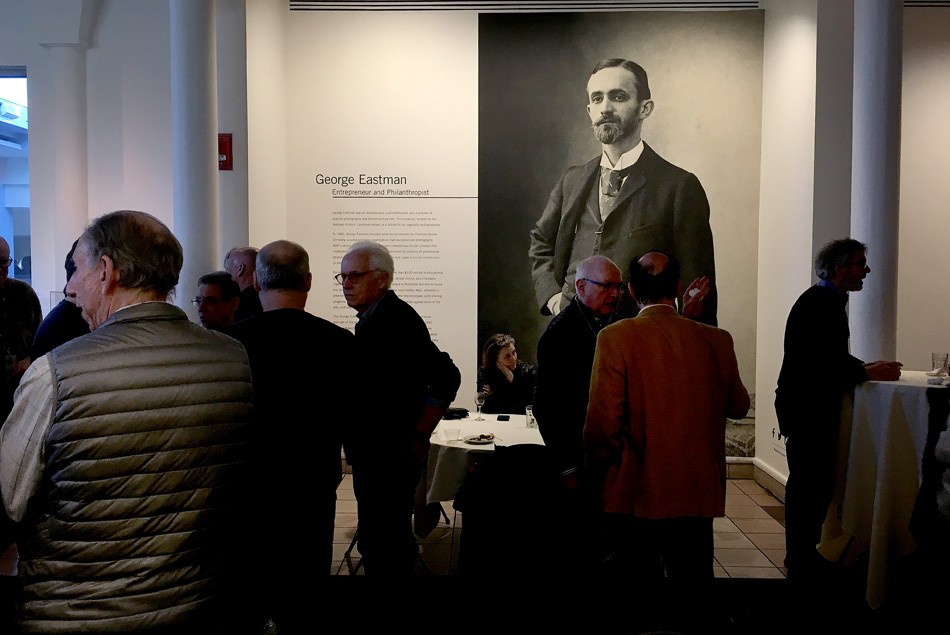 By George, Still Relevant: During a reception at the George Eastman Museum for conference attendees, a young George Eastman,(1854-1932) who founded the Eastman Kodak Company, looms larger than life in a photograph taken in 1890 by Nadar. Entrepreneur and Philanthropist are emphasized on the wall label, and with good reason. From the museum's website:"The George Eastman Museum is located in Rochester, New York, on the estate of George Eastman, the pioneer of popular photography and motion picture film. Founded in 1947 as an independent nonprofit institution, it is the world’s oldest photography museum and one of the oldest film archives. The museum holds unparalleled collections—encompassing several million objects—in the fields of photography, cinema, and photographic and cinematographic technology, and photographically illustrated books. The institution is also a longtime leader in film preservation and photographic conservation." David Spencer for PhotoSeed Archive
By George, Still Relevant: During a reception at the George Eastman Museum for conference attendees, a young George Eastman,(1854-1932) who founded the Eastman Kodak Company, looms larger than life in a photograph taken in 1890 by Nadar. Entrepreneur and Philanthropist are emphasized on the wall label, and with good reason. From the museum's website:"The George Eastman Museum is located in Rochester, New York, on the estate of George Eastman, the pioneer of popular photography and motion picture film. Founded in 1947 as an independent nonprofit institution, it is the world’s oldest photography museum and one of the oldest film archives. The museum holds unparalleled collections—encompassing several million objects—in the fields of photography, cinema, and photographic and cinematographic technology, and photographically illustrated books. The institution is also a longtime leader in film preservation and photographic conservation." David Spencer for PhotoSeed Archive
In present day Kodak city, the power of ideas relating to what made this place significant as an imaging industrial behemoth still exists, but has now gone in a new direction. With all due apologies, but the pun indeed appropriate, a snapshot of those ideas put forth by the conference attendees and speakers shows their passion for the medium’s minutiae both preserves and continues this essential democratic language. Those of memories past surely, but more and more the future in the form of ones and zeroes hurtling forward.
Although the “Big Yellow” of Rochester’s past is long gone, the ideas nourishing photography’s entire corpus continues apace, an alternate reality both present and future. For those curious enough, the RIT conference program along with a list of presenters can be found here, along with a few photos from the weekend courtesy of yours truly. David Spencer-
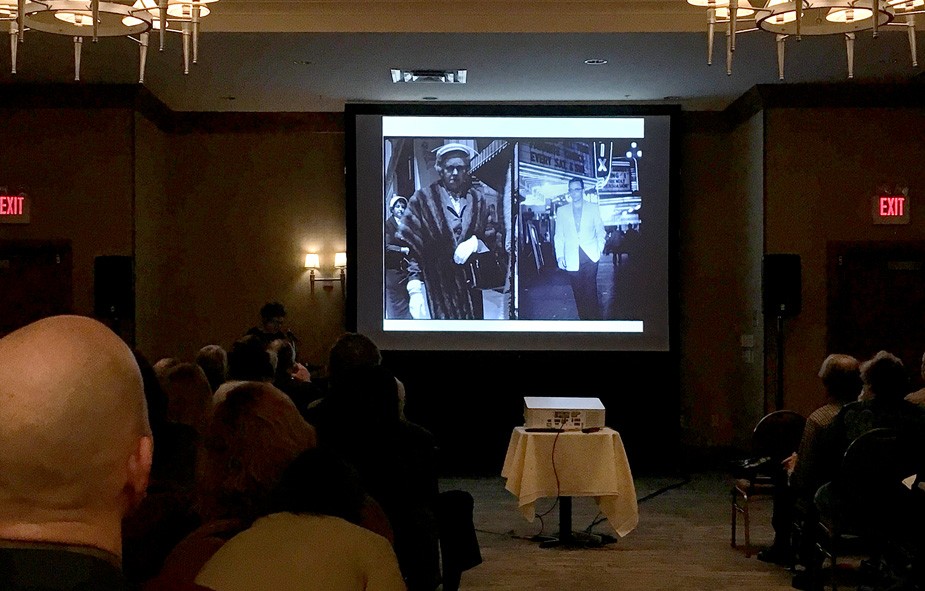 Documentary photography practiced as commerce on busy streets around the world, a genre roughly known as "Movie Snaps" because of the retrofitted movie cameras used in their making, was part of a fascinating presentation under the working title “Street Vendor Portraits Around the World: Czernowitz, Capetown, San Francisco, More!” given by independent scholar Mary Panzar of Rochester. Here, the hybrid look of Winogrand meeting Arbus becomes a document in a projected frame of a woman sporting fur and white gloves at left while a gentleman unaware at right emerges to flash and instant celebrity from a movie theatre on a nighttime street. David Spencer for PhotoSeed Archive
Documentary photography practiced as commerce on busy streets around the world, a genre roughly known as "Movie Snaps" because of the retrofitted movie cameras used in their making, was part of a fascinating presentation under the working title “Street Vendor Portraits Around the World: Czernowitz, Capetown, San Francisco, More!” given by independent scholar Mary Panzar of Rochester. Here, the hybrid look of Winogrand meeting Arbus becomes a document in a projected frame of a woman sporting fur and white gloves at left while a gentleman unaware at right emerges to flash and instant celebrity from a movie theatre on a nighttime street. David Spencer for PhotoSeed Archive
 Triptych in the Dark: Left: During his presentation “Did Talbot Make Daguerreotypes?”, the eminence of English photography pioneer William Henry Fox Talbot (1800-1877) is shown here by an image most in attendance had seen, yet Grant Romer- formerly of the Eastman House but now Founding Director of the Academy of Archaic Imaging, challenged us with another view: a decidedly unflattering profile of the paper/negative pioneer he rightly remarked might have made for a different public perception for the emerging medium had it been the lone evidence of his existence. Middle: a quote of photographic philosophy by American writer Susan Sontag (1933-2004) struck this observer as particularly relevant in the present day- University of Illinois Springfield professors Kathy Petitte Novak and Brytton Bjorngaard used it as supporting evidence while speaking on “The Blurring Distinctions of Taking versus Making Photographs: Teaching Photography in a Digital Culture”. Right: the appropriated late Victorian era reality of the dark underbelly of a small Wisconsin town through the lens of Black River Falls photographer Charles Van Schaik repurposed by author Michael Lesy in his 1973 cult classic "Wisconsin Death Trip" was supporting material for Nicolette Bromberg of the University of Washington, who argued photographic archivists need to understand context in her paper “Loss of Vision: How Art Historians and Critics Misjudge Early 20th Century Photography and How Early Photographers Along with Art Museums and Archives Help to Obscure the Photographic Record”. David Spencer for PhotoSeed Archive
Triptych in the Dark: Left: During his presentation “Did Talbot Make Daguerreotypes?”, the eminence of English photography pioneer William Henry Fox Talbot (1800-1877) is shown here by an image most in attendance had seen, yet Grant Romer- formerly of the Eastman House but now Founding Director of the Academy of Archaic Imaging, challenged us with another view: a decidedly unflattering profile of the paper/negative pioneer he rightly remarked might have made for a different public perception for the emerging medium had it been the lone evidence of his existence. Middle: a quote of photographic philosophy by American writer Susan Sontag (1933-2004) struck this observer as particularly relevant in the present day- University of Illinois Springfield professors Kathy Petitte Novak and Brytton Bjorngaard used it as supporting evidence while speaking on “The Blurring Distinctions of Taking versus Making Photographs: Teaching Photography in a Digital Culture”. Right: the appropriated late Victorian era reality of the dark underbelly of a small Wisconsin town through the lens of Black River Falls photographer Charles Van Schaik repurposed by author Michael Lesy in his 1973 cult classic "Wisconsin Death Trip" was supporting material for Nicolette Bromberg of the University of Washington, who argued photographic archivists need to understand context in her paper “Loss of Vision: How Art Historians and Critics Misjudge Early 20th Century Photography and How Early Photographers Along with Art Museums and Archives Help to Obscure the Photographic Record”. David Spencer for PhotoSeed Archive
 Photographic Preservation: With a mission statement stating they are the "world leader in the development and deployment of sustainable practices for the preservation of images and cultural heritage", conference attendees toured the Image Permanence Institute, (www.imagepermanenceinstitute.org) which opened in 1985 as an academic research laboratory within the College of Imaging Arts and Sciences at RIT. For many visitors, IPI is known for their Graphics Atlas, (www.graphicsatlas.org) an online resource that helps identify photographic and other process print types. In front of a table with various displayed print types including a row of portraits toned with Polysulfide & Selenium Toner, Institute senior research scientist Douglas Nishimura at left chats with a visitor. David Spencer for PhotoSeed Archive
Photographic Preservation: With a mission statement stating they are the "world leader in the development and deployment of sustainable practices for the preservation of images and cultural heritage", conference attendees toured the Image Permanence Institute, (www.imagepermanenceinstitute.org) which opened in 1985 as an academic research laboratory within the College of Imaging Arts and Sciences at RIT. For many visitors, IPI is known for their Graphics Atlas, (www.graphicsatlas.org) an online resource that helps identify photographic and other process print types. In front of a table with various displayed print types including a row of portraits toned with Polysulfide & Selenium Toner, Institute senior research scientist Douglas Nishimura at left chats with a visitor. David Spencer for PhotoSeed Archive
 Conference participants attended the exhibition "The Luminous Print: An Appreciation of Photogravure" organized by David Pankow, Curator Emeritus for the Cary Graphic Arts Collection at RIT now running through June 15, 2018. With beginnings in intaglio printing by artists working in the late 15th Century, photogravure's historical timeline which evolved by the 19th Century as a medium for "images from real life" is showcased by superb examples featuring plates from bound volumes, portfolios and individual works. The pleasure in real life can be seconded by this attendee, with the following observation from the catalogue true to form: "enjoy this exhibition for the beauty of its images alone and discover why it has been said that a photogravure print is endowed with a luminosity unequalled by any other process."David Spencer for PhotoSeed Archive
Conference participants attended the exhibition "The Luminous Print: An Appreciation of Photogravure" organized by David Pankow, Curator Emeritus for the Cary Graphic Arts Collection at RIT now running through June 15, 2018. With beginnings in intaglio printing by artists working in the late 15th Century, photogravure's historical timeline which evolved by the 19th Century as a medium for "images from real life" is showcased by superb examples featuring plates from bound volumes, portfolios and individual works. The pleasure in real life can be seconded by this attendee, with the following observation from the catalogue true to form: "enjoy this exhibition for the beauty of its images alone and discover why it has been said that a photogravure print is endowed with a luminosity unequalled by any other process."David Spencer for PhotoSeed Archive
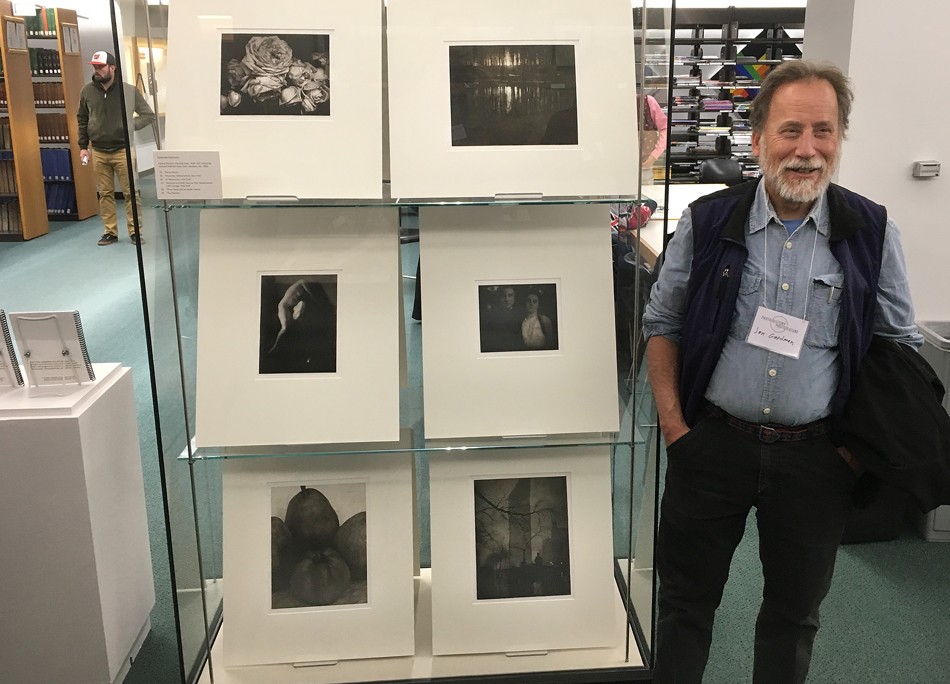 Royal Visit: As an added bonus, conference attendees viewing "The Luminous Print" could rub shoulders with Massachusetts resident Jon Goodman, a master craftsman who has worked full time since 1976 as a photogravure printer specializing in the Talbot Klic photogravure technique . Beginning in 1980 through the Photogravure Workshop, a division of the Aperture Publishing Foundation and their namesake Aperture magazine and the Paul Strand Foundation, Jon has produced sumptuous, superb, and collectable portfolios of the early work of Paul Strand, Edward Steichen, and British photography. His mission continues today in his Florence, MA atelier along with a new interest: carbon printing. Displayed are six of Jon's gravure plates featuring the pictorial work of Edward Steichen from the 1981 Aperture portfolio: "Edward Steichen; The Early Years, 1900-1927". Top to bottom left to right: "Heavy Roses", "Moonrise, Mamaroneck, New York", "In Memoriam, New York", "Steichen and Wife Clara on their Honeymoon, Lake George, New York", "Three Pears and an Apple, France", "The Flatiron". Visit jgoodgravure.com and gravureportfolios.com for more information. David Spencer for PhotoSeed Archive
Royal Visit: As an added bonus, conference attendees viewing "The Luminous Print" could rub shoulders with Massachusetts resident Jon Goodman, a master craftsman who has worked full time since 1976 as a photogravure printer specializing in the Talbot Klic photogravure technique . Beginning in 1980 through the Photogravure Workshop, a division of the Aperture Publishing Foundation and their namesake Aperture magazine and the Paul Strand Foundation, Jon has produced sumptuous, superb, and collectable portfolios of the early work of Paul Strand, Edward Steichen, and British photography. His mission continues today in his Florence, MA atelier along with a new interest: carbon printing. Displayed are six of Jon's gravure plates featuring the pictorial work of Edward Steichen from the 1981 Aperture portfolio: "Edward Steichen; The Early Years, 1900-1927". Top to bottom left to right: "Heavy Roses", "Moonrise, Mamaroneck, New York", "In Memoriam, New York", "Steichen and Wife Clara on their Honeymoon, Lake George, New York", "Three Pears and an Apple, France", "The Flatiron". Visit jgoodgravure.com and gravureportfolios.com for more information. David Spencer for PhotoSeed Archive
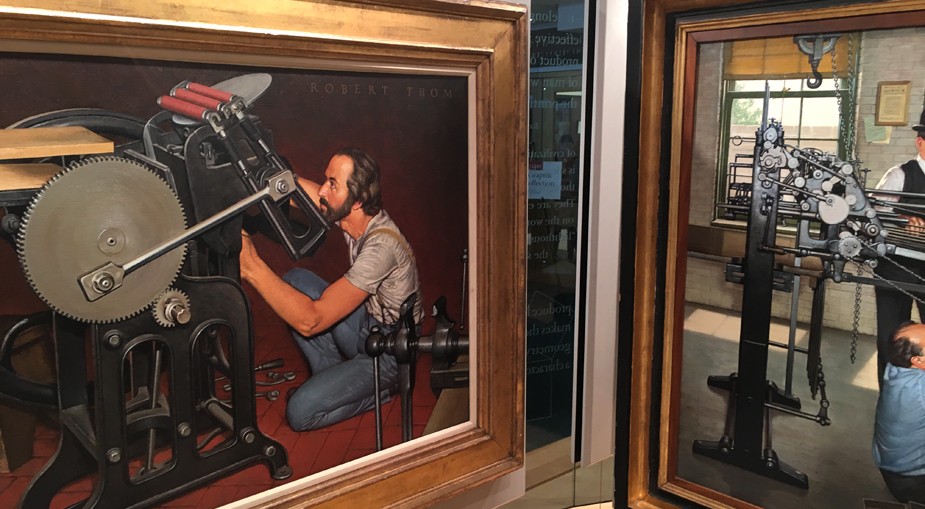 History of Printing: A series of oil paintings by three artists originally commissioned in 1966 by the Kimberly-Clark Corporation commemorating "Graphic Communications through the Ages" hangs within the offices of the RIT Press ( www.rit.edu/press/ ) and the adjoining Cary Graphic Arts Collection at The Wallace Center. This painting shows a detail of the work "George P. Gordon and the Platen Press" done by American illustrator Robert A. Thom, (1915-1979) with a detail at right by Thom: "Ira Rubel and the Offset Press". David Spencer for PhotoSeed Archive
History of Printing: A series of oil paintings by three artists originally commissioned in 1966 by the Kimberly-Clark Corporation commemorating "Graphic Communications through the Ages" hangs within the offices of the RIT Press ( www.rit.edu/press/ ) and the adjoining Cary Graphic Arts Collection at The Wallace Center. This painting shows a detail of the work "George P. Gordon and the Platen Press" done by American illustrator Robert A. Thom, (1915-1979) with a detail at right by Thom: "Ira Rubel and the Offset Press". David Spencer for PhotoSeed Archive
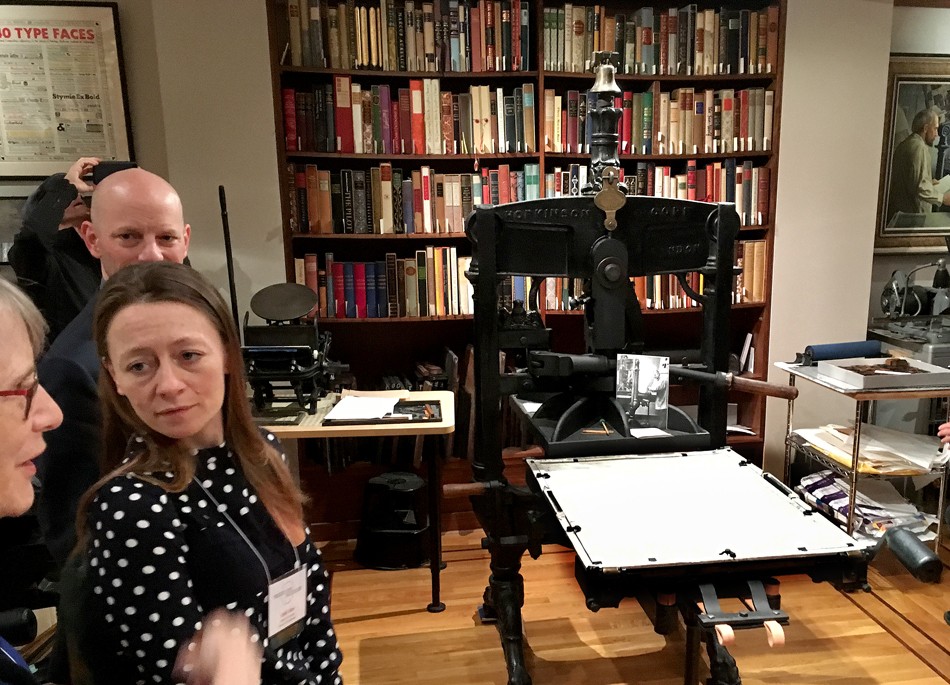 Making an Impression: Taking center stage for visitors is the famed Kelmscott/Goudy iron hand-press featured among other working presses in the Arthur M. Lowenthal Memorial Pressroom within the Cary Graphics Arts Collection at RIT. Visitors learned it was first owned by the English printer William Morris and then Frederic Goudy, two giants of the letterpress printing art. The press was built in London in 1891 by Hopkinson & Cope- an Improved Albion model (No. 6551). Now featuring around 40,000 fine and rare volumes on graphic communication history and practices, The Cary Collection is considered one of the premier libraries on the subject in the United States. ( library.rit.edu/cary ) David Spencer for PhotoSeed Archive
Making an Impression: Taking center stage for visitors is the famed Kelmscott/Goudy iron hand-press featured among other working presses in the Arthur M. Lowenthal Memorial Pressroom within the Cary Graphics Arts Collection at RIT. Visitors learned it was first owned by the English printer William Morris and then Frederic Goudy, two giants of the letterpress printing art. The press was built in London in 1891 by Hopkinson & Cope- an Improved Albion model (No. 6551). Now featuring around 40,000 fine and rare volumes on graphic communication history and practices, The Cary Collection is considered one of the premier libraries on the subject in the United States. ( library.rit.edu/cary ) David Spencer for PhotoSeed Archive
 Alternate History: The coverage by war photographer Robert Capa (1913-1954) for Life Magazine of American troops landing on Omaha Beach on D-Day during World War II was deconstructed after seven decades of public myth to facts by Staten Island, NY independent critic and historian A. D. Coleman. The first photo critic for the New York Times in 1967 and prolific author of books on photography as well as thousands of articles on the medium, Coleman presented his research during the conference titled “Deconstructing Robert Capa’s D-Day: The Unmaking of a Myth” that recently took place over three years helped by the efforts of war photographer J. Ross Baughman, Rob McElroy and Charles Herrick. As a former photojournalist myself for over three decades, I found his presentation convincing and enlightening: I still remember drying strips of film as a young photographer in large upright darkroom cabinets-the focus of some of the research when it was claimed a Life lab tech had melted Capa's film on deadline- the worst I remember was curled film! Please visit capaddayproject.com to learn more. Malcolm Gladwell, (revisionisthistory.com) are you interested? David Spencer for PhotoSeed Archive
Alternate History: The coverage by war photographer Robert Capa (1913-1954) for Life Magazine of American troops landing on Omaha Beach on D-Day during World War II was deconstructed after seven decades of public myth to facts by Staten Island, NY independent critic and historian A. D. Coleman. The first photo critic for the New York Times in 1967 and prolific author of books on photography as well as thousands of articles on the medium, Coleman presented his research during the conference titled “Deconstructing Robert Capa’s D-Day: The Unmaking of a Myth” that recently took place over three years helped by the efforts of war photographer J. Ross Baughman, Rob McElroy and Charles Herrick. As a former photojournalist myself for over three decades, I found his presentation convincing and enlightening: I still remember drying strips of film as a young photographer in large upright darkroom cabinets-the focus of some of the research when it was claimed a Life lab tech had melted Capa's film on deadline- the worst I remember was curled film! Please visit capaddayproject.com to learn more. Malcolm Gladwell, (revisionisthistory.com) are you interested? David Spencer for PhotoSeed Archive
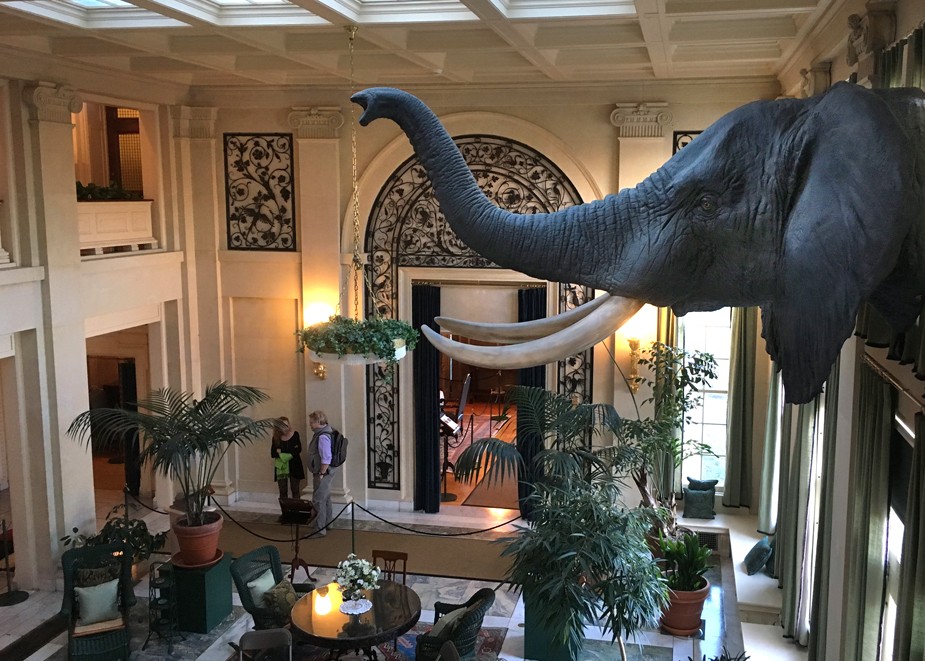 Digital Elephant in Room: Visitors to George Eastman's stately 50-room Colonial revival mansion adjoining the Eastman Museum will always remember the conservatory, where a fiberglass replica mount of an African bull elephant hangs- a conquest by the company founder during a 1928 Sudanese safari. Conveniently- and speaking of elephants in the room, I earlier had thoroughly enjoyed listening and pondering conference presenter Stephen Fletcher's talk: “The Photographic Archivist is Dead, Long Live the Photographic Archivist!”, his call to action for the task of photo archivists in the 21st Century: what do we do and how do we preserve a portion for posterity and history the digital evidence of billions and billions of photographs taken-seemingly, every day? A photographic archivist in the North Carolina collection at the University of North Carolina at Chapel Hill, Fletcher's call to arms would surely have inspired Eastman himself, a hands-on guy who is reported to have overseen every aspect of the construction of his mansion and made sure it contained all the cutting-edge technology of its' day: from the Eastman Museum website: "Beneath this exterior were modern conveniences such as an electrical generator, an internal telephone system with 21 stations, a built-in vacuum cleaning system, a central clock network, an elevator, and a great pipe organ, which made the home itself an instrument, a center of the city’s rich musical life from 1905 until Eastman’s death in 1932. Eastman was involved in every aspect of the construction, paying close attention to detail and requiring the use of high-quality materials." David Spencer for PhotoSeed Archive
Digital Elephant in Room: Visitors to George Eastman's stately 50-room Colonial revival mansion adjoining the Eastman Museum will always remember the conservatory, where a fiberglass replica mount of an African bull elephant hangs- a conquest by the company founder during a 1928 Sudanese safari. Conveniently- and speaking of elephants in the room, I earlier had thoroughly enjoyed listening and pondering conference presenter Stephen Fletcher's talk: “The Photographic Archivist is Dead, Long Live the Photographic Archivist!”, his call to action for the task of photo archivists in the 21st Century: what do we do and how do we preserve a portion for posterity and history the digital evidence of billions and billions of photographs taken-seemingly, every day? A photographic archivist in the North Carolina collection at the University of North Carolina at Chapel Hill, Fletcher's call to arms would surely have inspired Eastman himself, a hands-on guy who is reported to have overseen every aspect of the construction of his mansion and made sure it contained all the cutting-edge technology of its' day: from the Eastman Museum website: "Beneath this exterior were modern conveniences such as an electrical generator, an internal telephone system with 21 stations, a built-in vacuum cleaning system, a central clock network, an elevator, and a great pipe organ, which made the home itself an instrument, a center of the city’s rich musical life from 1905 until Eastman’s death in 1932. Eastman was involved in every aspect of the construction, paying close attention to detail and requiring the use of high-quality materials." David Spencer for PhotoSeed Archive
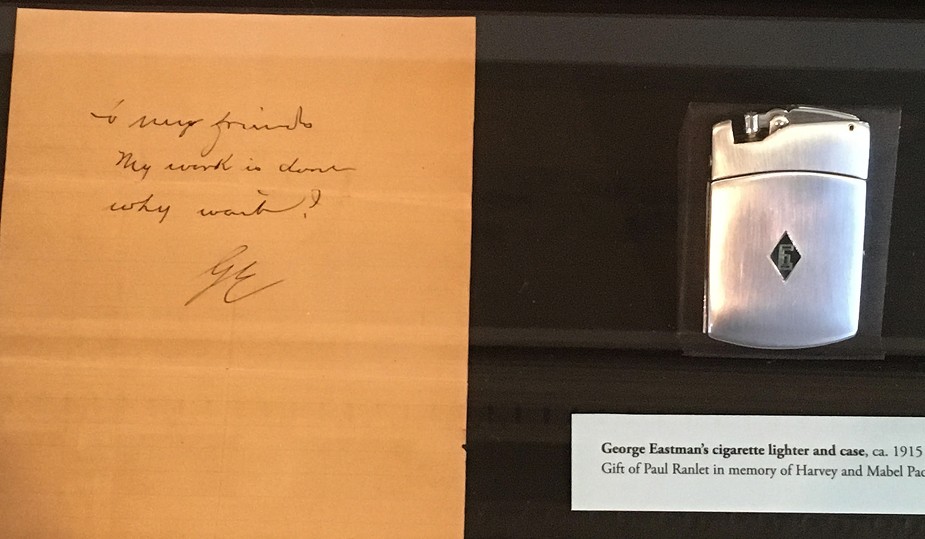 Smoking also Works: Perhaps the most startling object on display in the mansion-at least to those who do not know the intimate details of George Eastman's life- is a facsimile of his 1932 suicide note: "To my friends - My work is done - why wait? GE." Suppressed initially by the Eastman Kodak Company for decades, this news is sobering but important. Eastman had been crippled by a degenerative spinal disease and unable to walk, he shot himself through the heart in his upstairs bedroom. A music lover even after the end, a 1990 New York Times story on the renovation of the mansion noted he "requested a rousing ''Marche Romaine'' by Charles Gounod be played at his funeral". David Spencer for PhotoSeed Archive
Smoking also Works: Perhaps the most startling object on display in the mansion-at least to those who do not know the intimate details of George Eastman's life- is a facsimile of his 1932 suicide note: "To my friends - My work is done - why wait? GE." Suppressed initially by the Eastman Kodak Company for decades, this news is sobering but important. Eastman had been crippled by a degenerative spinal disease and unable to walk, he shot himself through the heart in his upstairs bedroom. A music lover even after the end, a 1990 New York Times story on the renovation of the mansion noted he "requested a rousing ''Marche Romaine'' by Charles Gounod be played at his funeral". David Spencer for PhotoSeed Archive
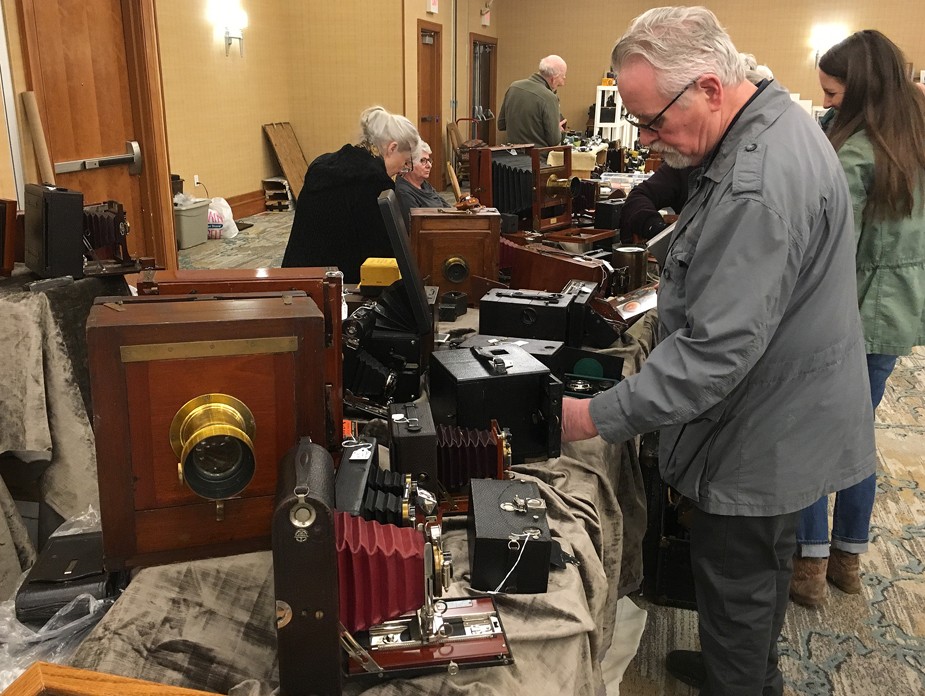 Fancy Box with Hole in It: Collectors and the curious had the opportunity to peruse the physical evidence of the history of photography during the concluding event of the conference, an antiquarian photography show and sale featuring 80 tables of wares including these vintage wooden box and Kodak cameras. Earlier, the RIT Press and Syracuse University Press showed off their latest offerings, including some wonderful photography volumes during the event. David Spencer for PhotoSeed Archive
Fancy Box with Hole in It: Collectors and the curious had the opportunity to peruse the physical evidence of the history of photography during the concluding event of the conference, an antiquarian photography show and sale featuring 80 tables of wares including these vintage wooden box and Kodak cameras. Earlier, the RIT Press and Syracuse University Press showed off their latest offerings, including some wonderful photography volumes during the event. David Spencer for PhotoSeed Archive
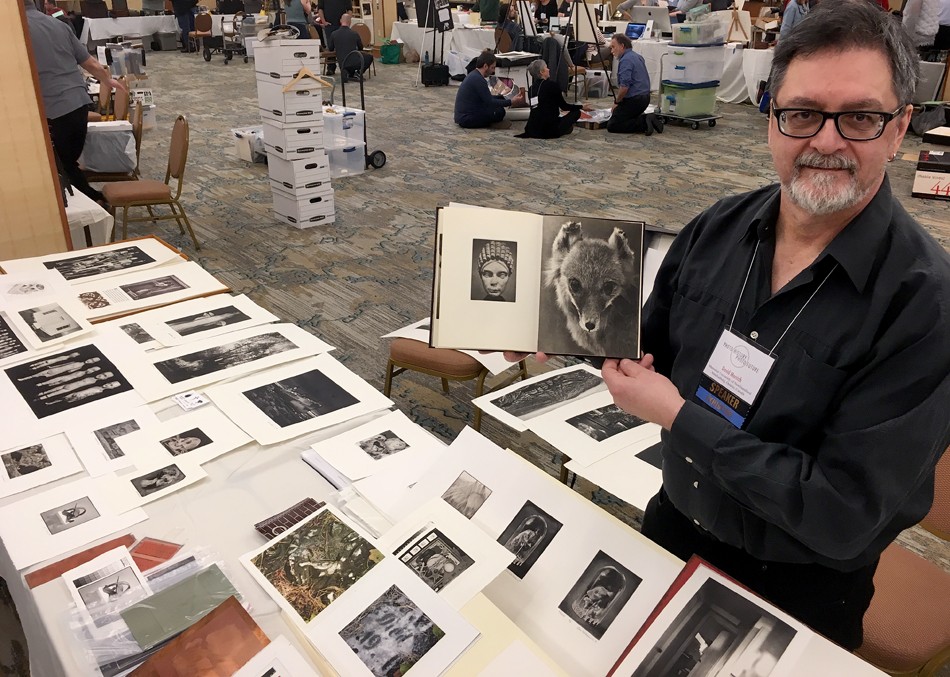 Learned from Jon Goodman: During the antiquarian photography show and sale, Ontario-based visual artist David Morrish, co-author along with Marlene MacCallum of the 2003 volume "Copper Plate Photogravure: Demystifying the Process", shows off a page spread of original photogravures from his 2004 Deadcat Press imprint "Gaze" he was selling along with other work during the antiquarian photography show and sale. Earlier in the conference, Morrish and visual artist MacCallum, former professor in the Visual Arts Program at Memorial University of Newfoundland, presented on "Photogravure: Then and Now" highlighting the gravure process while showing how the medium’s ongoing relevance to contemporary art practice has influenced their own work in the production of print suites and artists’ books. Learn more at marlenemaccallum.com and davidmorrish.com. David Spencer for PhotoSeed Archive
Learned from Jon Goodman: During the antiquarian photography show and sale, Ontario-based visual artist David Morrish, co-author along with Marlene MacCallum of the 2003 volume "Copper Plate Photogravure: Demystifying the Process", shows off a page spread of original photogravures from his 2004 Deadcat Press imprint "Gaze" he was selling along with other work during the antiquarian photography show and sale. Earlier in the conference, Morrish and visual artist MacCallum, former professor in the Visual Arts Program at Memorial University of Newfoundland, presented on "Photogravure: Then and Now" highlighting the gravure process while showing how the medium’s ongoing relevance to contemporary art practice has influenced their own work in the production of print suites and artists’ books. Learn more at marlenemaccallum.com and davidmorrish.com. David Spencer for PhotoSeed Archive
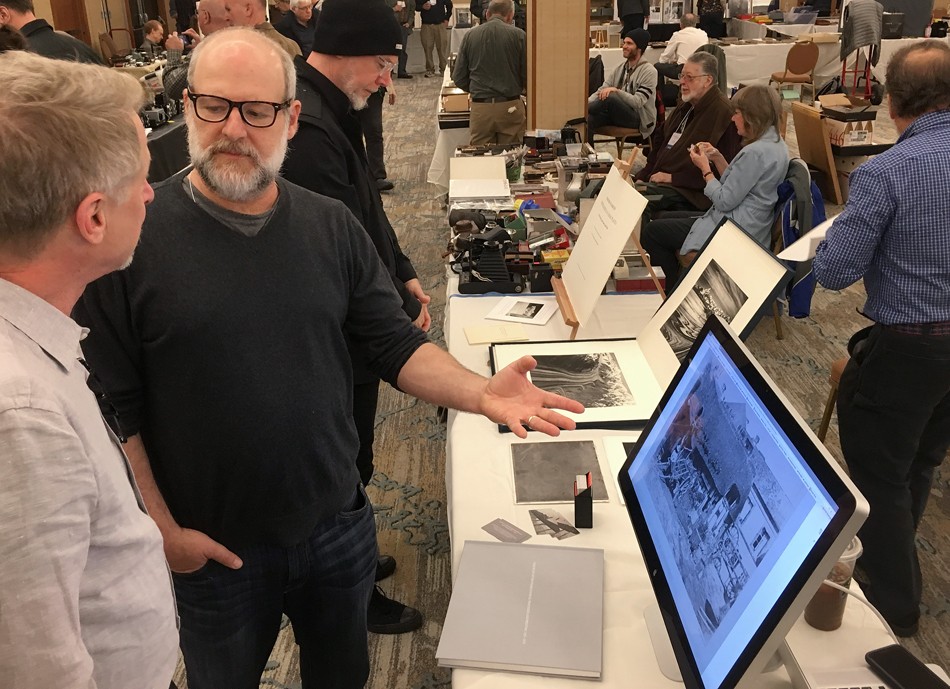 Future with a Past: St. Louis resident and commercial photographer Mark Katzman, the key force in proselytizing for the medium and beauty of hand-pulled photogravure worldwide through his website Photogravure.com, speaks with conference speaker Jeff Rosen during the antiquarian photography show and sale. Curious to learn what a real photogravure is, unlike the many who simply use the term-wrongly-to sell you something not what they claim? Head over to his newly redesigned site, where the mission statement is: "Peeling back a layer of the history of photography, this site examines the role that photogravure has played in shaping our shared visual experience. Through exploring thousands of examples, we learn about the relentless and ambitious 19th century pursuit to reproduce photographs in ink and discover the exquisite, sublime process that resulted. It is our hope that this site firmly establishes photogravure as not only one of the most under-recognized photographic processes, but also an important and beautiful art." David Spencer for PhotoSeed Archive
Future with a Past: St. Louis resident and commercial photographer Mark Katzman, the key force in proselytizing for the medium and beauty of hand-pulled photogravure worldwide through his website Photogravure.com, speaks with conference speaker Jeff Rosen during the antiquarian photography show and sale. Curious to learn what a real photogravure is, unlike the many who simply use the term-wrongly-to sell you something not what they claim? Head over to his newly redesigned site, where the mission statement is: "Peeling back a layer of the history of photography, this site examines the role that photogravure has played in shaping our shared visual experience. Through exploring thousands of examples, we learn about the relentless and ambitious 19th century pursuit to reproduce photographs in ink and discover the exquisite, sublime process that resulted. It is our hope that this site firmly establishes photogravure as not only one of the most under-recognized photographic processes, but also an important and beautiful art." David Spencer for PhotoSeed Archive
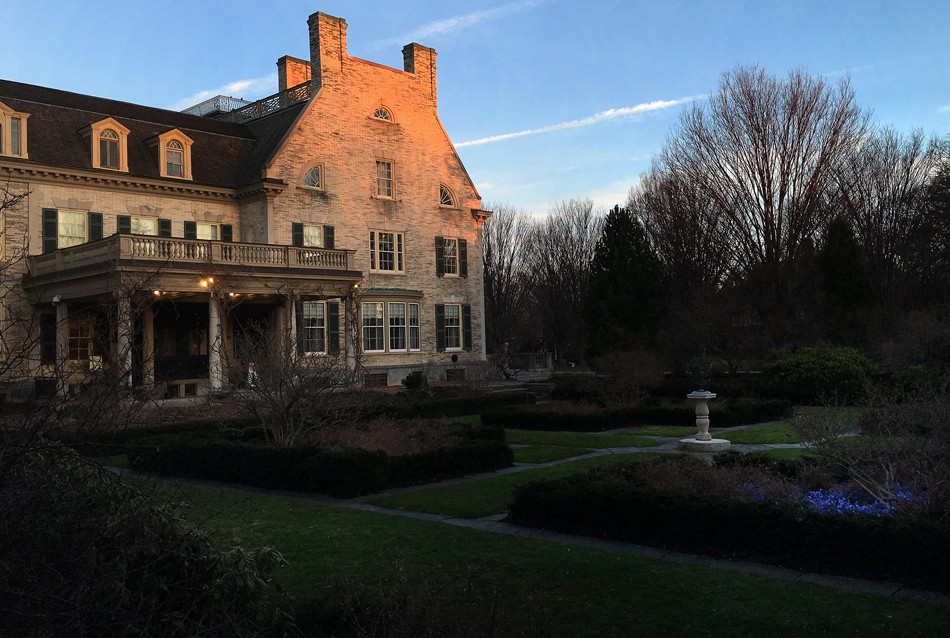 Keeper of Memories: Located at 900 East Ave. in Rochester, New York, the George Eastman Museum, along with a section of his original mansion and gardens on 8.5 acres constructed beginning in 1902, is a grand American repository for the study of photography past, present and future. Besides a growing archive of over 400,000 photographic objects spanning the history of the medium, the museum also features 16,000 + examples of photographic and cinematographic technology- the world's largest. For those interested in the printed legacy, the accessible Richard and Ronay Menschel Library is also onsite, with a special collections and archive division housing "manuscripts, papers, and ephemera, including those of Alvin Langdon Coburn, Lewis W. Hine, Southworth and Hawes, and Edward Steichen, among other photographers, collectors, and inventors." Curious? eastman.org. David Spencer for PhotoSeed Archive
Keeper of Memories: Located at 900 East Ave. in Rochester, New York, the George Eastman Museum, along with a section of his original mansion and gardens on 8.5 acres constructed beginning in 1902, is a grand American repository for the study of photography past, present and future. Besides a growing archive of over 400,000 photographic objects spanning the history of the medium, the museum also features 16,000 + examples of photographic and cinematographic technology- the world's largest. For those interested in the printed legacy, the accessible Richard and Ronay Menschel Library is also onsite, with a special collections and archive division housing "manuscripts, papers, and ephemera, including those of Alvin Langdon Coburn, Lewis W. Hine, Southworth and Hawes, and Edward Steichen, among other photographers, collectors, and inventors." Curious? eastman.org. David Spencer for PhotoSeed Archive
Christmas Number Cover
Posted December 2017 in Exhibitions
Merry Christmas!
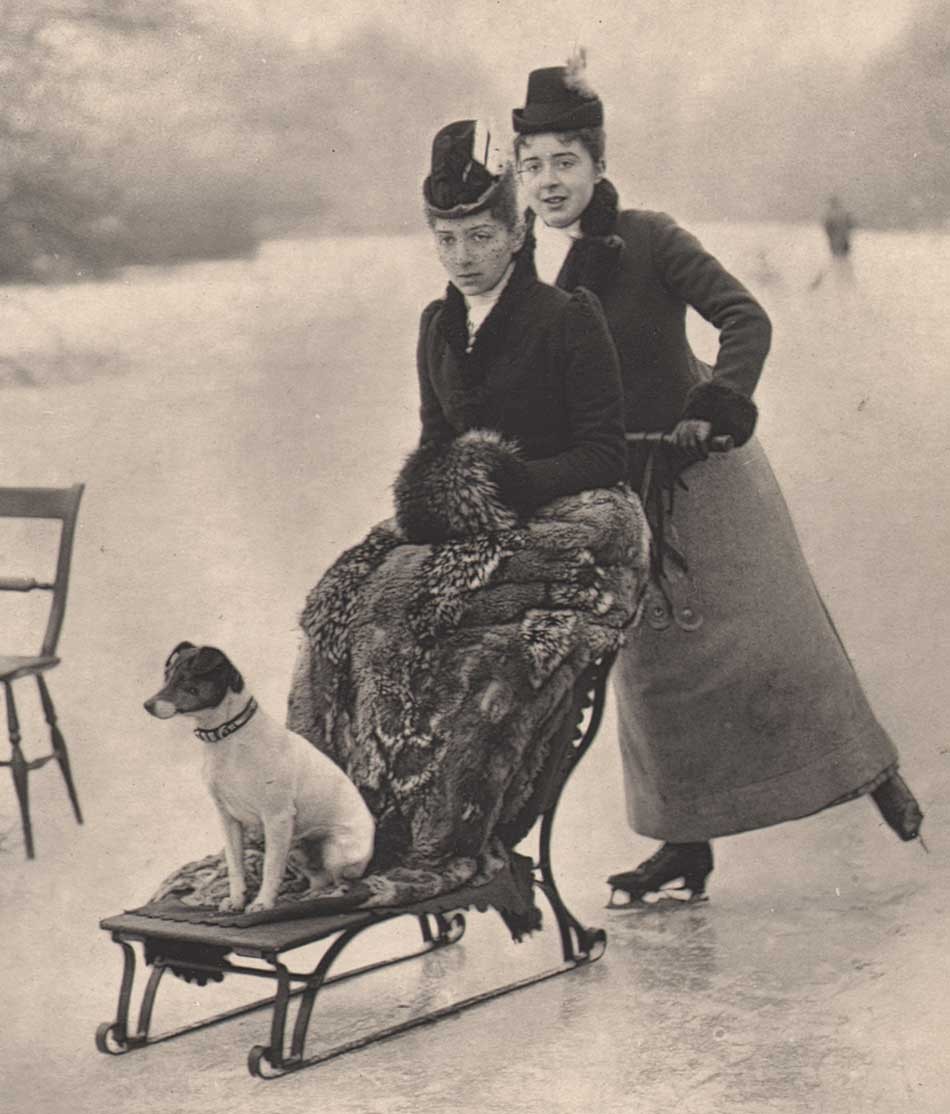 Detail: "An Old-fashioned Winter": Henry Stevens, (1843-1925) 1892, English, Woodbury Gravure: 18.3 x 12.8 | 39.0 x 28.3 cm. Vintage plate from salon portfolio: "Photographs of The Year. Descriptive Notes and Critical review of The Photographic Society's Exhibition, 1891, by H.P. Robinson." Published in their salon catalogue by the Photographic Society of Great Britain, Robinson comments on this photograph originally taken in 1890 from the letterpress, which features the photographer's pet Jack Russell terrier at the front of the sleigh: …This delightful sleighing picture is good enough to make the success of the Christmas number of any illustrated paper, and we are pleased to give a reproduction of it. There is life and motion; the sleigh flies over the snow; the young lady behind, on skates, moves; and the dog in front thinks it is all done for his enjoyment. We may perhaps venture to congratulate the artist on having such charming models in his daughters." From: PhotoSeed Archive
Detail: "An Old-fashioned Winter": Henry Stevens, (1843-1925) 1892, English, Woodbury Gravure: 18.3 x 12.8 | 39.0 x 28.3 cm. Vintage plate from salon portfolio: "Photographs of The Year. Descriptive Notes and Critical review of The Photographic Society's Exhibition, 1891, by H.P. Robinson." Published in their salon catalogue by the Photographic Society of Great Britain, Robinson comments on this photograph originally taken in 1890 from the letterpress, which features the photographer's pet Jack Russell terrier at the front of the sleigh: …This delightful sleighing picture is good enough to make the success of the Christmas number of any illustrated paper, and we are pleased to give a reproduction of it. There is life and motion; the sleigh flies over the snow; the young lady behind, on skates, moves; and the dog in front thinks it is all done for his enjoyment. We may perhaps venture to congratulate the artist on having such charming models in his daughters." From: PhotoSeed ArchiveNow Playing: White's World
Posted October 2017 in Exhibitions, History of Photography, Significant Photographers
The following are a few snaps from my recent attendance at the symposium: Rethinking “Pictorialism” held in conjunction with the exhibition now playing at the Princeton University Art Museum in New Jersey: Clarence H. White and His World: The Art & Craft of Photography, 1895-1925. On exhibit at Princeton through January 7, 2018, the show will then travel to the Davis Museum at Wellesley College (MA) from 02-07-18 to 06-03-18; The Portland Museum of Art in Maine from 06-30-18 to 09-16-18 and the Cleveland Museum of Art in OH from 10-21-18 to 01-21-19.
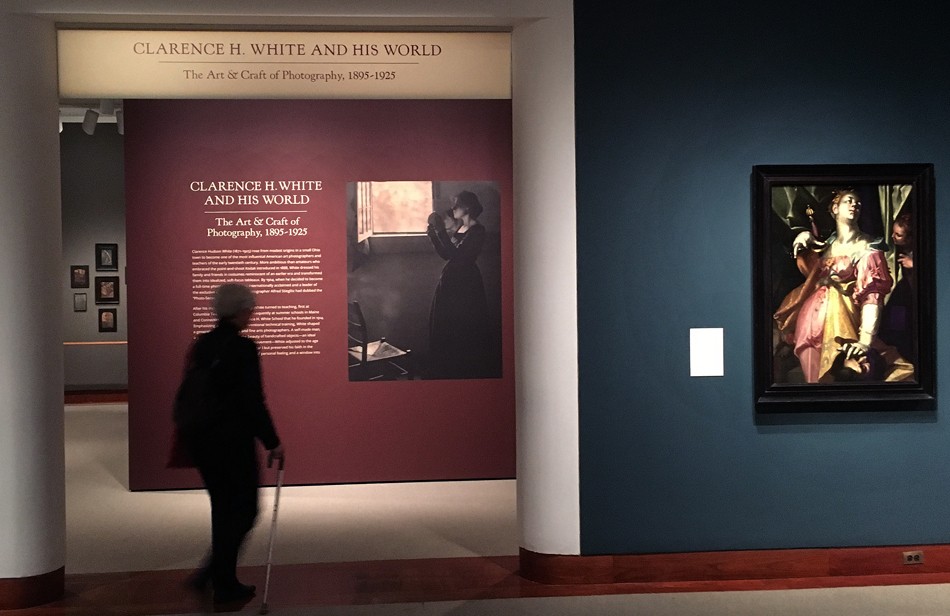 A visitor enters the exhibit "Clarence H. White and His World: The Art & Craft of Photography, 1895-1925" at the Princeton University Art Museum during the October, 2017 weekend in which a symposium devoted to Rethinking "Pictorialism" in context with White's work and those of his contemporaries was discussed. Photo by David Spencer for PhotoSeed Archive.
A visitor enters the exhibit "Clarence H. White and His World: The Art & Craft of Photography, 1895-1925" at the Princeton University Art Museum during the October, 2017 weekend in which a symposium devoted to Rethinking "Pictorialism" in context with White's work and those of his contemporaries was discussed. Photo by David Spencer for PhotoSeed Archive.
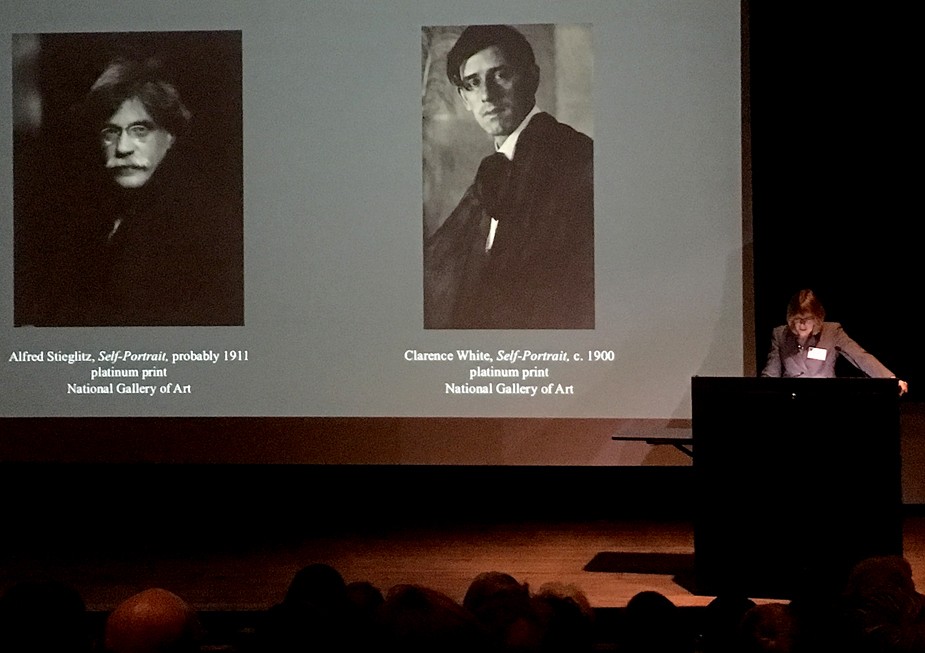 Two men from two very distinct photographic worlds: Seen at center ca. 1900 at around 25 years of age, Clarence H. White, with hair slightly unkempt as befitting one whose energies were certainly taxed for familial obligations combined with lofty personal ambitions related to the nascent field of art photography, (and the necessity of keeping his day job) was compared with a mentor at left: Alfred Stieglitz, during a symposium paper. Sarah Greenough, far right, senior curator and head of the department of photographs at the National Gallery of Art in Washington, D.C., compared both as part of her keynote address: Alfred Stieglitz, 291, and the Nursery of Genius: 100 Years Later. The symposium- Rethinking "Pictorialism" American Art and Photography, 1895 to 1925, was held at Princeton University on October 20-21, 2017 in conjunction with the in-progress exhibition on Clarence White at the University art museum. Photo by David Spencer for PhotoSeed Archive.
Two men from two very distinct photographic worlds: Seen at center ca. 1900 at around 25 years of age, Clarence H. White, with hair slightly unkempt as befitting one whose energies were certainly taxed for familial obligations combined with lofty personal ambitions related to the nascent field of art photography, (and the necessity of keeping his day job) was compared with a mentor at left: Alfred Stieglitz, during a symposium paper. Sarah Greenough, far right, senior curator and head of the department of photographs at the National Gallery of Art in Washington, D.C., compared both as part of her keynote address: Alfred Stieglitz, 291, and the Nursery of Genius: 100 Years Later. The symposium- Rethinking "Pictorialism" American Art and Photography, 1895 to 1925, was held at Princeton University on October 20-21, 2017 in conjunction with the in-progress exhibition on Clarence White at the University art museum. Photo by David Spencer for PhotoSeed Archive.
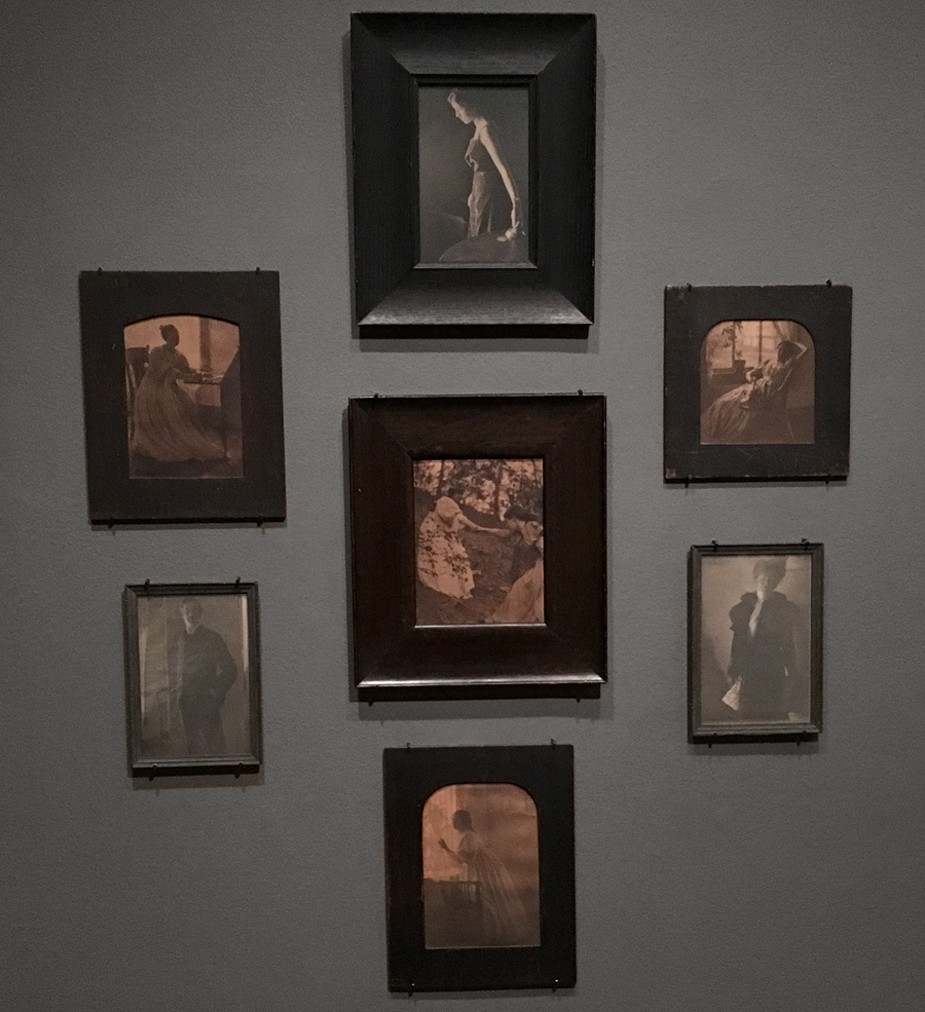 A wall grouping of original Clarence H. White photographs in their original wood frames are on display as part of the exhibit: "Clarence H. White and His World: The Art & Craft of Photography, 1895-1925" now at the Princeton University Museum of Art through early 2018. An excerpt of the wall label: "These photographs are among the few pictorialist works from the late 1890s that survive in their original exhibition frames. Photo by David Spencer for PhotoSeed Archive
A wall grouping of original Clarence H. White photographs in their original wood frames are on display as part of the exhibit: "Clarence H. White and His World: The Art & Craft of Photography, 1895-1925" now at the Princeton University Museum of Art through early 2018. An excerpt of the wall label: "These photographs are among the few pictorialist works from the late 1890s that survive in their original exhibition frames. Photo by David Spencer for PhotoSeed Archive
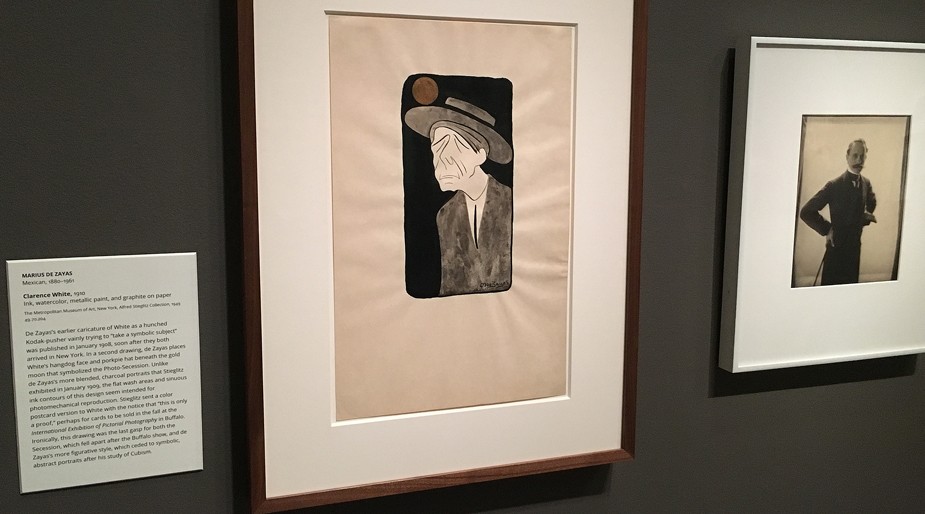 A caricature drawing of Clarence White done in 1910 by Mexican artist Marius De Zayas (1880-1961) is included in the exhibit on loan from the Metropolitan Museum of Art. Accompanied by a vintage portrait of the artist by White at far right, an excerpt from the wall caption reveals: "…de Zayas places White's hangdog face and porkpie hat beneath the gold moon that symbolized the Photo-Secession. Unlike de Zayas's more blended, charcoal portraits that Stieglitz exhibited in January 1909, the flat wash areas and sinuous ink contours of this design seem intended for photomechanical reproduction." Note: caricature drawings by the artist appeared in the journal Camera Work XXIX in 1910 and CW XLVI in 1914. Photo by David Spencer for PhotoSeed Archive.
A caricature drawing of Clarence White done in 1910 by Mexican artist Marius De Zayas (1880-1961) is included in the exhibit on loan from the Metropolitan Museum of Art. Accompanied by a vintage portrait of the artist by White at far right, an excerpt from the wall caption reveals: "…de Zayas places White's hangdog face and porkpie hat beneath the gold moon that symbolized the Photo-Secession. Unlike de Zayas's more blended, charcoal portraits that Stieglitz exhibited in January 1909, the flat wash areas and sinuous ink contours of this design seem intended for photomechanical reproduction." Note: caricature drawings by the artist appeared in the journal Camera Work XXIX in 1910 and CW XLVI in 1914. Photo by David Spencer for PhotoSeed Archive.
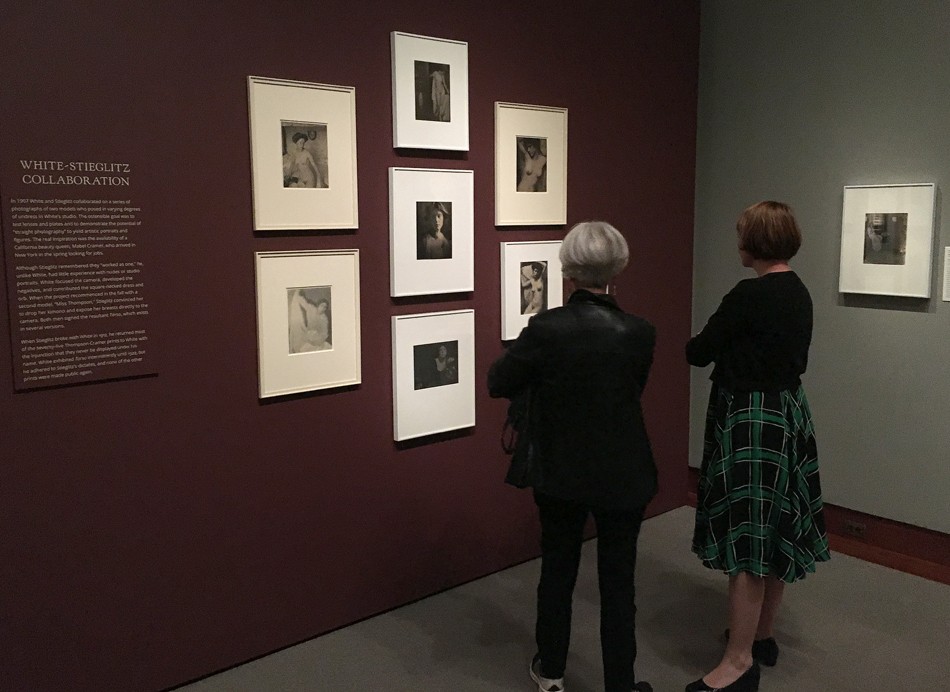 Visitors take in a select grouping of vintage photographs taken in 1907 by Clarence H. White and Alfred Stieglitz in White's New York City studio that are part of the exhibit "Clarence H. White and His World: The art & Craft of Photography, 1895-1925" now at the Princeton University Museum of Art. An excerpt from the wall label: "In 1907 White and Stieglitz collaborated on a series of photographs of two models who posed in varying degrees of undress in White's studio. The ostensible goal was to test lenses and plates and to demonstrate the potential of "straight photography" to yield artistic portraits and figures. The real inspiration was the availability of a California beauty queen, Mabel Cramer, who arrived in New York in the spring looking for jobs." Photo by David Spencer for PhotoSeed Archive.
Visitors take in a select grouping of vintage photographs taken in 1907 by Clarence H. White and Alfred Stieglitz in White's New York City studio that are part of the exhibit "Clarence H. White and His World: The art & Craft of Photography, 1895-1925" now at the Princeton University Museum of Art. An excerpt from the wall label: "In 1907 White and Stieglitz collaborated on a series of photographs of two models who posed in varying degrees of undress in White's studio. The ostensible goal was to test lenses and plates and to demonstrate the potential of "straight photography" to yield artistic portraits and figures. The real inspiration was the availability of a California beauty queen, Mabel Cramer, who arrived in New York in the spring looking for jobs." Photo by David Spencer for PhotoSeed Archive.
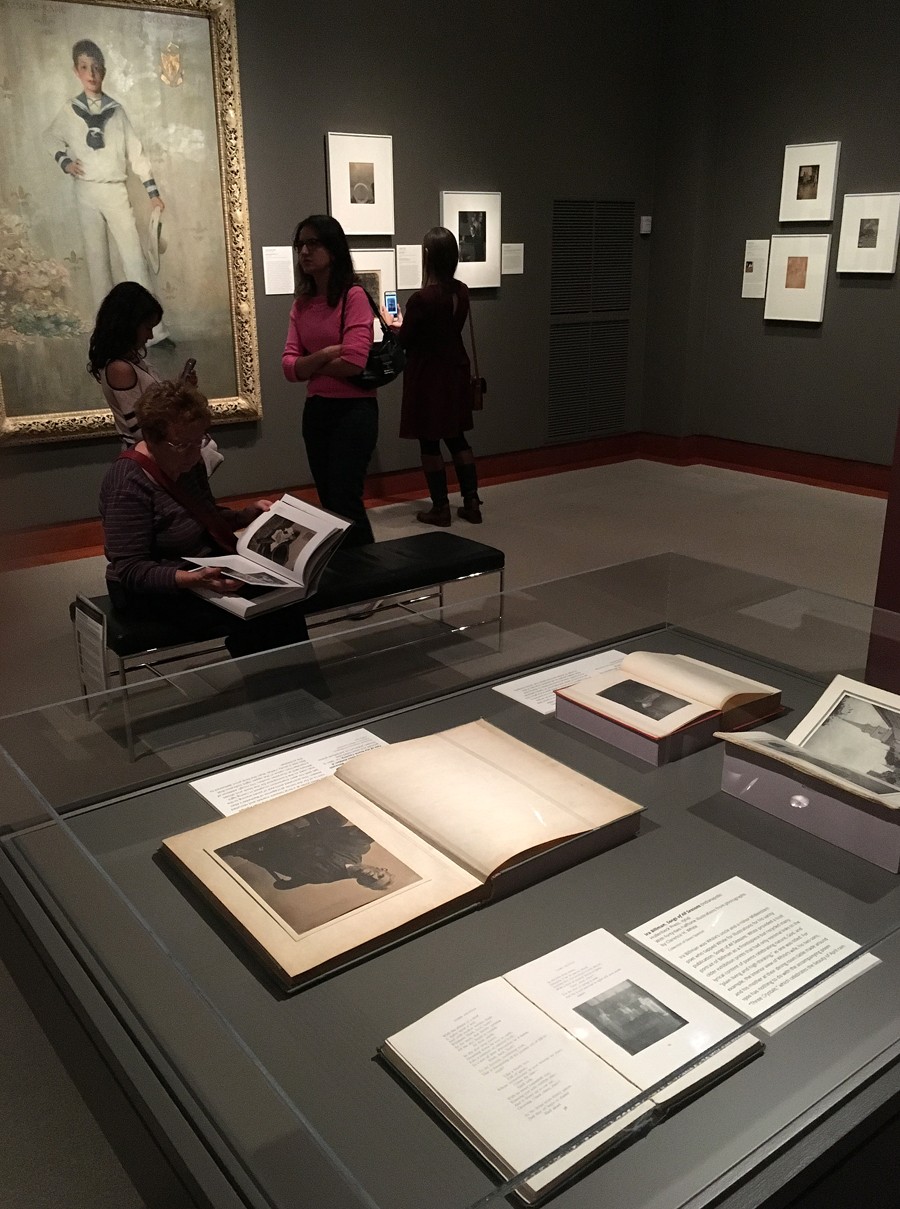 In one exhibit gallery, a display case seen at bottom contains examples of Clarence White's published work. In the early 20th Century, his interest in commercial illustration lent itself to the publication of several articles as well as volumes featuring staged genre photographs, including a photogravure-illustrated edition of the best-selling Irving Bacheller novel Eben Holden published by the Lothrop in 1903 and Songs of All Seasons in 1904. The latter volume, lent by this website for the exhibit and written by White's uncle Ira Billman contained the following label excerpt: "White provided a bust portrait of Billman as a frontispiece but recycled many older exhibition prints that had only minimal links to the lyrical content of poems celebrating nature, God, and "Plain living and high thinking," as one was titled." On another label, for a bound collection of work prints for Eben Holden and the article "Beneath the Wrinkle", we learn White recruited a bearded gent named John Miles Jones at a Newark, Oh market who served as the "heroic protagonist of Bacheller's Eben Holden". (seen at far left at frame bottom) Photo by David Spencer for PhotoSeed Archive.
In one exhibit gallery, a display case seen at bottom contains examples of Clarence White's published work. In the early 20th Century, his interest in commercial illustration lent itself to the publication of several articles as well as volumes featuring staged genre photographs, including a photogravure-illustrated edition of the best-selling Irving Bacheller novel Eben Holden published by the Lothrop in 1903 and Songs of All Seasons in 1904. The latter volume, lent by this website for the exhibit and written by White's uncle Ira Billman contained the following label excerpt: "White provided a bust portrait of Billman as a frontispiece but recycled many older exhibition prints that had only minimal links to the lyrical content of poems celebrating nature, God, and "Plain living and high thinking," as one was titled." On another label, for a bound collection of work prints for Eben Holden and the article "Beneath the Wrinkle", we learn White recruited a bearded gent named John Miles Jones at a Newark, Oh market who served as the "heroic protagonist of Bacheller's Eben Holden". (seen at far left at frame bottom) Photo by David Spencer for PhotoSeed Archive.
 Perhaps Clarence White's greatest legacy was his teaching career. On the exhibit wall at center, a portrait of the American painter Arthur Wesley Dow taken by White around 1908 is shown with an original painting by Dow at far left showing the influence of Japanese design. White’s transition from Newark to New York City in 1906 began a new chapter of teaching by the photographer, who soon made the acquaintance of artist and arts educator Arthur Wesley Dow, (1857-1922) who hired White as an instructor at Columbia University’s Teachers College in 1907. White would go on to found his own groundbreaking schools of artistic photography utilizing a modern pedagogy learned from Dow among others: first in Maine beginning in 1910 and then in New York City in 1914. Photo by David Spencer for PhotoSeed Archive.
Perhaps Clarence White's greatest legacy was his teaching career. On the exhibit wall at center, a portrait of the American painter Arthur Wesley Dow taken by White around 1908 is shown with an original painting by Dow at far left showing the influence of Japanese design. White’s transition from Newark to New York City in 1906 began a new chapter of teaching by the photographer, who soon made the acquaintance of artist and arts educator Arthur Wesley Dow, (1857-1922) who hired White as an instructor at Columbia University’s Teachers College in 1907. White would go on to found his own groundbreaking schools of artistic photography utilizing a modern pedagogy learned from Dow among others: first in Maine beginning in 1910 and then in New York City in 1914. Photo by David Spencer for PhotoSeed Archive.
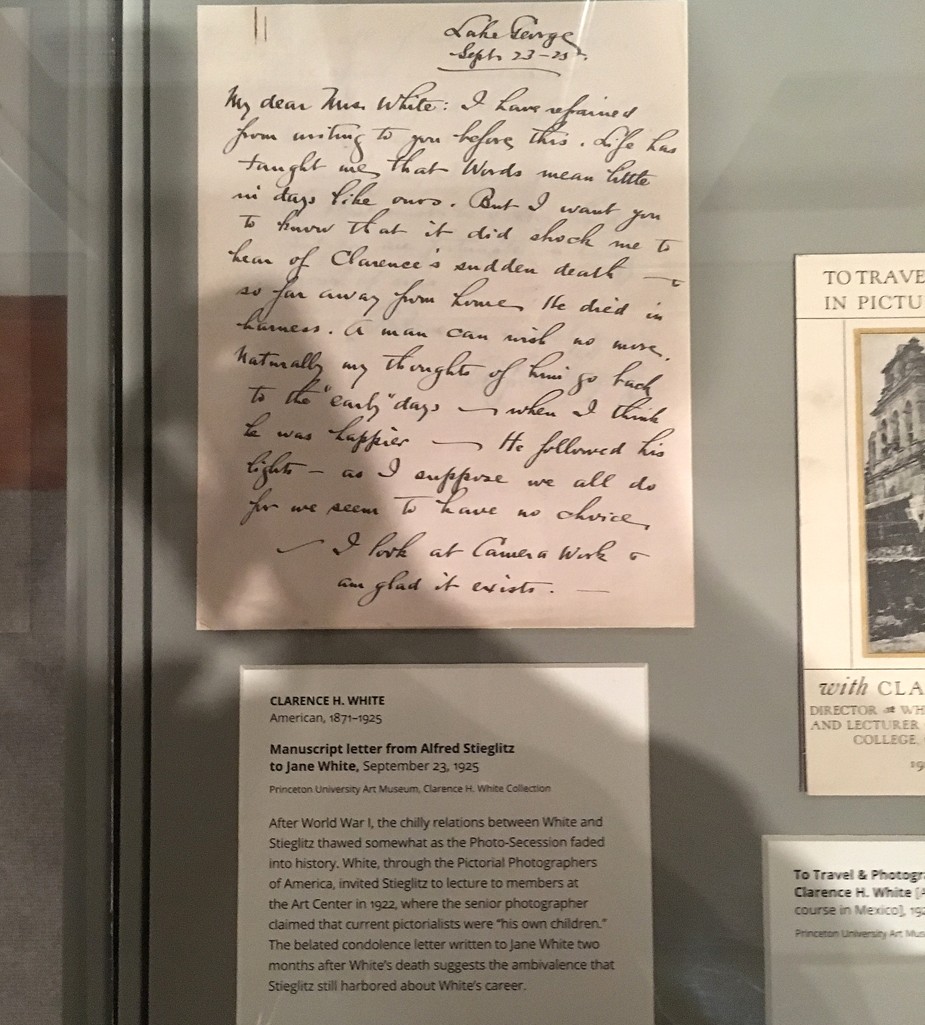 In the final gallery exhibition display case, an original letter to Clarence White's widow Jane White by Alfred Stieglitz is displayed, with this modern-day reader struck by the author's self importance revealed in the letter's conclusion at an inopportune time: writing from Lake George, New York, the elder statesman of American pictorial photography pens a belated note of condolence dated September 25, 1923: "My dear Mrs. White: I have refrained from writing to you before this. Life has taught me that words mean little in days like ours. But I want you to know that it did shock me to hear of Clarence's sudden death-so far away from home. He died in harness. A man can wish no more. Naturally my thoughts of him go back to the "early" days- when I think he was happier- He followed his lights-as I suppose we all do for we seem to have no choice. - I look at Camera Work & am glad it exists. - Photo by David Spencer for PhotoSeed Archive.
In the final gallery exhibition display case, an original letter to Clarence White's widow Jane White by Alfred Stieglitz is displayed, with this modern-day reader struck by the author's self importance revealed in the letter's conclusion at an inopportune time: writing from Lake George, New York, the elder statesman of American pictorial photography pens a belated note of condolence dated September 25, 1923: "My dear Mrs. White: I have refrained from writing to you before this. Life has taught me that words mean little in days like ours. But I want you to know that it did shock me to hear of Clarence's sudden death-so far away from home. He died in harness. A man can wish no more. Naturally my thoughts of him go back to the "early" days- when I think he was happier- He followed his lights-as I suppose we all do for we seem to have no choice. - I look at Camera Work & am glad it exists. - Photo by David Spencer for PhotoSeed Archive.
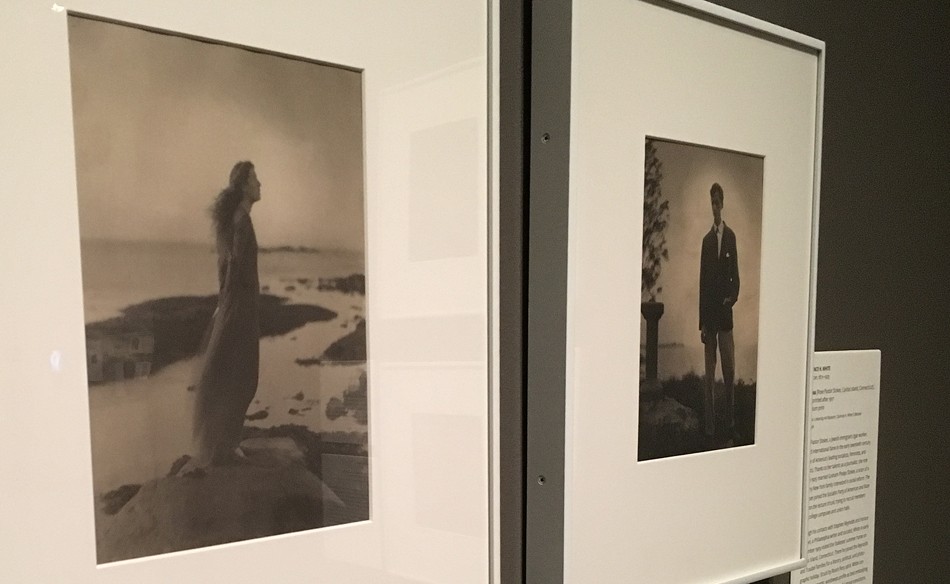 The exhibit features marvelous images by Clarence White held in the Clarence H. White Collection at the Princeton University Art Museum, like this stunning full-length portrait titled The Sea taken of socialist, feminist and activist Rose Pastor Stokes in 1909 and printed after 1917 as a Palladium print. A committed socialist himself, White photographed Stokes during a visit to her and husband Graham Phelps Stokes (portrait of him at far right of frame by White) summer home on Caritas Island, CT. A label excerpt: "Struck by Rose's fiery spirit, White conceived this romantic, windswept profile as best embodying her fierce independence and powerful moral convictions." Note: this portrait used as the cover illustration for the exhibit's accompanying monograph volume. Photo by David Spencer for PhotoSeed Archive.
The exhibit features marvelous images by Clarence White held in the Clarence H. White Collection at the Princeton University Art Museum, like this stunning full-length portrait titled The Sea taken of socialist, feminist and activist Rose Pastor Stokes in 1909 and printed after 1917 as a Palladium print. A committed socialist himself, White photographed Stokes during a visit to her and husband Graham Phelps Stokes (portrait of him at far right of frame by White) summer home on Caritas Island, CT. A label excerpt: "Struck by Rose's fiery spirit, White conceived this romantic, windswept profile as best embodying her fierce independence and powerful moral convictions." Note: this portrait used as the cover illustration for the exhibit's accompanying monograph volume. Photo by David Spencer for PhotoSeed Archive.
A Reevaluation: Clarence H. White
Posted October 2017 in Exhibitions, History of Photography, Painters|Photographers, Publishing, Significant Photographers
 "Clarence H. White Autograph": Black ink, 1916. By his own hand, White autographed a manilla card-stock mount (36.2 x 28.6 cm) featuring a portrait photograph of himself taken by student Ruth Anthony Davis during the Seventh Summer Session of the School of Photography at Stevens Farm in East Canaan, CT that year. Please see portrait below. From: PhotoSeed Archive
"Clarence H. White Autograph": Black ink, 1916. By his own hand, White autographed a manilla card-stock mount (36.2 x 28.6 cm) featuring a portrait photograph of himself taken by student Ruth Anthony Davis during the Seventh Summer Session of the School of Photography at Stevens Farm in East Canaan, CT that year. Please see portrait below. From: PhotoSeed Archive
When I remarried a dozen years ago, an obscure bit of farce entered the equation leading up to the “I do” moment. The fateful convolution? My beloved hailed from Newark, OH: the same Midwestern US city where pioneering art photographer Clarence Hudson White (1871-1925) had spent his formative years before leaving permanently along with his family to New York City in 1906.
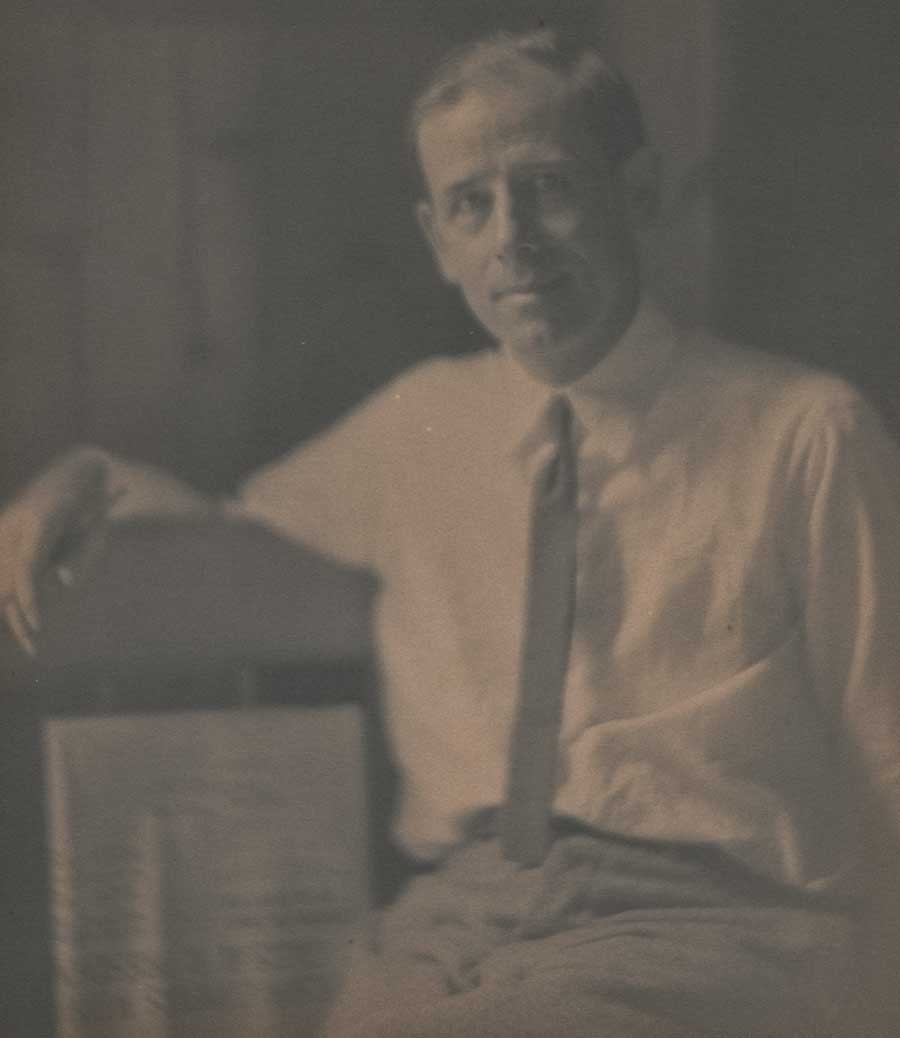 Detail: "Portrait of Clarence H. White": Ruth Anthony Davis, American (1880-1979): 1916: vintage platinum print: 24.2 x 19.3 cm | 29.0 x 21.5 cm Japan paper | 36.2 x 28.6 cm manilla card-stock: Davis, an early member of the Providence Camera Club, photographed her instructor Clarence Hudson White while she attended the Seventh Summer Session of the School of Photography at Stevens Farm in East Canaan, CT. A description of the school's location with emphasis on potential photographic subjects for students appeared in the March, 1916 issue of the International Studio: "The seventh summer session of the Clarence H. White School of Photography will be held at East Canaan, Connecticut, instead of Sequinland, Maine, as heretofore, during July and August. East Canaan is situated in a beautiful valley in the Berkshire Hills of Northern Connecticut, at an elevation of eight hundred feet above the sea level, and is surrounded by hills rising another eight hundred feet above the floor of the valley. The country furnishes abundance of photographic material, comprising, within easy walking distance, farms, rolling uplands, streams, rugged mountains and architecture of typically New England character, many of the buildings dating from Colonial times. Numerous industries, such as iron furnaces, lime kilns, and the like, afford abundant opportunity for pictorial work. The neighbourhood is by no means thickly settled, and those persons who enjoy the seclusion of country life will find it here. Not least among the attractions of this portion of Connecticut are the delightful climate and the practical freedom from mosquitoes." From: PhotoSeed Archive
Detail: "Portrait of Clarence H. White": Ruth Anthony Davis, American (1880-1979): 1916: vintage platinum print: 24.2 x 19.3 cm | 29.0 x 21.5 cm Japan paper | 36.2 x 28.6 cm manilla card-stock: Davis, an early member of the Providence Camera Club, photographed her instructor Clarence Hudson White while she attended the Seventh Summer Session of the School of Photography at Stevens Farm in East Canaan, CT. A description of the school's location with emphasis on potential photographic subjects for students appeared in the March, 1916 issue of the International Studio: "The seventh summer session of the Clarence H. White School of Photography will be held at East Canaan, Connecticut, instead of Sequinland, Maine, as heretofore, during July and August. East Canaan is situated in a beautiful valley in the Berkshire Hills of Northern Connecticut, at an elevation of eight hundred feet above the sea level, and is surrounded by hills rising another eight hundred feet above the floor of the valley. The country furnishes abundance of photographic material, comprising, within easy walking distance, farms, rolling uplands, streams, rugged mountains and architecture of typically New England character, many of the buildings dating from Colonial times. Numerous industries, such as iron furnaces, lime kilns, and the like, afford abundant opportunity for pictorial work. The neighbourhood is by no means thickly settled, and those persons who enjoy the seclusion of country life will find it here. Not least among the attractions of this portion of Connecticut are the delightful climate and the practical freedom from mosquitoes." From: PhotoSeed Archive
But this aside is merely an excuse for the real purpose of this post: today is the official public opening of an exciting and ground breaking new exhibit on Clarence White at the Princeton University Art Museum in Princeton, New Jersey. Clarence H. White and His World: The Art and Craft of Photography, 1895-1925 will be on display there from October 7, 2017 to January 7, 2018. But don’t despair if you can’t make it right away, because the show travels to an additional three US museums through early 2019. Venue details along with additional links including one for the first comprehensive monograph on White published in conjunction with the show and authored by Anne McCauley, David Hunter McAlpin Professor of the History of Photography and Modern Art at Princeton University, concludes this post.
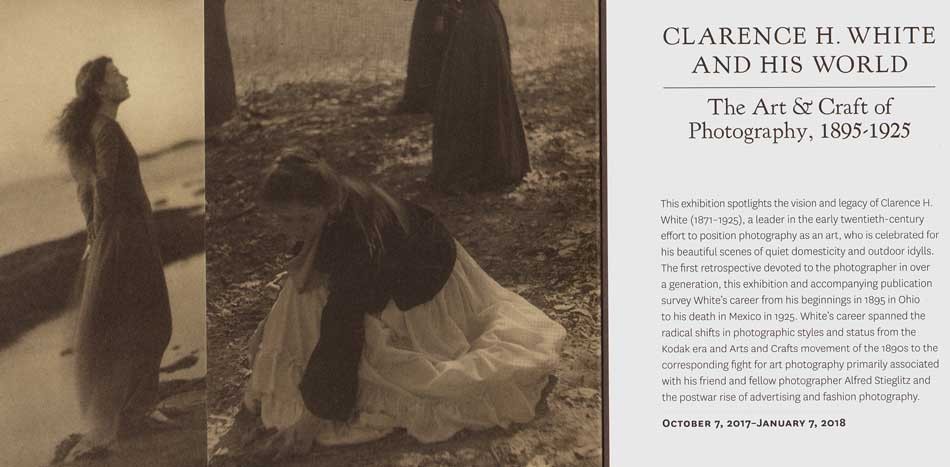 Detail: "Clarence H. White and His World: The Art and Craft of Photography, 1895-1925": composite gatefold brochure for exhibit at Princeton University Art Museum which runs from October 7, 2017-January 7, 2018. Photographic illustrations by White left and middle: The Sea (Rose Pastor Stokes, Caritas Island, Connecticut) (detail), 1909, printed after 1917. Palladium print. Princeton University Art Museum, Clarence H. White Collection; middle: In the Orchard, Newark, Ohio (detail), 1902, printed after 1917. Palladium print. The Museum of Modern Art. Gift of Jane Felix White, 1941. Courtesy: Princeton University Art Museum
Detail: "Clarence H. White and His World: The Art and Craft of Photography, 1895-1925": composite gatefold brochure for exhibit at Princeton University Art Museum which runs from October 7, 2017-January 7, 2018. Photographic illustrations by White left and middle: The Sea (Rose Pastor Stokes, Caritas Island, Connecticut) (detail), 1909, printed after 1917. Palladium print. Princeton University Art Museum, Clarence H. White Collection; middle: In the Orchard, Newark, Ohio (detail), 1902, printed after 1917. Palladium print. The Museum of Modern Art. Gift of Jane Felix White, 1941. Courtesy: Princeton University Art Museum
Several years before, I had taken a deep-dive into the remarkable life of White, whose arc resonated with me on many levels, especially his love for breaking the rules as applied to photographic lighting. To wit: what do you mean I can’t photograph my subject backlit? A simple optical concept today perhaps but in the late 1890’s? Revolutionary. I kid you not.
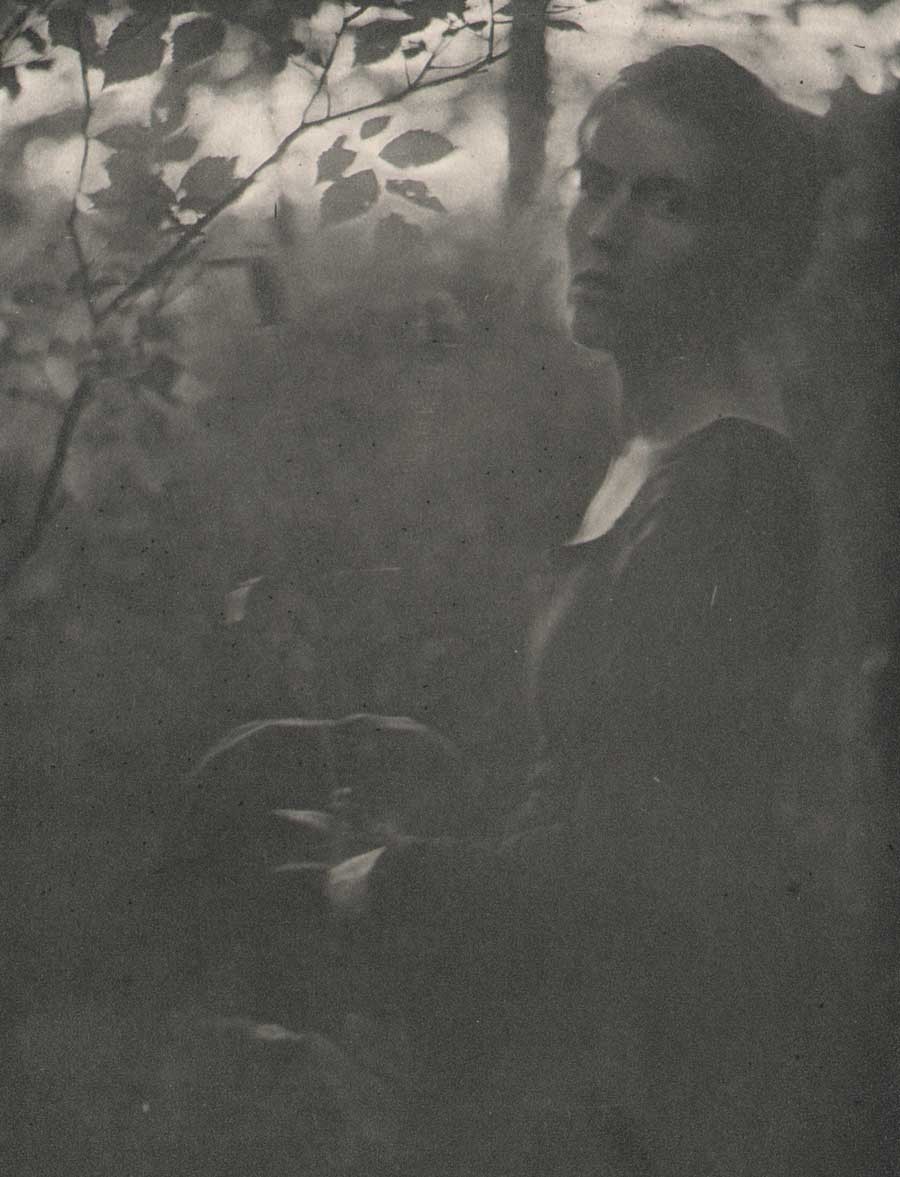 Detail: "At the Edge of the Woods ⎯ Evening": Clarence H. White, American (1871-1925): Chine-collé photogravure from Camera Notes, Vol. IV, April 1901: 14.4 x 10.1 cm | 28.6 x 19.6 cm uncut: The photographer’s sister-in-law, Letitia Felix is shown at twilight in a wooded setting. Alternately titled as In the Woods; Evening, the photograph was first exhibited in the Third Philadelphia Photographic Salon the same year. (cat.# 202) Later that year, it was exhibited as part of the Newark Camera Club’s exhibition in the town’s Association Building from November 28-December 1, 1900 where it was titled as Edge of the Woods ⎯Evening. The catalogue issued for the exhibit reproduced the photo as the frontis gravure for the publication. From: PhotoSeed Archi
Detail: "At the Edge of the Woods ⎯ Evening": Clarence H. White, American (1871-1925): Chine-collé photogravure from Camera Notes, Vol. IV, April 1901: 14.4 x 10.1 cm | 28.6 x 19.6 cm uncut: The photographer’s sister-in-law, Letitia Felix is shown at twilight in a wooded setting. Alternately titled as In the Woods; Evening, the photograph was first exhibited in the Third Philadelphia Photographic Salon the same year. (cat.# 202) Later that year, it was exhibited as part of the Newark Camera Club’s exhibition in the town’s Association Building from November 28-December 1, 1900 where it was titled as Edge of the Woods ⎯Evening. The catalogue issued for the exhibit reproduced the photo as the frontis gravure for the publication. From: PhotoSeed Archi
In groundbreaking photographs by White such as his brooding landscape figure study At the Edge of the Woods ⎯Evening (1900), a remarkable twilight composition showing his sister-in-law Letitia Felix emerging from a thicket with just a hint of light on the horizon became just one example of his early output. White’s decidedly masterful reinterpretation of the possibilities of light and the photographic medium done with artistic intent was quickly getting accolades in the press, and his work was soon honored in salons the world over beginning at the end of the 19th century.
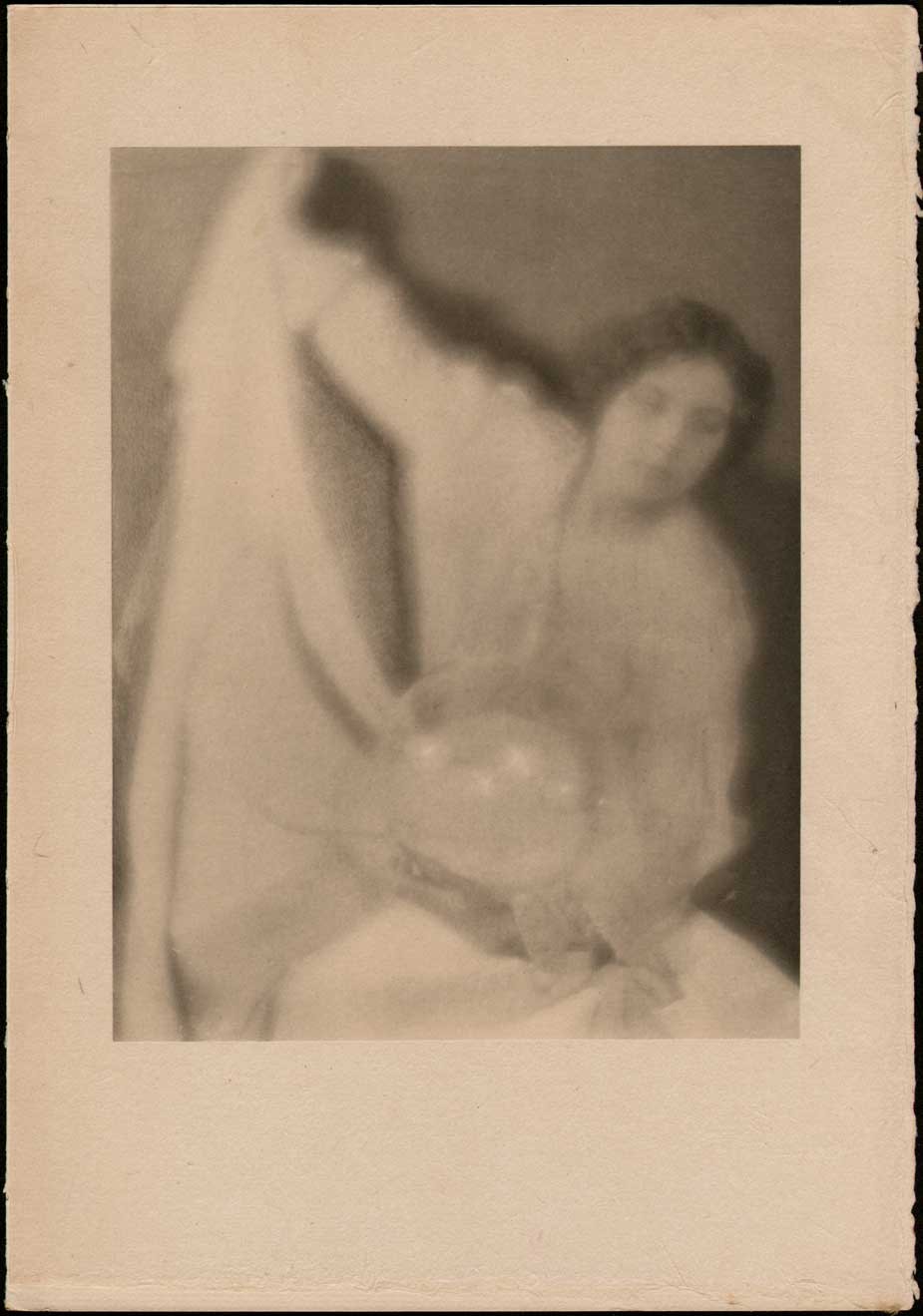 "Experiment 28": Alfred Stieglitz 1864-1946 & Clarence White 1871-1925, Americans: vintage japanese tissue photogravure published in Camera Work XXVII: 1909: 20.6 x 15.9 | 30.2 x 21.1 cm: In 1907, the year after Clarence White arrived in New York City, he collaborated with Photo-Secession founder Alfred Stieglitz on a series of portraits featuring two models. Shown here holding a glass globe, California model Mabel Cramer poses in a portrait later reproduced as a plate in Camera Work. Said to be a friend of the German American photographer Arnold Genthe and possessing a face worthy of Cleopatra, Cramer and a woman known only as a Miss Thompson, posed for a series of photographs intended to promote photography as an equivalent medium to painting. It was the only time Stieglitz would ever work in tandem with another photographer and shows the extent to which the photographers were allied aesthetically and technically. From: PhotoSeed Archive
"Experiment 28": Alfred Stieglitz 1864-1946 & Clarence White 1871-1925, Americans: vintage japanese tissue photogravure published in Camera Work XXVII: 1909: 20.6 x 15.9 | 30.2 x 21.1 cm: In 1907, the year after Clarence White arrived in New York City, he collaborated with Photo-Secession founder Alfred Stieglitz on a series of portraits featuring two models. Shown here holding a glass globe, California model Mabel Cramer poses in a portrait later reproduced as a plate in Camera Work. Said to be a friend of the German American photographer Arnold Genthe and possessing a face worthy of Cleopatra, Cramer and a woman known only as a Miss Thompson, posed for a series of photographs intended to promote photography as an equivalent medium to painting. It was the only time Stieglitz would ever work in tandem with another photographer and shows the extent to which the photographers were allied aesthetically and technically. From: PhotoSeed Archive
Not bad for a man with limited means and a high school education. Employed as a bookkeeper in 1890’s Newark nearly seven days a week for the same wholesale grocery firm his father worked at, (the family had moved there in 1887 from nearby West Carlisle, OH), White first took up amateur photography a year after his 1893 marriage to Jane Felix, with the young photographer diligently saving weekly spare change from his salary for camera and darkroom supplies. Reportedly, his reality of only being able to afford the exposure of several glass plates a week necessitated lots of planning in order to make successful photographs. With outdoor locations previously scouted throughout Licking County and interiors often taken in the darkened homes of family and friends, these same subjects were further cajoled into wearing fashions from the American Civil-War era or earlier in order to evoke feelings of times gone by for the compositions.
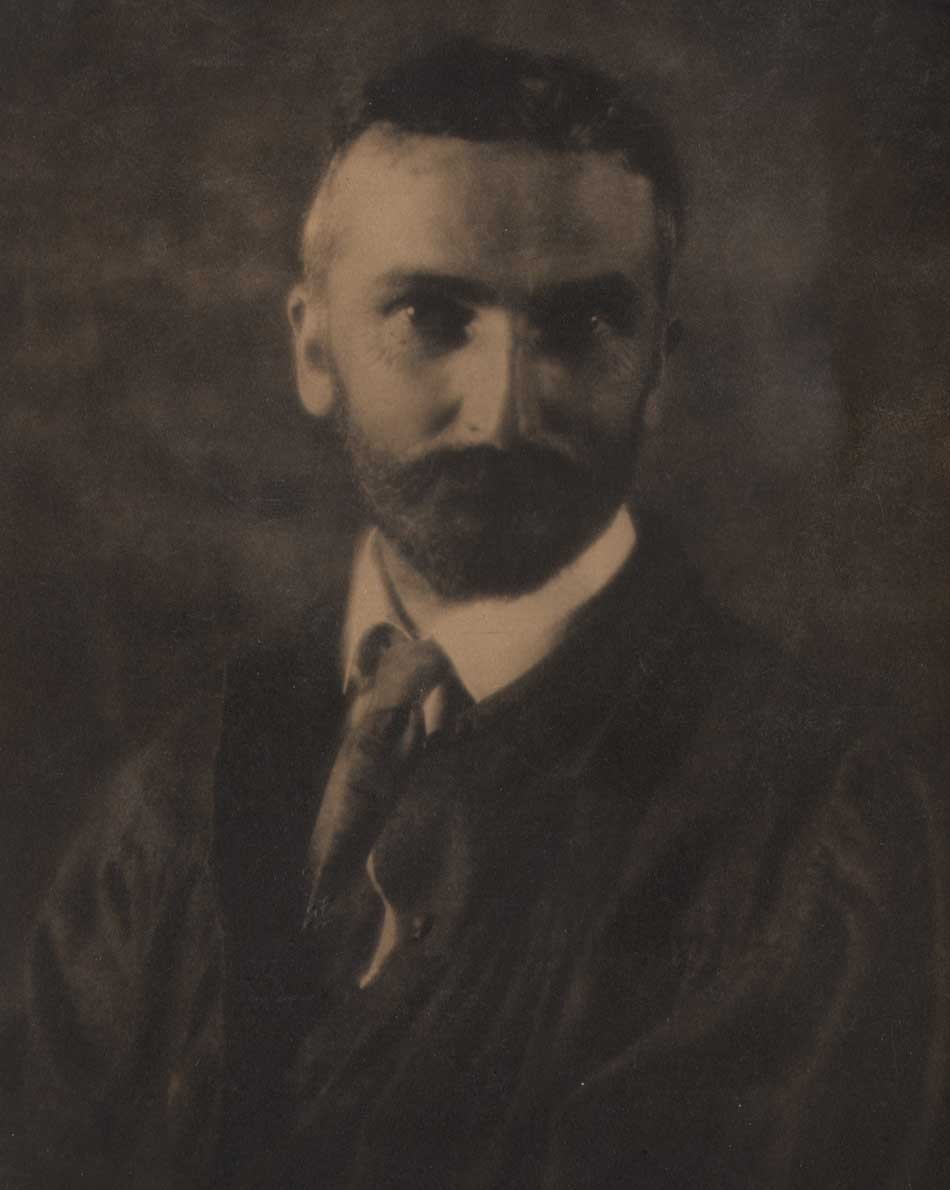 Detail: "Portrait of Arthur Wesley Dow": Clarence H. White, American (1871-1925): vintage waxed platinum print, unmounted: 22.1 x 16.6 cm. From the Princeton University Museum website: "White was hired by Arthur Wesley Dow at Teachers College in 1907 and shared Dow’s philosophy that students of the fine and the applied arts should have the same fundamental training based on design principles (anticipating the approach of the Bauhaus in the 1920s)." from: PhotoSeed Archive
Detail: "Portrait of Arthur Wesley Dow": Clarence H. White, American (1871-1925): vintage waxed platinum print, unmounted: 22.1 x 16.6 cm. From the Princeton University Museum website: "White was hired by Arthur Wesley Dow at Teachers College in 1907 and shared Dow’s philosophy that students of the fine and the applied arts should have the same fundamental training based on design principles (anticipating the approach of the Bauhaus in the 1920s)." from: PhotoSeed Archive
A founding member of the American Photo-Secession movement begun in 1902 by Alfred Stieglitz, White’s transition from Newark to New York City in 1906 began a new chapter of teaching by the photographer, who soon made the acquaintance of artist and arts educator Arthur Wesley Dow, (1857-1922) who hired White as an instructor at Columbia University’s Teachers College in 1907. White would go on to found his own groundbreaking schools of artistic photography utilizing a modern pedagogy learned from Dow among others: first in Maine beginning in 1910 and then in New York City in 1914. Besides emphasizing pictorial photographic technique as well as numerous technical processes as part of the school curriculum, modern composition as espoused by Dow was taught along with art history through lecture format in classes by artists including early American cubist painter Max Weber (1881-1961) and later by artists including Charles James Martin (1886-1955) in the early 1920’s.
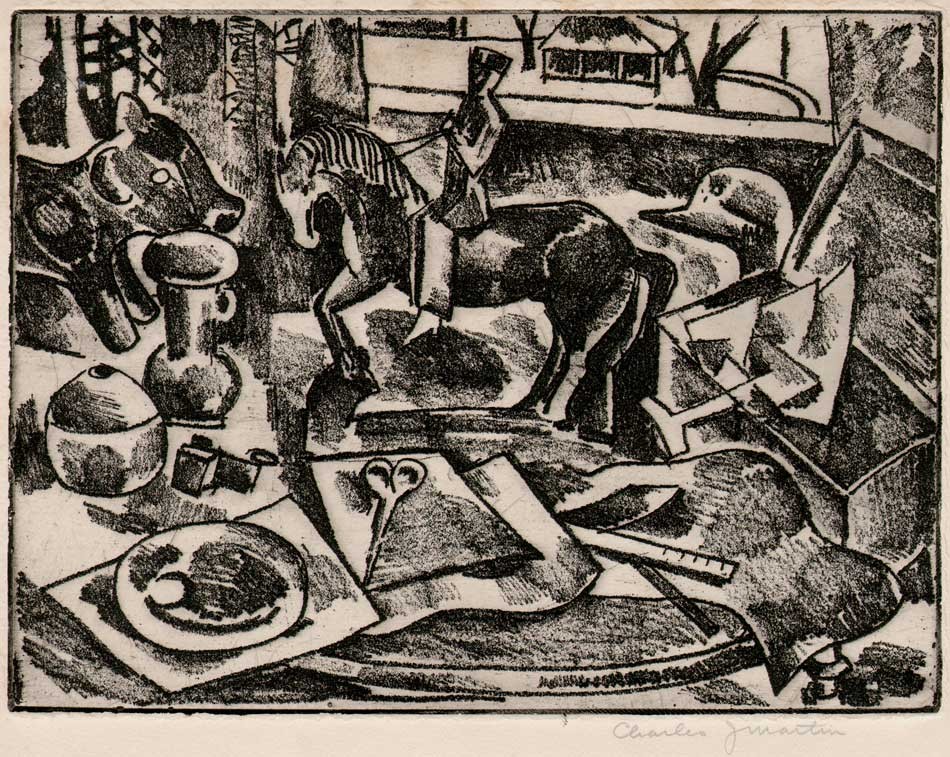 "Interior Composition with Figurines": Charles James Martin, American (1886-1955): vintage etching on plate paper ca. 1915-20: 15.1 x 20.1 | 18.8 x 24.8 cm (trimmed): Martin studied with Arthur Wesley Dow, and later taught alongside him at Columbia University Teachers College. At TC, he also studied photography with Clarence H. White, and became an instructor at White’s School of Photography in 1918. Martin began teaching at the Art Students League of New York in 1921. The following background on Martin and his involvement with the White school appeared in the February, 1921 issue of "The Touchstone and the American Art Student Magazine": "The Clarence H. White School of Photography announces a course of instruction in Print Making by Prof. Charles J. Martin of the Department of Fine Arts, Columbia University. The purpose of the course is to develop an appreciation of prints through a study of fine examples and particularly through practice in etching plates, cutting blocks and printing. There will be also an opportunity to do photo-engraving such as the line cut and photogravure. The course will consist of twenty sessions. The earlier sessions are now under way, and the response to this announcement gives evidence that the student of the Photographic Arts is endeavoring to gain practical knowledge as well as artistic reproduction." p. 406: from: PhotoSeed Archive
"Interior Composition with Figurines": Charles James Martin, American (1886-1955): vintage etching on plate paper ca. 1915-20: 15.1 x 20.1 | 18.8 x 24.8 cm (trimmed): Martin studied with Arthur Wesley Dow, and later taught alongside him at Columbia University Teachers College. At TC, he also studied photography with Clarence H. White, and became an instructor at White’s School of Photography in 1918. Martin began teaching at the Art Students League of New York in 1921. The following background on Martin and his involvement with the White school appeared in the February, 1921 issue of "The Touchstone and the American Art Student Magazine": "The Clarence H. White School of Photography announces a course of instruction in Print Making by Prof. Charles J. Martin of the Department of Fine Arts, Columbia University. The purpose of the course is to develop an appreciation of prints through a study of fine examples and particularly through practice in etching plates, cutting blocks and printing. There will be also an opportunity to do photo-engraving such as the line cut and photogravure. The course will consist of twenty sessions. The earlier sessions are now under way, and the response to this announcement gives evidence that the student of the Photographic Arts is endeavoring to gain practical knowledge as well as artistic reproduction." p. 406: from: PhotoSeed Archive
At 54, Clarence White died of a heart attack while accompanying photo students during a summer session of his school in Mexico City in 1925. Besides his important contributions as a ground-breaking photographic artist in the late 19th and early 20th century, his legacy as a teacher is perhaps more important as we finally begin to reevaluate his importance in the larger history of early artistic photography. The Princeton exhibition and accompanying monograph-the first truly comprehensive volume on White ever published, will further our understanding and appreciation for this gentleman.
PhotoSeed is honored to have played a small role in the exhibition showcasing Clarence White’s talents at photographic book illustration. A slim volume loaned for the show, Songs of All Seasons, published in 1904 with prose by his uncle Ira Billman and photographs by White, will be included in an exhibit display case. An additional rare illustrated copy of Irving Bacheller’s best-selling novel Eben Holden from 1903, with photogravure plates by White, will also appear after it was acquired by Princeton from this archive. This site further intends to publish additional posts over the next several years chronicling White’s groundbreaking schools of photography as well as other aspects of his early and later life in Newark, OH and New York.
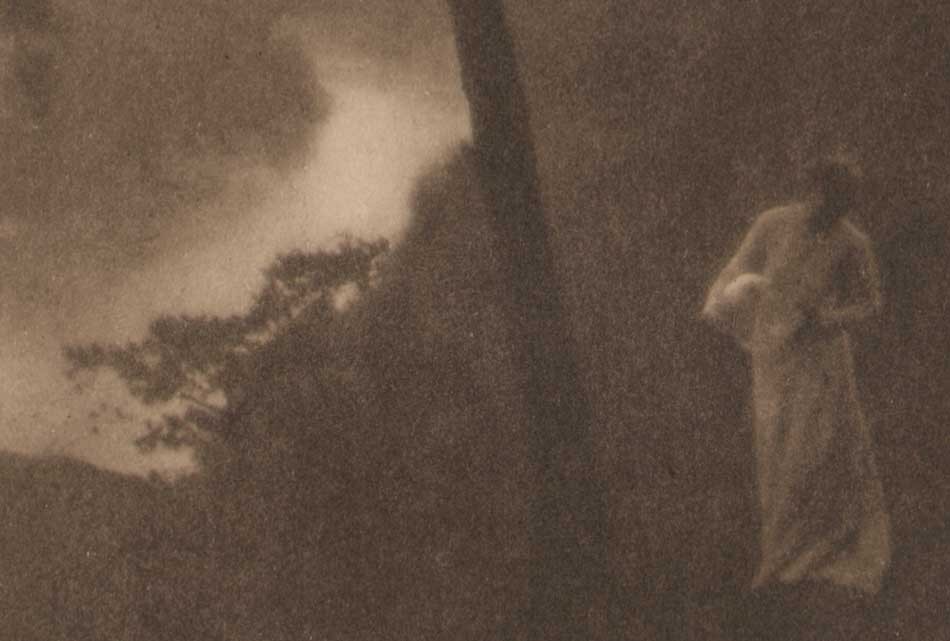 Detail: "Morning": Clarence H. White, American (1871-1925): 1905: vintage photogravure published in the volume "The Artistic Side of Photography" by A.J. Anderson: London, Stanley Paul & Co., 1910. 11.9 x 9.3 | 22.5 x 15.1 cm. The plate, titled "A Landscape", from a platinotype in the collection of A.L. Coburn, appears on p. 155. This moody landscape photograph with figure was taken by White on the bluffs in Newark, Ohio overlooking the Licking River, a location that appears in several of the photographer's compositions. From the Metropolitan Museum of Art Website, which holds an original platinum print dated to 1905 bequeathed by Alfred Stieglitz: "Morning perfectly embodies the tenets of Pictorialism: expressive, rather than narrative or documentary, content; craftsmanship in the execution of the print; and a carefully constructed composition allied to Impressionist and American Tonalist painting and to popular Japanese prints. His photographs from the period before he moved to New York in 1906 signaled a remove from the modern urban world. Neither genre scene nor narrative tableau, this photograph is a retreat into domesticized nature." From: PhotoSeed Archive
Detail: "Morning": Clarence H. White, American (1871-1925): 1905: vintage photogravure published in the volume "The Artistic Side of Photography" by A.J. Anderson: London, Stanley Paul & Co., 1910. 11.9 x 9.3 | 22.5 x 15.1 cm. The plate, titled "A Landscape", from a platinotype in the collection of A.L. Coburn, appears on p. 155. This moody landscape photograph with figure was taken by White on the bluffs in Newark, Ohio overlooking the Licking River, a location that appears in several of the photographer's compositions. From the Metropolitan Museum of Art Website, which holds an original platinum print dated to 1905 bequeathed by Alfred Stieglitz: "Morning perfectly embodies the tenets of Pictorialism: expressive, rather than narrative or documentary, content; craftsmanship in the execution of the print; and a carefully constructed composition allied to Impressionist and American Tonalist painting and to popular Japanese prints. His photographs from the period before he moved to New York in 1906 signaled a remove from the modern urban world. Neither genre scene nor narrative tableau, this photograph is a retreat into domesticized nature." From: PhotoSeed Archive
EXHIBITION SCHEDULE: Clarence H. White and His World: The Art and Craft of Photography, 1895-1925
Princeton University Art Museum (10/07/17–01/07/18)
Further link to the exhibit at Princeton
Video: Breaking down photographic processes used by Pictorialist photographers: a collaboration between the Princeton University Art Museum and the Yale Institute for the Preservation of Cultural Heritage.
Davis Museum, Wellesley College
(02/13/18–06/10/18)
Portland Museum of Art, Maine
(06/22/18–09/16/18)
Cleveland Museum of Art
(10/21/18–01/21/19)
Book link:
October 31, 2017
408 pages, 10 x 11 1/2
346 color + b/w illus.
ISBN: 9780300229080
Hardcover
Distributed for the Princeton University Art Museum
Stages for Ages
Posted April 2016 in Exhibitions, History of Photography, New Additions, Publishing, Significant Photographers
All the world’s a stage, And all the men and women merely players: They have their exits and their entrances; And one man in his time plays many parts, His acts being seven ages.
-From As You Like It, Act II. Scene VII, Jaques’s speech
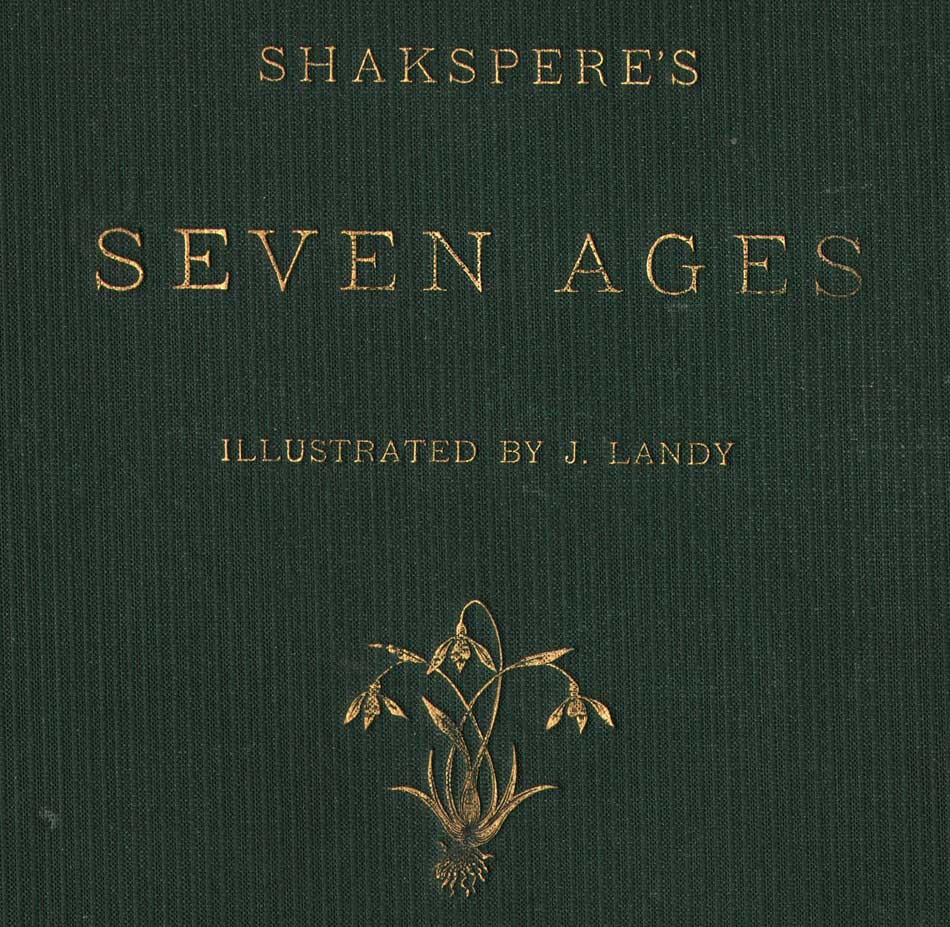 Detail: book cover: "Shakspere’s Seven Ages" Illustrated by J. Landy: Octavo with letterpress and seven individual pasted albumen portrait photographs by Landy: Cincinnati: Robert Clarke & Co., 1876: from: PhotoSeed Archive
Detail: book cover: "Shakspere’s Seven Ages" Illustrated by J. Landy: Octavo with letterpress and seven individual pasted albumen portrait photographs by Landy: Cincinnati: Robert Clarke & Co., 1876: from: PhotoSeed Archive
In life, Birthdays typically get all the attention. At least while your friends are around. Not so much death. But for certain souls long departed this mortal coil, it’s just as important. This is especially true for English playwright and poet William Shakespeare, whose passing on April 23, 1616 at 52 years of age- or 400 years ago today- seems like a perfectly good excuse to throw a party as well. Cincinnati portrait photographer James M. Landy (1838-1897) would have readily agreed, and he used the excuse of another anniversary-America’s first Centennial held in 1876 in Philadelphia- to showcase his new series of “character photographs” illustrating the Bard’s Seven Ages of Man from his play As You Like It . (1.)
Come along on a short photographic journey exploring these ages of the male species, according to Shakespeare. Have they changed with the passage of time?
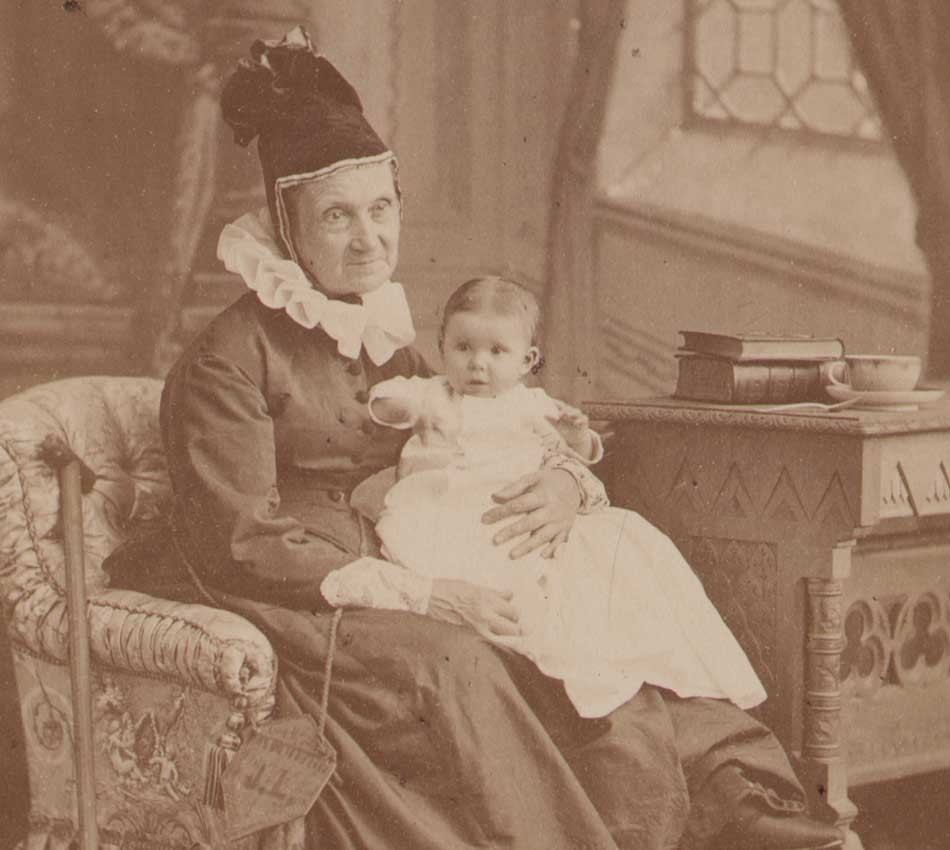 The First Age: Detail: "The Infant" : James M. Landy, American: 1876: pasted albumen print included in the volume "Shakspere’s Seven Ages": 14.0 x 9.9 | 24.7 x 19.0 cm: Cincinnati: Robert Clarke & Co., 1876. Captioned text opposite book plate: "At first the infant, Mewling and puking in the nurse’s arms.": From: PhotoSeed Archive
The First Age: Detail: "The Infant" : James M. Landy, American: 1876: pasted albumen print included in the volume "Shakspere’s Seven Ages": 14.0 x 9.9 | 24.7 x 19.0 cm: Cincinnati: Robert Clarke & Co., 1876. Captioned text opposite book plate: "At first the infant, Mewling and puking in the nurse’s arms.": From: PhotoSeed Archive
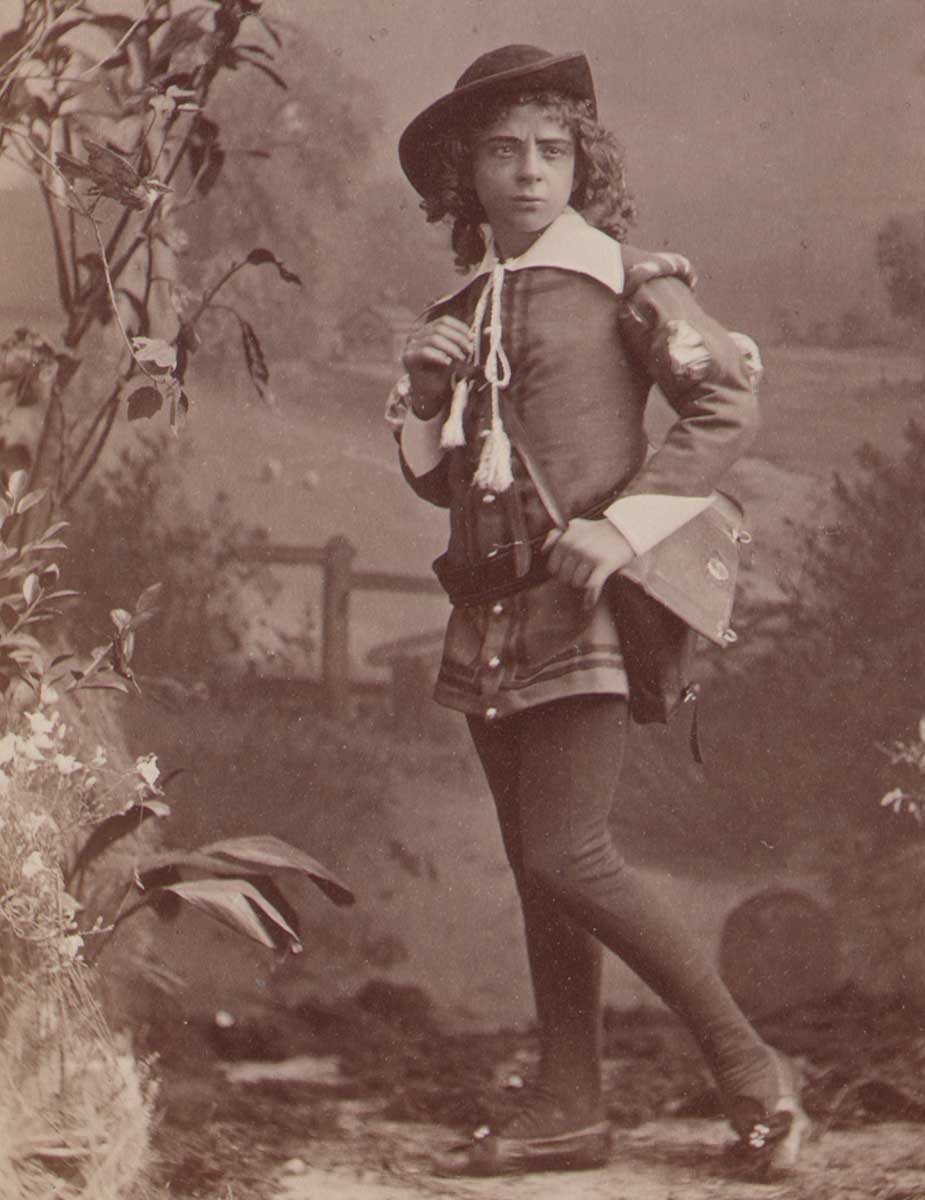 The Second Age: Detail: "The Schoolboy": James M. Landy, American: 1876: pasted albumen print included in the volume "Shakspere’s Seven Ages": 14.0 x 9.9 | 24.7 x 19.0 cm: Cincinnati: Robert Clarke & Co., 1876. Captioned text opposite book plate: "Then the whining school-boy, with his satchel, And shining morning face, creeping like snail Unwillingly to school." From: PhotoSeed Archive
The Second Age: Detail: "The Schoolboy": James M. Landy, American: 1876: pasted albumen print included in the volume "Shakspere’s Seven Ages": 14.0 x 9.9 | 24.7 x 19.0 cm: Cincinnati: Robert Clarke & Co., 1876. Captioned text opposite book plate: "Then the whining school-boy, with his satchel, And shining morning face, creeping like snail Unwillingly to school." From: PhotoSeed Archive
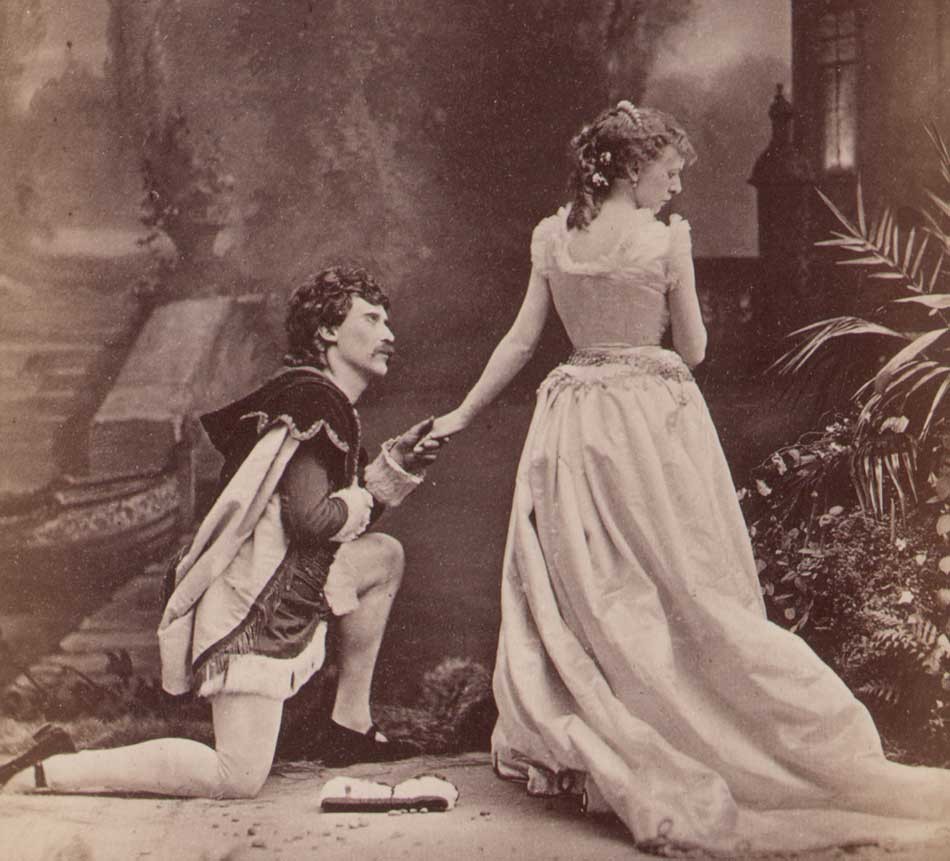 The Third Age: Detail: "The Lover": James M. Landy, American: 1876: pasted albumen print included in the volume "Shakspere’s Seven Ages": 14.3 x 9.9 | 24.7 x 19.0 cm: Cincinnati: Robert Clarke & Co., 1876. Captioned text opposite book plate: "And then the lover, Sighing like furnace, with a woful ballad Made to his mistress’ eyebrow." From: PhotoSeed Archive
The Third Age: Detail: "The Lover": James M. Landy, American: 1876: pasted albumen print included in the volume "Shakspere’s Seven Ages": 14.3 x 9.9 | 24.7 x 19.0 cm: Cincinnati: Robert Clarke & Co., 1876. Captioned text opposite book plate: "And then the lover, Sighing like furnace, with a woful ballad Made to his mistress’ eyebrow." From: PhotoSeed Archive
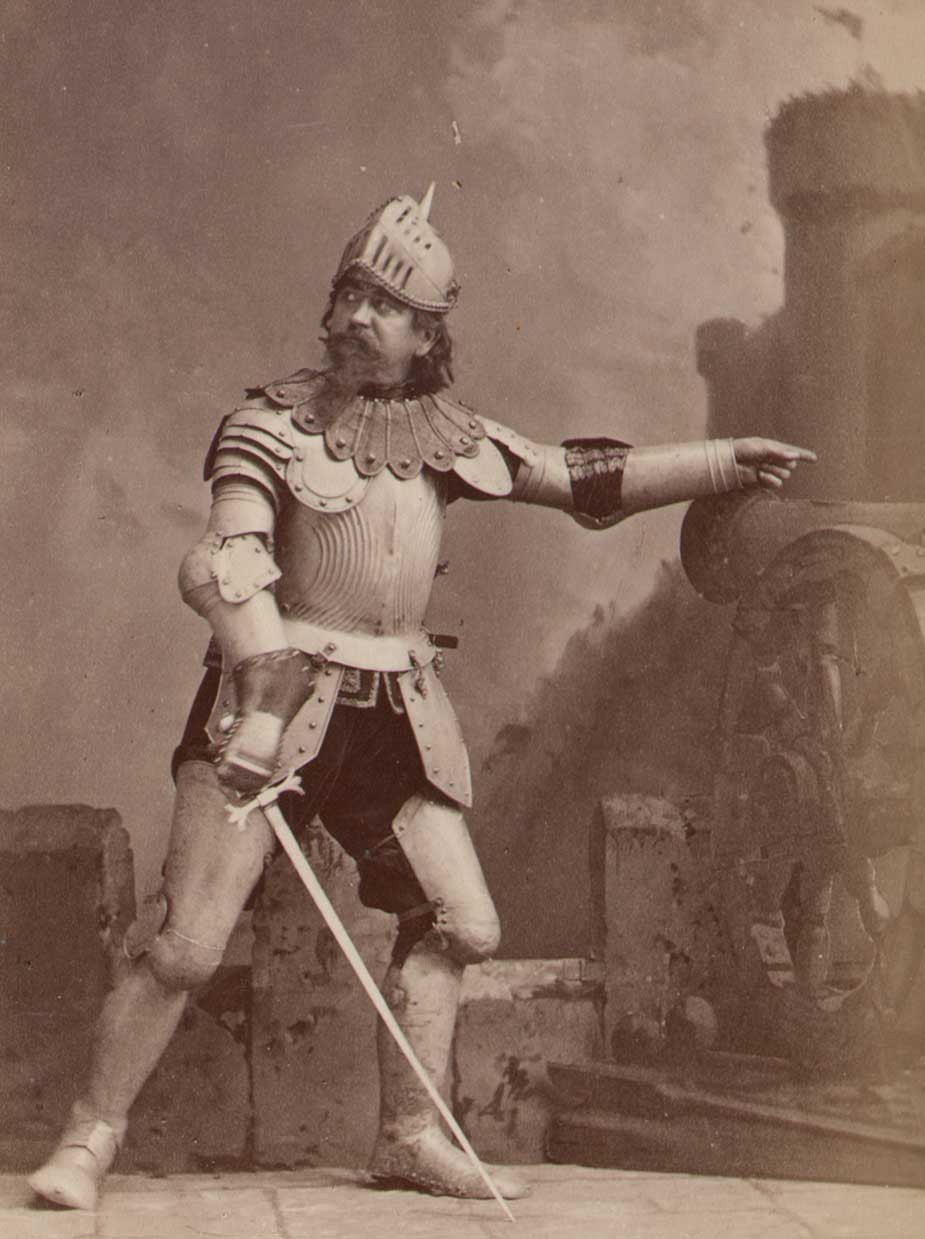 The Fourth Age: Detail: "The Soldier": James M. Landy, American: 1876: pasted albumen print included in the volume "Shakspere’s Seven Ages": 14.0 x 9.9 | 24.7 x 19.0 cm: Cincinnati: Robert Clarke & Co., 1876. Captioned text opposite book plate: "Then a soldier, Full of strange oaths, and bearded like the pard, Jealous in honor, sudden and quick in quarrel, Seeking the bubble reputation Even in the cannon’s mouth." From: PhotoSeed Archive
The Fourth Age: Detail: "The Soldier": James M. Landy, American: 1876: pasted albumen print included in the volume "Shakspere’s Seven Ages": 14.0 x 9.9 | 24.7 x 19.0 cm: Cincinnati: Robert Clarke & Co., 1876. Captioned text opposite book plate: "Then a soldier, Full of strange oaths, and bearded like the pard, Jealous in honor, sudden and quick in quarrel, Seeking the bubble reputation Even in the cannon’s mouth." From: PhotoSeed Archive
 The Fifth Age: "The Justice": James M. Landy, American: 1876: pasted albumen print included in the volume "Shakspere’s Seven Ages": 14.3 x 9.7 | 24.7 x 19.0 cm: Cincinnati: Robert Clarke & Co., 1876. Captioned text opposite book plate: "And then the Justice, In fair round belly, with good capon lin'd, With eyes severe, and beard of formal cut, Full of wise saws and modern instances; And so he plays his part." From: PhotoSeed Archive
The Fifth Age: "The Justice": James M. Landy, American: 1876: pasted albumen print included in the volume "Shakspere’s Seven Ages": 14.3 x 9.7 | 24.7 x 19.0 cm: Cincinnati: Robert Clarke & Co., 1876. Captioned text opposite book plate: "And then the Justice, In fair round belly, with good capon lin'd, With eyes severe, and beard of formal cut, Full of wise saws and modern instances; And so he plays his part." From: PhotoSeed Archive
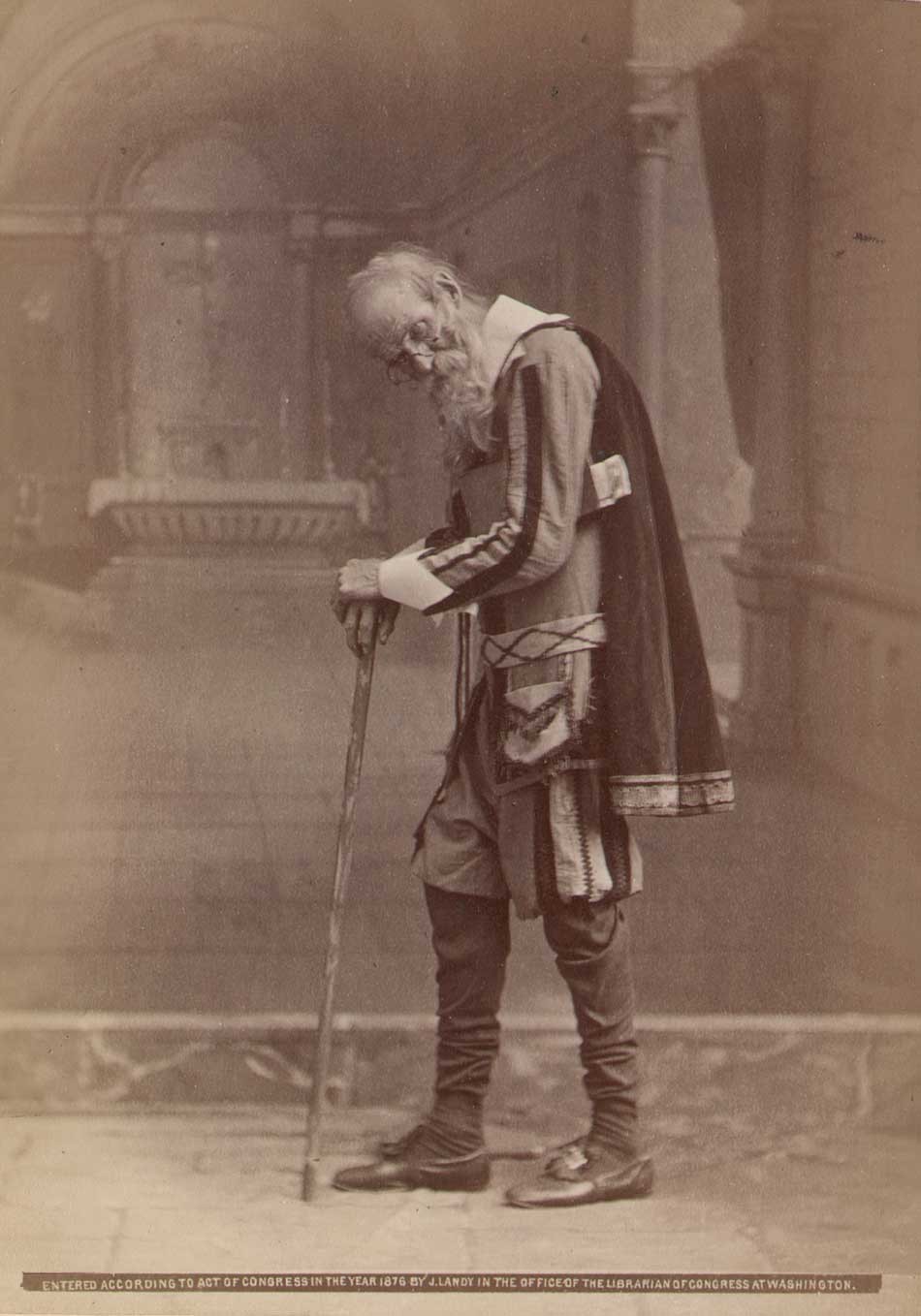 The Sixth Age: "The Lean and Slipper’d Pantaloon": James M. Landy, American: 1876: pasted albumen print included in the volume "Shakspere’s Seven Ages": 14.0 x 9.9 | 24.7 x 19.0 cm: Cincinnati: Robert Clarke & Co., 1876. Captioned text opposite book plate: "The sixth age shifts Into the lean and slipper’d pantaloon, With spectacles on nose and pouch on side, His youthful hose well saved, a world too wide For his shrunk shank; and his big manly voice, Turning again toward childish treble, pipes And whistles in his sound." From: PhotoSeed Archive
The Sixth Age: "The Lean and Slipper’d Pantaloon": James M. Landy, American: 1876: pasted albumen print included in the volume "Shakspere’s Seven Ages": 14.0 x 9.9 | 24.7 x 19.0 cm: Cincinnati: Robert Clarke & Co., 1876. Captioned text opposite book plate: "The sixth age shifts Into the lean and slipper’d pantaloon, With spectacles on nose and pouch on side, His youthful hose well saved, a world too wide For his shrunk shank; and his big manly voice, Turning again toward childish treble, pipes And whistles in his sound." From: PhotoSeed Archive
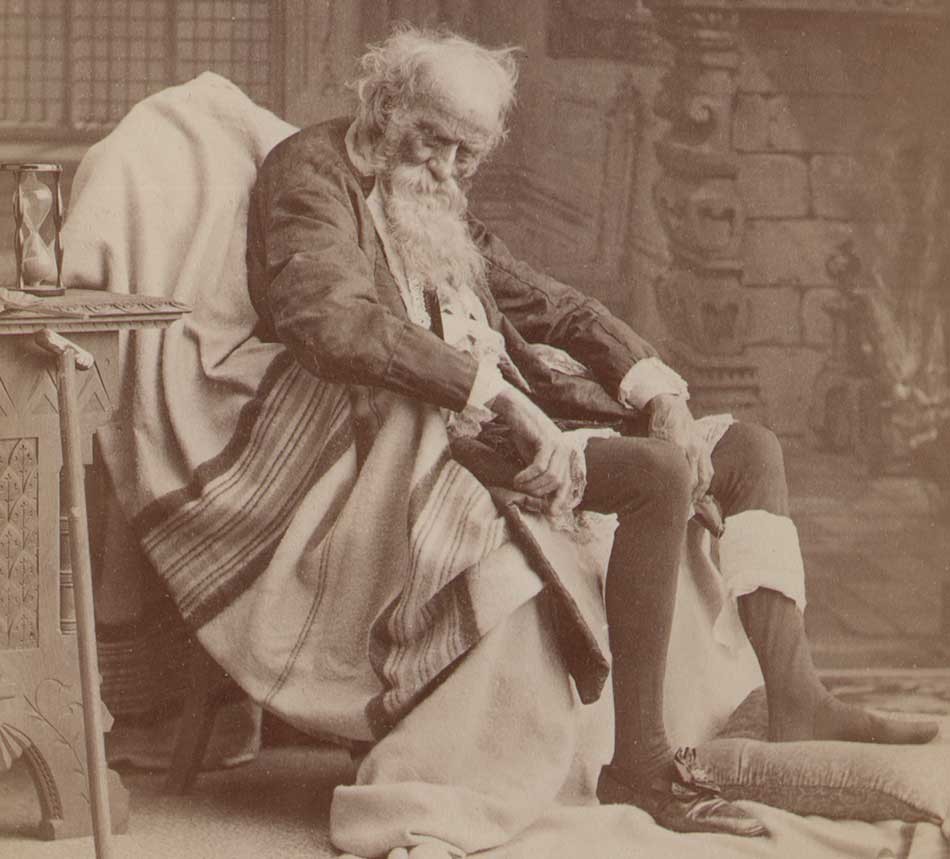 The Seventh Age: Detail: "Sans Teeth, Sans Eyes, Sans Taste, Sans Everything": James M. Landy, American: 1876: pasted albumen print included in the volume "Shakspere’s Seven Ages": 14.0 x 9.9 | 24.7 x 19.0 cm: Cincinnati: Robert Clarke & Co., 1876. Captioned text opposite book plate: "Last scene of all That ends this strange eventful history, Is second childishness and mere oblivion— Sans teeth, sans eyes, sans taste, sans everything.” From: PhotoSeed Archive
The Seventh Age: Detail: "Sans Teeth, Sans Eyes, Sans Taste, Sans Everything": James M. Landy, American: 1876: pasted albumen print included in the volume "Shakspere’s Seven Ages": 14.0 x 9.9 | 24.7 x 19.0 cm: Cincinnati: Robert Clarke & Co., 1876. Captioned text opposite book plate: "Last scene of all That ends this strange eventful history, Is second childishness and mere oblivion— Sans teeth, sans eyes, sans taste, sans everything.” From: PhotoSeed Archive
1. James Landy: from: Artists in Ohio, 1787-1900: A Biographical Dictionary, Mary Sayre Haverstock et al: Kent State University Press, 2000: p. 506
Blue Prince
Posted March 2016 in Alternate Processes, Childhood Photography, Exhibitions, History of Photography, Unknown Photographers, Unknown Photographs
Discovering a needle in a haystack, with apologies to this farmhand happily lounging atop a salt marsh haystack before the turn of the 20th century, is the proverbial sensation one beholds when encountering a fine blueprint, or cyanotype photograph, for the first time.
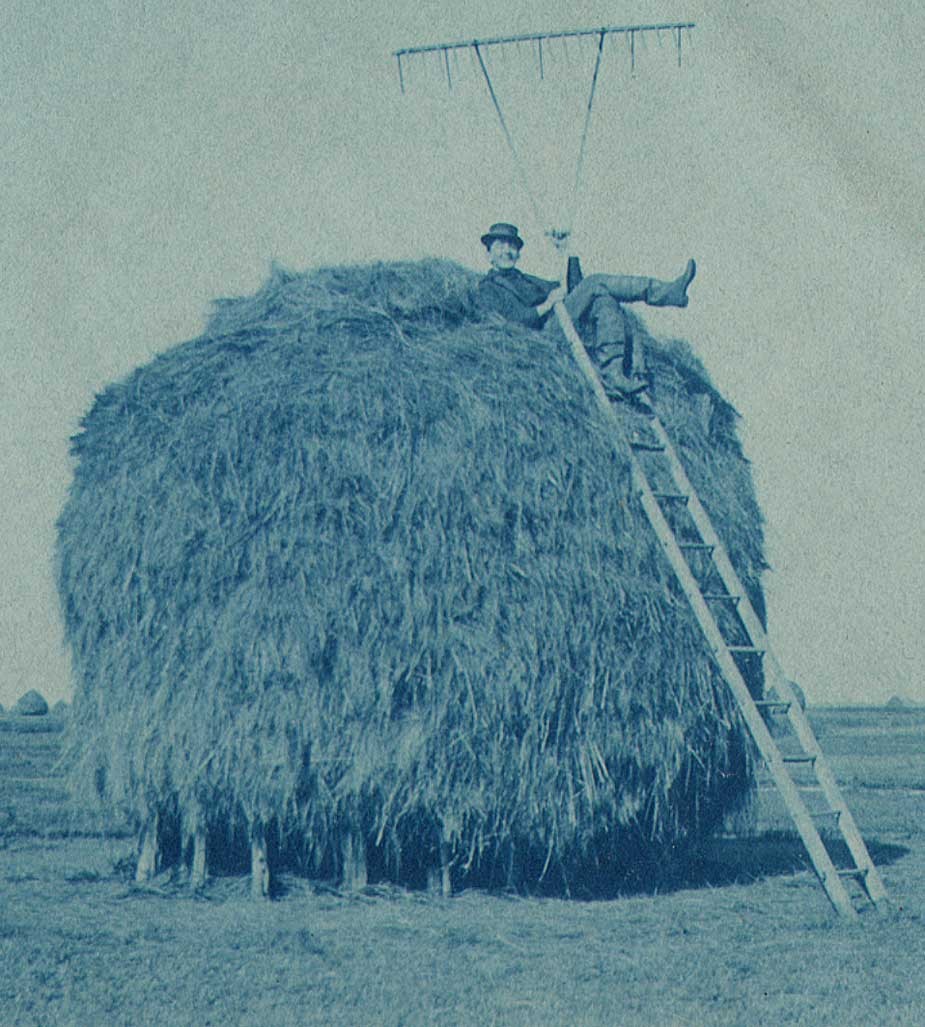 Detail: "Farmhand atop Salt Marsh Haystack" : anonymous American photographer: cyanotype: 1895-1900: 8.7 x 12.0 cm: The location of this photograph has been determined to be Plum Island in Newburyport, Mass, on Boston's North Shore. The marshes, in a tidal zone on the Atlantic ocean, is where salt marsh hay grows and then harvested. The farmhand would first use the wooden drag rake to collect the cut hay into piles. It would then be gathered and piled into layers above a platform (seen at bottom of photo) made from cedar wood staddles. This form of haystack making dates from the 17th Century is still practiced in the area in the present day. From: PhotoSeed Archive
Detail: "Farmhand atop Salt Marsh Haystack" : anonymous American photographer: cyanotype: 1895-1900: 8.7 x 12.0 cm: The location of this photograph has been determined to be Plum Island in Newburyport, Mass, on Boston's North Shore. The marshes, in a tidal zone on the Atlantic ocean, is where salt marsh hay grows and then harvested. The farmhand would first use the wooden drag rake to collect the cut hay into piles. It would then be gathered and piled into layers above a platform (seen at bottom of photo) made from cedar wood staddles. This form of haystack making dates from the 17th Century is still practiced in the area in the present day. From: PhotoSeed Archive
Given the excuse the Worcester Art Museum in Massachusetts is devoting significant wall space to their current exhibit: Cyanotypes: Photography’s Blue Period, (through April 24, 2016-publication here.) all while keeping with this institution’s admirable mission of presenting photography as an art form to the public since 1904, I’m mounting my own mini-exhibition of vintage cyanotypes from the PhotoSeed archive here with the added bonus of several photographs that literally embrace and further the definition of “blue print”. So like our “prince” above, whose raking abilities are indeed most impressive, here’s hoping your own photographic gatherings include finding the unique beauty these gems in blue offer.
-David Spencer, February, 2016
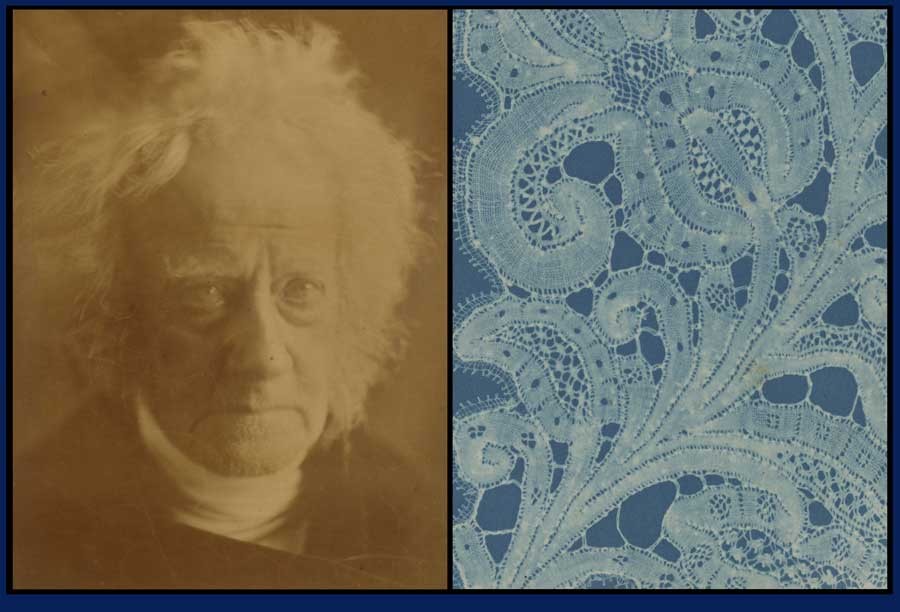 Left: Detail: "John Frederick William Herschel"(1792-1871): Julia Margaret Cameron: British: Albumen print: 1867: image: 35.5 x 27.1 cm (sight): The Cyanotype, or blueprint process, was first invented by John Herschel in 1842. It involves first exposing a negative, oftentimes through the contact print method with paper (or even cloth or another matrix) first treated with ammonium ferric citrate. In daylight, the matrix is then developed using a solution of potassium ferricyanide. The resulting print reveals itself as a brilliant blue hue known as Prussian blue. (ferric iron compounds being changed into ferrous iron). From: PhotoSeed Archive. Right: Detail: "Braid and Thread Lace": Julia Herschel: British : (1842-1933 ) : cyanotype: 1869 or before. It's intriguing to know the inventors daughter used the process herself (John Herschel was known to only use his blueprint process to reproduce notes and diagrams) to create artistic statements, like this original photograph bound with the volume: A Handbook for Greek and Roman Lace Making published in London in 1869 and printed by R. Barrett and Sons. From: Spencer Collection, The New York Public Library. "A handbook for Greek and Roman lace making" The New York Public Library Digital Collections. 1869. http://digitalcollections.nypl.org/items/7dd58e00-0898-0133-038f-58d385a7bbd0
Left: Detail: "John Frederick William Herschel"(1792-1871): Julia Margaret Cameron: British: Albumen print: 1867: image: 35.5 x 27.1 cm (sight): The Cyanotype, or blueprint process, was first invented by John Herschel in 1842. It involves first exposing a negative, oftentimes through the contact print method with paper (or even cloth or another matrix) first treated with ammonium ferric citrate. In daylight, the matrix is then developed using a solution of potassium ferricyanide. The resulting print reveals itself as a brilliant blue hue known as Prussian blue. (ferric iron compounds being changed into ferrous iron). From: PhotoSeed Archive. Right: Detail: "Braid and Thread Lace": Julia Herschel: British : (1842-1933 ) : cyanotype: 1869 or before. It's intriguing to know the inventors daughter used the process herself (John Herschel was known to only use his blueprint process to reproduce notes and diagrams) to create artistic statements, like this original photograph bound with the volume: A Handbook for Greek and Roman Lace Making published in London in 1869 and printed by R. Barrett and Sons. From: Spencer Collection, The New York Public Library. "A handbook for Greek and Roman lace making" The New York Public Library Digital Collections. 1869. http://digitalcollections.nypl.org/items/7dd58e00-0898-0133-038f-58d385a7bbd0
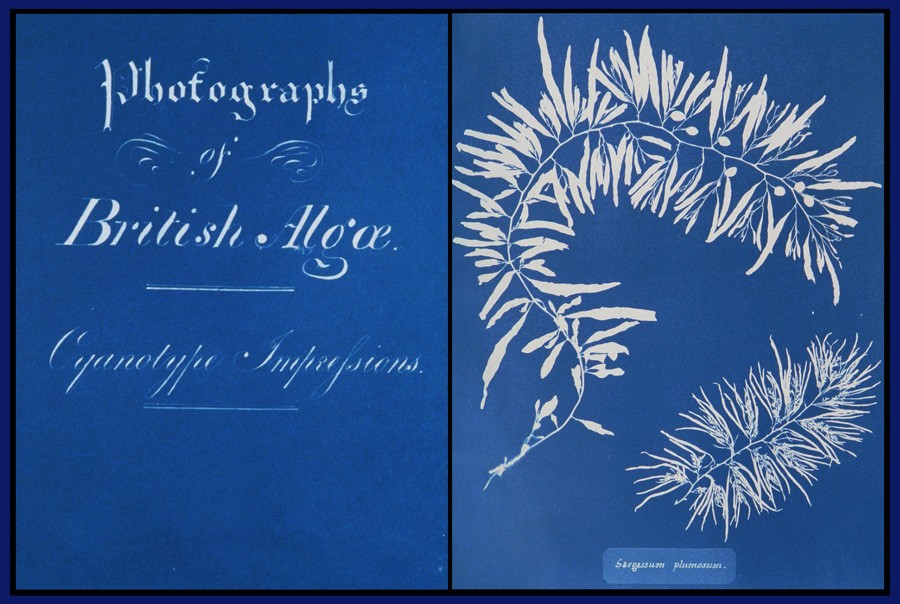 Left: Detail: "Title Page": from: Photographs of British Algae: Cyanotype Impressions: Anna Atkins: British: (1799-1871) : cyanotype: 1843-1853. This title page in the author's own hand is part of a multi-part volume of 231 original cyanotypes featuring contact prints of British seaweed specimens first copied on individual glass sheets by William Henry Fox Talbot's photogenic drawing method by Atkins and then reproduced by John Herschel's newly invented cyanotype or blueprinting process. The importance of the work is summed up by The New York Public Library, which owns this rare volume formerly in the library of Herschel: "Photographs of British Algae is a landmark in the histories both of photography and of publishing: the first photographic work by a woman, and the first book produced entirely by photographic means." From: Spencer Collection, The New York Public Library. "Titlepage." The New York Public Library Digital Collections. 1843 - 1853. http://digitalcollections.nypl.org/items/510d47d9-4af4-a3d9-e040-e00a18064a99. Right: Detail: "Sargassum plumosum":from: Photographs of British Algae: Cyanotype Impressions: Anna Atkins: British: (1799-1871) : cyanotype: 1843-1853. These beautiful seaweed specimens was the second plate in the pagination for Vol. 1 of "British Algae". From: Spencer Collection, The New York Public Library. "Sargassum plumosum." The New York Public Library Digital Collections. 1843 - 1853. http://digitalcollections.nypl.org/items/510d47d9-4af6-a3d9-e040-e00a18064a99
Left: Detail: "Title Page": from: Photographs of British Algae: Cyanotype Impressions: Anna Atkins: British: (1799-1871) : cyanotype: 1843-1853. This title page in the author's own hand is part of a multi-part volume of 231 original cyanotypes featuring contact prints of British seaweed specimens first copied on individual glass sheets by William Henry Fox Talbot's photogenic drawing method by Atkins and then reproduced by John Herschel's newly invented cyanotype or blueprinting process. The importance of the work is summed up by The New York Public Library, which owns this rare volume formerly in the library of Herschel: "Photographs of British Algae is a landmark in the histories both of photography and of publishing: the first photographic work by a woman, and the first book produced entirely by photographic means." From: Spencer Collection, The New York Public Library. "Titlepage." The New York Public Library Digital Collections. 1843 - 1853. http://digitalcollections.nypl.org/items/510d47d9-4af4-a3d9-e040-e00a18064a99. Right: Detail: "Sargassum plumosum":from: Photographs of British Algae: Cyanotype Impressions: Anna Atkins: British: (1799-1871) : cyanotype: 1843-1853. These beautiful seaweed specimens was the second plate in the pagination for Vol. 1 of "British Algae". From: Spencer Collection, The New York Public Library. "Sargassum plumosum." The New York Public Library Digital Collections. 1843 - 1853. http://digitalcollections.nypl.org/items/510d47d9-4af6-a3d9-e040-e00a18064a99
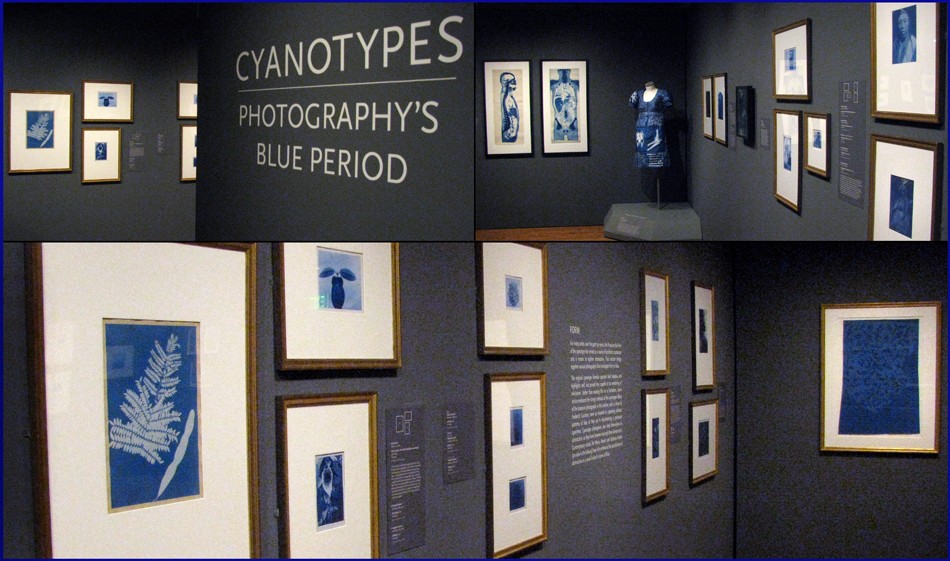 Composite: April, 2016 installation photographs from exhibit: "Cyanotypes: Photography's Blue Period" at the Worcester Art Museum in Worcester, MA. Running from January 16-April 24, 2016, the show was the first comprehensive exhibit on the medium of cyanotype ever held in the United States. Vintage examples from the museum's own holdings as well as loans from other institutions and private individuals spanned the period from the 1850's to the first decade of the 21st Century. The exhibit was curated by Nancy Kathryn Burns, Assistant Curator of Prints, Drawings, and Photographs at the museum & Kristina Wilson, Associate Professor of Art History, Clark University. Both additionally edited the volume: "Cyanotypes: Photography's Blue Period" published by the museum: ISBN# 978-0-936042-06-0. Installation photographs by David Spencer for PhotoSeed Archive
Composite: April, 2016 installation photographs from exhibit: "Cyanotypes: Photography's Blue Period" at the Worcester Art Museum in Worcester, MA. Running from January 16-April 24, 2016, the show was the first comprehensive exhibit on the medium of cyanotype ever held in the United States. Vintage examples from the museum's own holdings as well as loans from other institutions and private individuals spanned the period from the 1850's to the first decade of the 21st Century. The exhibit was curated by Nancy Kathryn Burns, Assistant Curator of Prints, Drawings, and Photographs at the museum & Kristina Wilson, Associate Professor of Art History, Clark University. Both additionally edited the volume: "Cyanotypes: Photography's Blue Period" published by the museum: ISBN# 978-0-936042-06-0. Installation photographs by David Spencer for PhotoSeed Archive
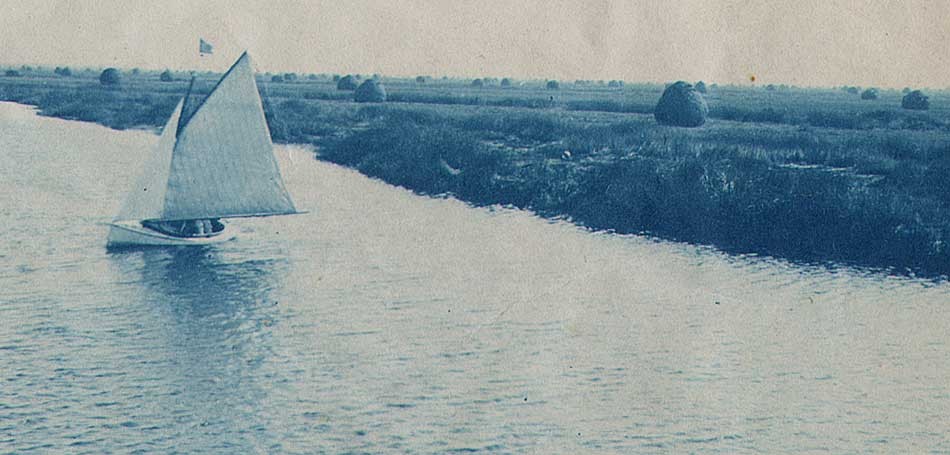 Detail: "Sailboat near Plum Island" : anonymous American photographer: cyanotype: 1895-1900: 9.2 x 12.5 cm: The location of this photograph has been determined to be Plum Island Sound (the Parker River) in Newburyport, Mass, on Boston's North Shore. In the distance can be seen many salt marsh haystacks. From: PhotoSeed Archive
Detail: "Sailboat near Plum Island" : anonymous American photographer: cyanotype: 1895-1900: 9.2 x 12.5 cm: The location of this photograph has been determined to be Plum Island Sound (the Parker River) in Newburyport, Mass, on Boston's North Shore. In the distance can be seen many salt marsh haystacks. From: PhotoSeed Archive
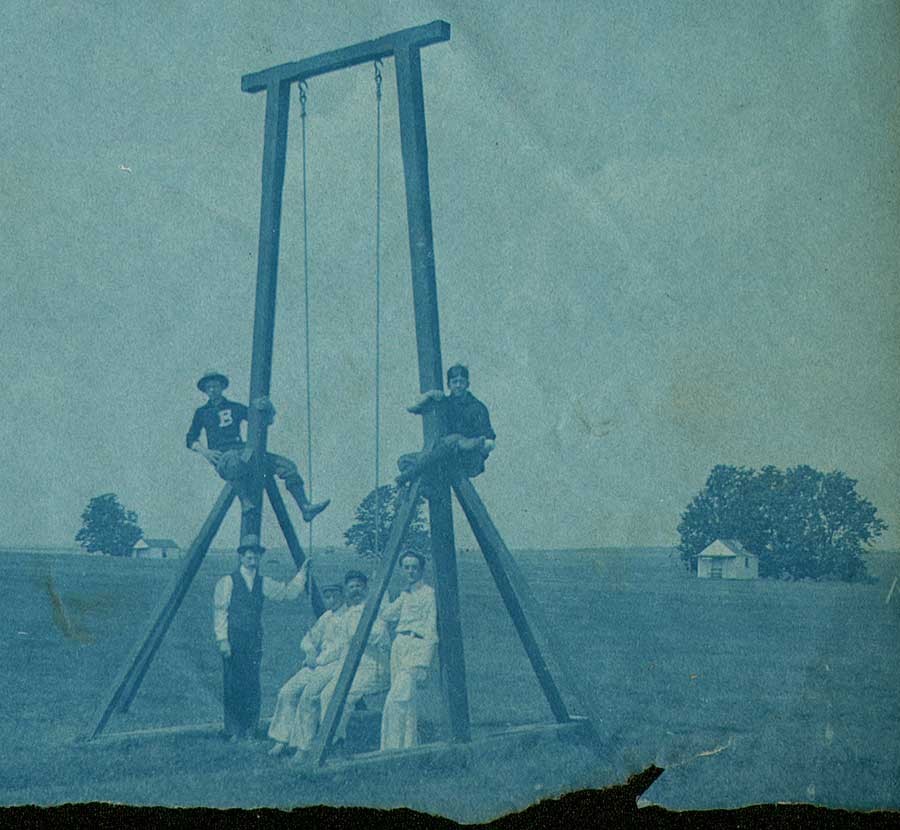 Detail: "Portrait Grouping with Tall Wooden Swing" : anonymous American photographer: cyanotype: 1895-1900: 8.5 x 11.5 cm: Most likely taken within the Plum Island area of Newburyport, Mass., (by the same photographer as it was included in small album of views as previous post photographs) this intriguing photograph shows an oversized wooden swing within a mowed field. One theory for the size of this swing would be because tidal changes could submerge the structure. Note lower margin of photograph where it was torn to fit a pre-cut window within a small album. From: PhotoSeed Archive
Detail: "Portrait Grouping with Tall Wooden Swing" : anonymous American photographer: cyanotype: 1895-1900: 8.5 x 11.5 cm: Most likely taken within the Plum Island area of Newburyport, Mass., (by the same photographer as it was included in small album of views as previous post photographs) this intriguing photograph shows an oversized wooden swing within a mowed field. One theory for the size of this swing would be because tidal changes could submerge the structure. Note lower margin of photograph where it was torn to fit a pre-cut window within a small album. From: PhotoSeed Archive
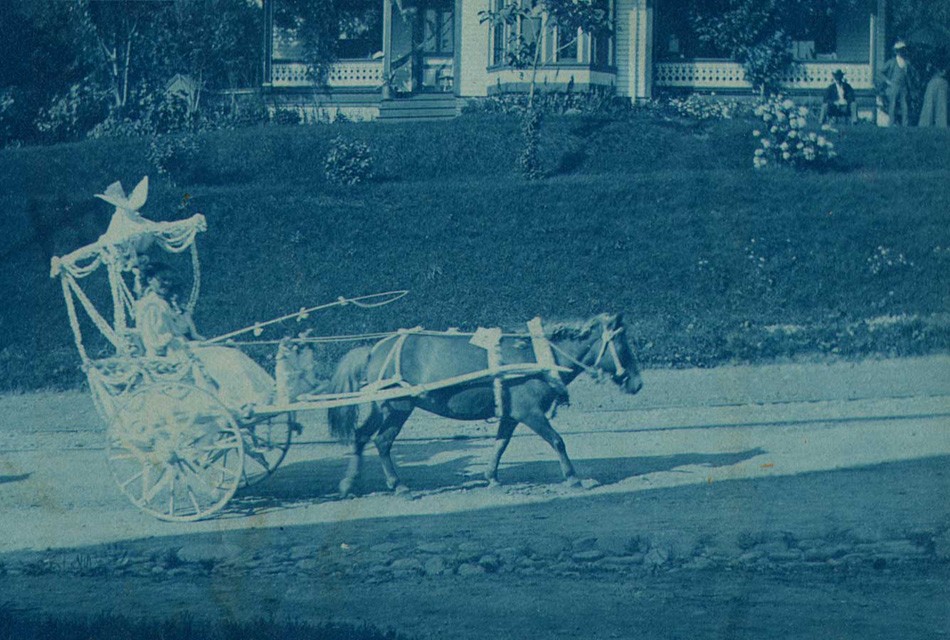 Detail: "Pony Cart in Parade" : anonymous American photographer: cyanotype: 1895-1900: 8.8 x 11.4 cm: Most likely taken in or near Newburyport, Mass., (by the same photographer as it was included in small album of views as previous post photographs) this slice of small-town American life shows a pony pulling a floral-decorated cart guided by a young lady traveling down a dirt road, perhaps on Memorial Day. Above can be seen a Victorian home with three parade watchers who stand at upper right. A set of trolley tracks can be seen in road beyond horse. From: PhotoSeed Archive
Detail: "Pony Cart in Parade" : anonymous American photographer: cyanotype: 1895-1900: 8.8 x 11.4 cm: Most likely taken in or near Newburyport, Mass., (by the same photographer as it was included in small album of views as previous post photographs) this slice of small-town American life shows a pony pulling a floral-decorated cart guided by a young lady traveling down a dirt road, perhaps on Memorial Day. Above can be seen a Victorian home with three parade watchers who stand at upper right. A set of trolley tracks can be seen in road beyond horse. From: PhotoSeed Archive
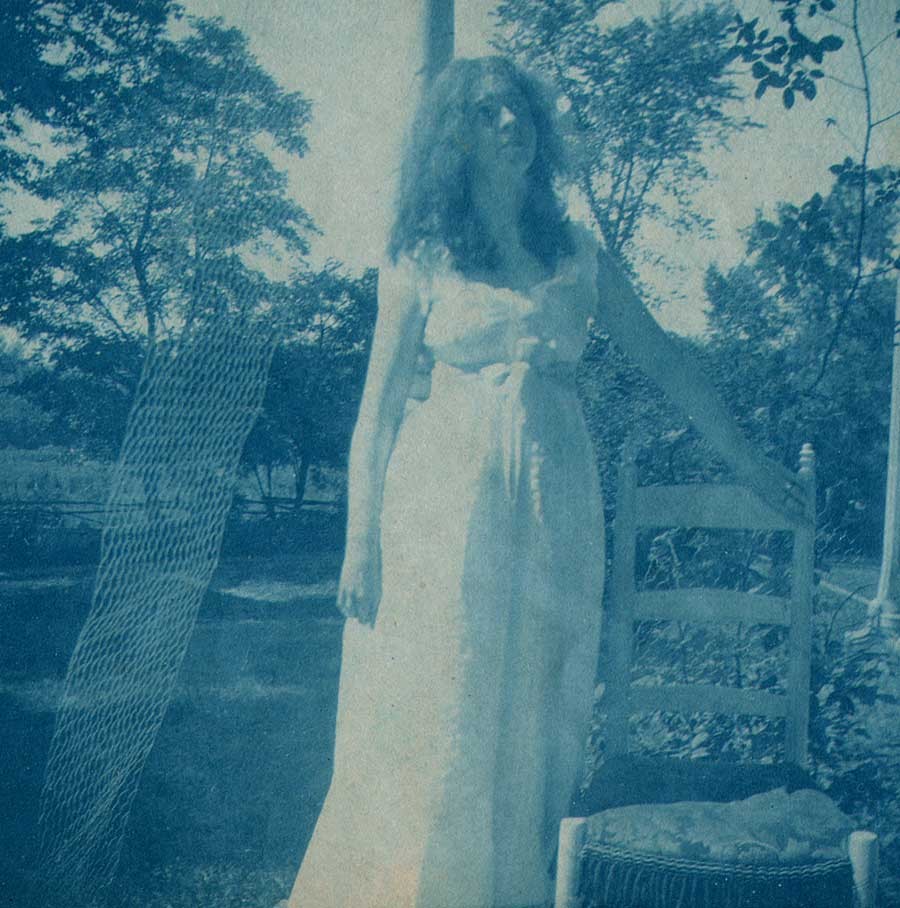 Detail: "Woman in White Dress Standing next to Chair" : anonymous American photographer: cyanotype: 1895-1900: 8.3 x 8.5 cm: Her name perhaps lost to history, a young woman wearing a white dress stands on a porch and looks away from the camera: a most unusual genre pose indicating she may have been playing a role of some type: for a play? or as an honored guest who had taken part in the parade depicted in the previous photograph? This view also likely taken in or near Newburyport, Mass. (and was included in the same small album of views as previous post photographs) From: PhotoSeed Archive
Detail: "Woman in White Dress Standing next to Chair" : anonymous American photographer: cyanotype: 1895-1900: 8.3 x 8.5 cm: Her name perhaps lost to history, a young woman wearing a white dress stands on a porch and looks away from the camera: a most unusual genre pose indicating she may have been playing a role of some type: for a play? or as an honored guest who had taken part in the parade depicted in the previous photograph? This view also likely taken in or near Newburyport, Mass. (and was included in the same small album of views as previous post photographs) From: PhotoSeed Archive
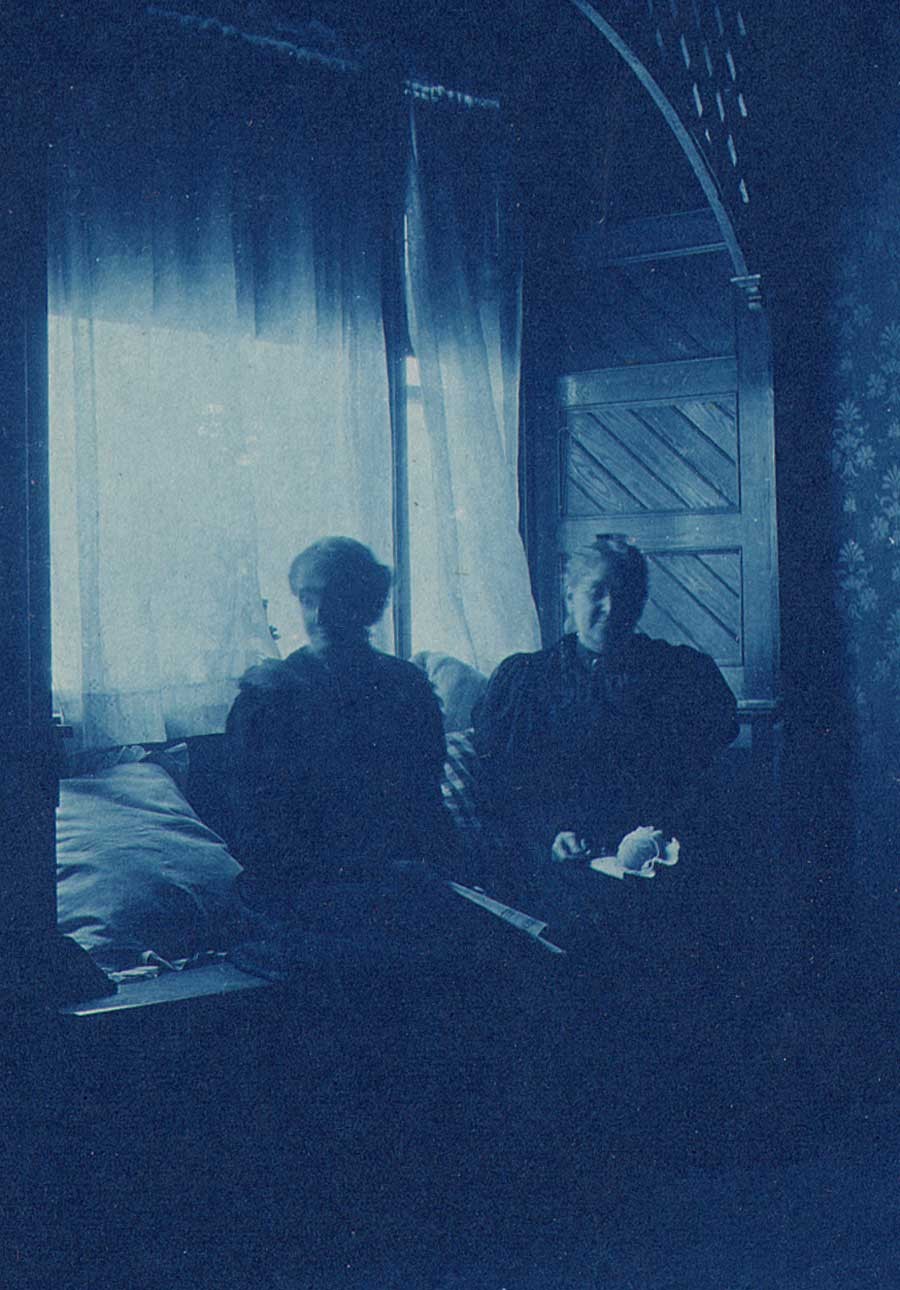 Detail: "Portrait Study near Window" : anonymous American photographer: cyanotype: 1899: 9.7 x 6.3 cm: Most likely sisters, this moody interior portrait is unusual for amateur work of the period because the photographer instructed his subjects to avert their gaze to the camera. The woman at left holds what is believed to be a folded fan while her companion holds a ball of yarn in her lap. Photograph may have been additionally printed on commercially available presensitized Venus paper manufactured by the Peerless Blue Print Co., as it was included in a cardboard box of this brand with an expiration date of 1899. Location for this image may have been the midwestern United States, as it was included in this Peerless box of loose cyanotypes purchased from an Indiana seller. From: PhotoSeed Archive
Detail: "Portrait Study near Window" : anonymous American photographer: cyanotype: 1899: 9.7 x 6.3 cm: Most likely sisters, this moody interior portrait is unusual for amateur work of the period because the photographer instructed his subjects to avert their gaze to the camera. The woman at left holds what is believed to be a folded fan while her companion holds a ball of yarn in her lap. Photograph may have been additionally printed on commercially available presensitized Venus paper manufactured by the Peerless Blue Print Co., as it was included in a cardboard box of this brand with an expiration date of 1899. Location for this image may have been the midwestern United States, as it was included in this Peerless box of loose cyanotypes purchased from an Indiana seller. From: PhotoSeed Archive
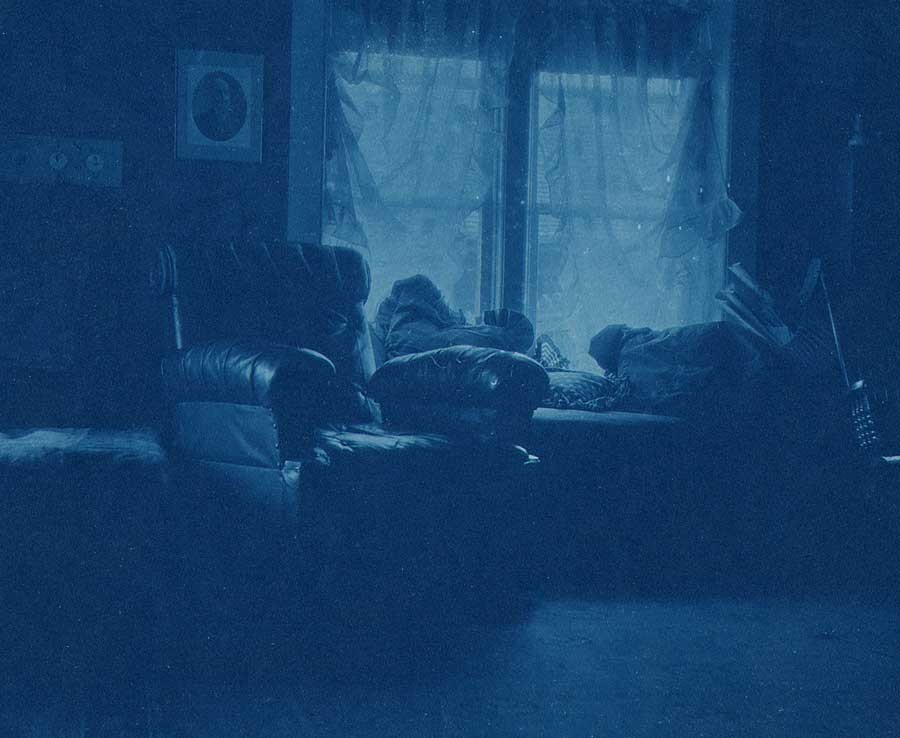 Detail: "Favorite Chair near Window" : anonymous American photographer: cyanotype: 1899: 9.4 x 12.0 cm: Another moody interior portrait, this time absent of any human subjects, is nonetheless interesting due to the feeling it evokes with the framed portrait of the bearded gentleman on the wall above what might be or was his favorite living room cushioned chair. Photograph may have been additionally printed on commercially available presensitized Venus paper manufactured by the Peerless Blue Print Co., as it was included in a cardboard box of this brand with an expiration date of 1899. Location for this image may have been the midwestern United States, as it was included in this Peerless box of loose cyanotypes purchased from an Indiana seller. From: PhotoSeed Archive
Detail: "Favorite Chair near Window" : anonymous American photographer: cyanotype: 1899: 9.4 x 12.0 cm: Another moody interior portrait, this time absent of any human subjects, is nonetheless interesting due to the feeling it evokes with the framed portrait of the bearded gentleman on the wall above what might be or was his favorite living room cushioned chair. Photograph may have been additionally printed on commercially available presensitized Venus paper manufactured by the Peerless Blue Print Co., as it was included in a cardboard box of this brand with an expiration date of 1899. Location for this image may have been the midwestern United States, as it was included in this Peerless box of loose cyanotypes purchased from an Indiana seller. From: PhotoSeed Archive
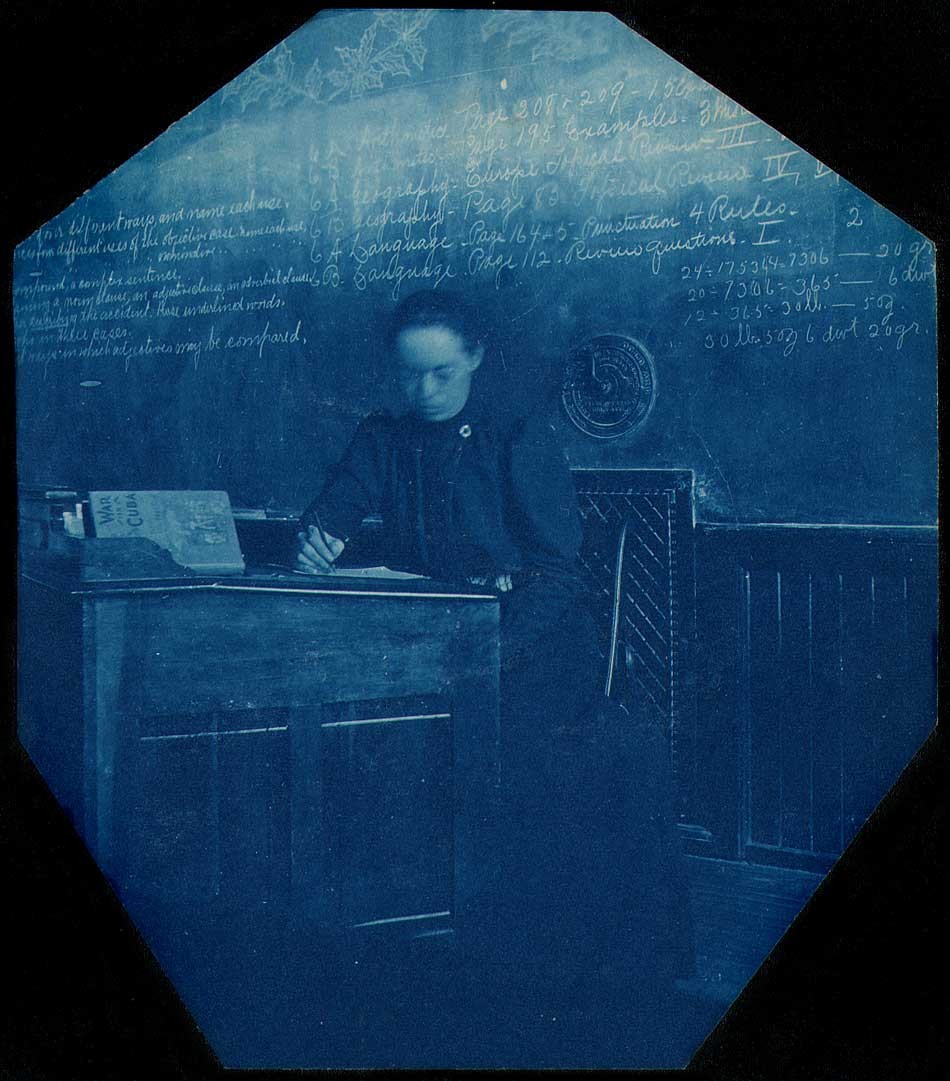 "Schoolteacher at Desk" : anonymous American photographer: cyanotype: 1899 or before: 10.5 x 9.1 cm: With slight motion blur seen in her face, a schoolteacher holding a pencil works on papers at her desk in front of a large blackboard listing student lesson plans including Arithmetic, Geography (Europe topical review) and Language, (Punctuation-4 rules) with additional lesson plans at left outlining sentence structures. The 1896 volume: The War in Cuba, Being a Full Account of Her Great Struggle for Freedom can be seen on the desk at left. A chalk drawing of holly leaves is at very top of blackboard, so view may date to the Christmas holiday of 1898. Photograph may have been additionally printed on commercially available presensitized Venus paper manufactured by the Peerless Blue Print Co., as it was included in a cardboard box of this brand with an expiration date of 1899. Location may have been the midwestern U.S., as it was purchased with other cyanotypes from an Indiana seller. From: PhotoSeed Archive
"Schoolteacher at Desk" : anonymous American photographer: cyanotype: 1899 or before: 10.5 x 9.1 cm: With slight motion blur seen in her face, a schoolteacher holding a pencil works on papers at her desk in front of a large blackboard listing student lesson plans including Arithmetic, Geography (Europe topical review) and Language, (Punctuation-4 rules) with additional lesson plans at left outlining sentence structures. The 1896 volume: The War in Cuba, Being a Full Account of Her Great Struggle for Freedom can be seen on the desk at left. A chalk drawing of holly leaves is at very top of blackboard, so view may date to the Christmas holiday of 1898. Photograph may have been additionally printed on commercially available presensitized Venus paper manufactured by the Peerless Blue Print Co., as it was included in a cardboard box of this brand with an expiration date of 1899. Location may have been the midwestern U.S., as it was purchased with other cyanotypes from an Indiana seller. From: PhotoSeed Archive
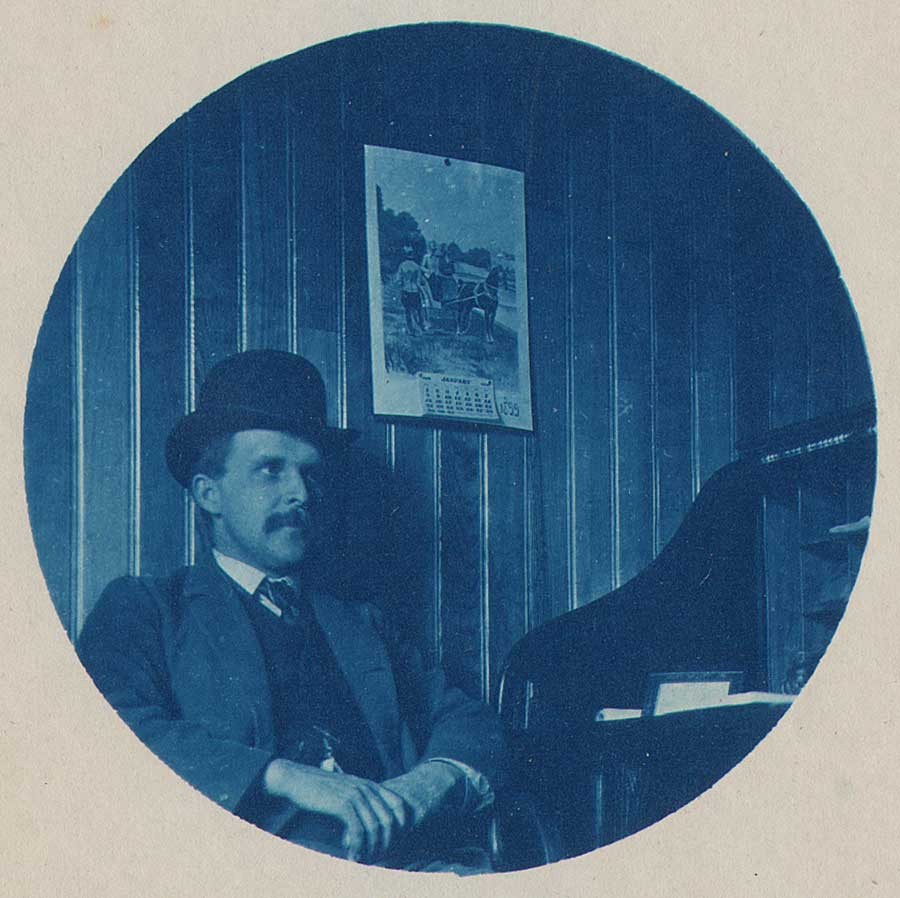 "Man with Bowler hat at Desk": : anonymous American photographer: cyanotype: 1899: 6.5 cm round | 11.3 x 8.8 cm: Possibly a self-portrait, a man wearing a bowler hat seated next to a desk stares away from the camera. A calendar featuring artwork of a horse preparing to pull a two-wheel cart dated January, 1899 hangs on the wall. Photograph may have been additionally printed on commercially available presensitized Venus paper manufactured by the Peerless Blue Print Co., as it was included in a cardboard box of this brand with an expiration date of 1899. Location may have been the midwestern U.S., as it was purchased with other cyanotypes from an Indiana seller. From: PhotoSeed Archive
"Man with Bowler hat at Desk": : anonymous American photographer: cyanotype: 1899: 6.5 cm round | 11.3 x 8.8 cm: Possibly a self-portrait, a man wearing a bowler hat seated next to a desk stares away from the camera. A calendar featuring artwork of a horse preparing to pull a two-wheel cart dated January, 1899 hangs on the wall. Photograph may have been additionally printed on commercially available presensitized Venus paper manufactured by the Peerless Blue Print Co., as it was included in a cardboard box of this brand with an expiration date of 1899. Location may have been the midwestern U.S., as it was purchased with other cyanotypes from an Indiana seller. From: PhotoSeed Archive
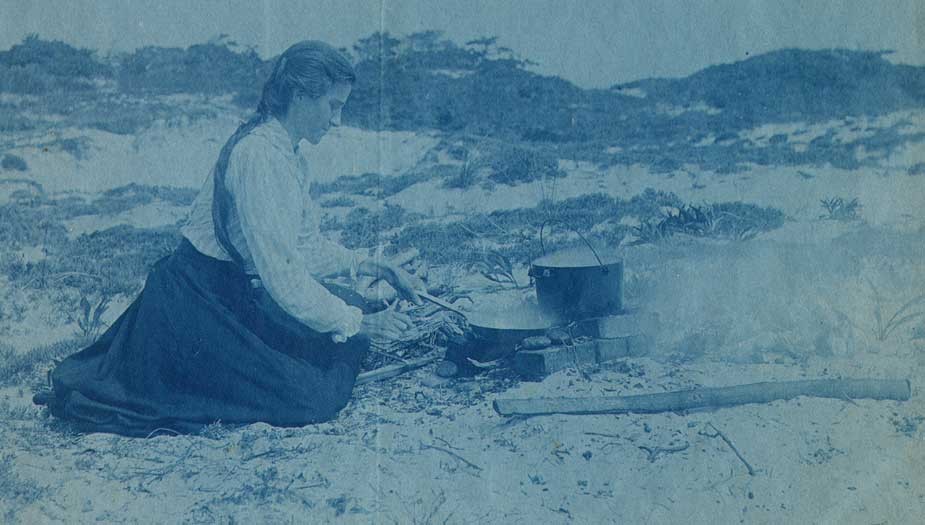 Detail: "Mother cooks at Point O' Woods LI": Charles Rollins Tucker: American: cyanotype: 1899: 12.5 x 17.3 cm: Mary (Carruthers) Tucker,(1870-1940) the spouse of amateur photographer C.R. Tucker, cooks on the beach at Point O'Woods. Wikipedia states this private retreat-even today- may have been the first settlement on Fire Island in Long Island Sound, and was originally organized in 1894 for religious retreats, some from the Chautauqua assemblies before ownership passed to the present-day Point O' Woods Association in 1898 after the first group went bankrupt. From: PhotoSeed Archive
Detail: "Mother cooks at Point O' Woods LI": Charles Rollins Tucker: American: cyanotype: 1899: 12.5 x 17.3 cm: Mary (Carruthers) Tucker,(1870-1940) the spouse of amateur photographer C.R. Tucker, cooks on the beach at Point O'Woods. Wikipedia states this private retreat-even today- may have been the first settlement on Fire Island in Long Island Sound, and was originally organized in 1894 for religious retreats, some from the Chautauqua assemblies before ownership passed to the present-day Point O' Woods Association in 1898 after the first group went bankrupt. From: PhotoSeed Archive
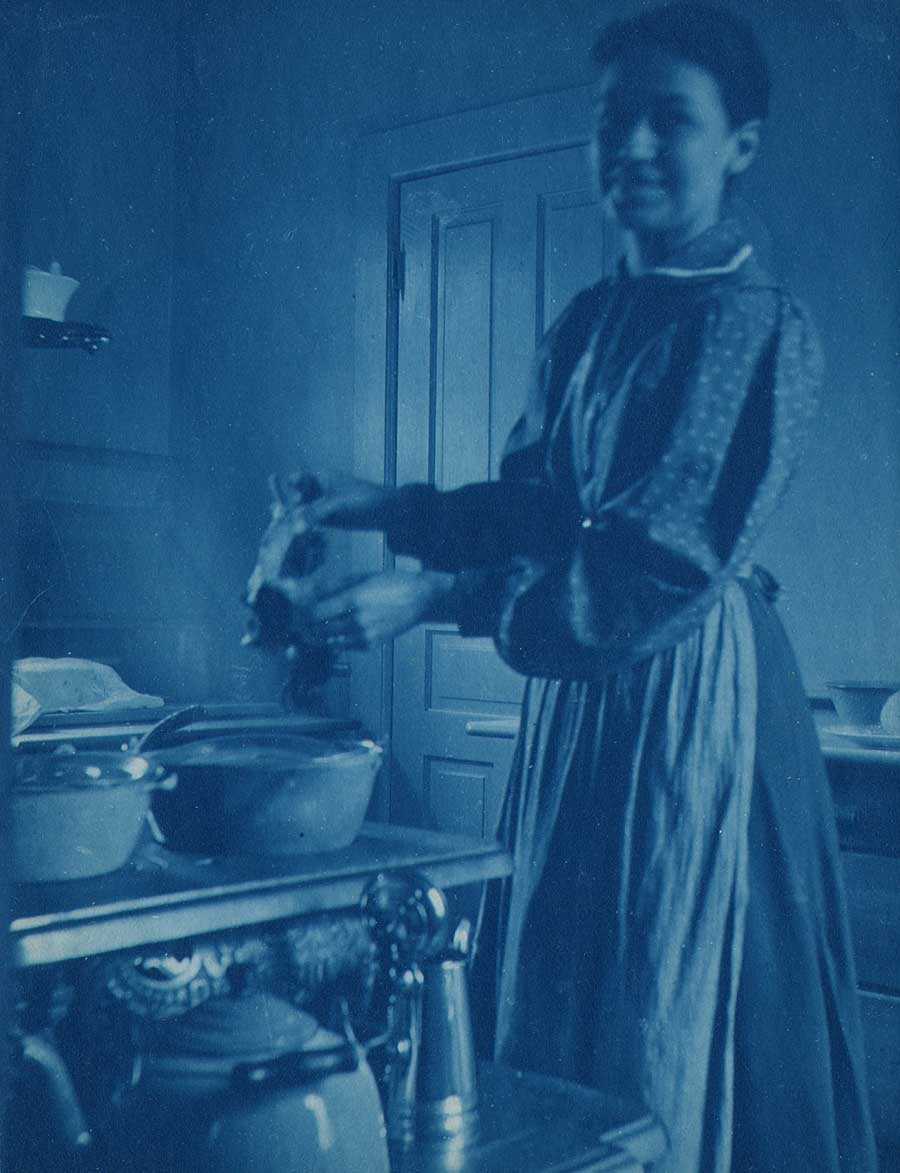 "Woman working in Kitchen" : anonymous American photographer: cyanotype: 1899: 11.9 x 9.2 cm: Wearing an apron and looking towards the camera, a woman prepares to place some type of food into a pot on a shelf above a stove while working in a home kitchen. Photograph may have been additionally printed on commercially available presensitized Venus paper manufactured by the Peerless Blue Print Co., as it was included in a cardboard box of this brand with an expiration date of 1899. Location may have been the midwestern U.S., as it was purchased with other cyanotypes from an Indiana seller. From: PhotoSeed Archive
"Woman working in Kitchen" : anonymous American photographer: cyanotype: 1899: 11.9 x 9.2 cm: Wearing an apron and looking towards the camera, a woman prepares to place some type of food into a pot on a shelf above a stove while working in a home kitchen. Photograph may have been additionally printed on commercially available presensitized Venus paper manufactured by the Peerless Blue Print Co., as it was included in a cardboard box of this brand with an expiration date of 1899. Location may have been the midwestern U.S., as it was purchased with other cyanotypes from an Indiana seller. From: PhotoSeed Archive
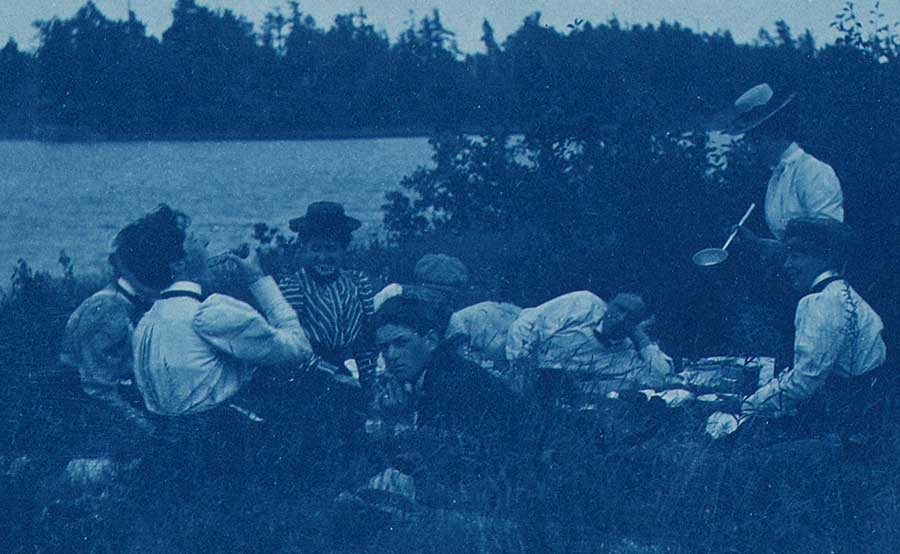 Detail: "Picnickers enjoy a Meal": anonymous American photographer: cyanotype: 1899: 8.0 x 10.6 | 9.9 x 12.5 cm: A party of seven fashionably-dressed men and women enjoy a picnic outing next to a lake. Photograph may have been additionally printed on commercially available presensitized Venus paper manufactured by the Peerless Blue Print Co., as it was included in a cardboard box of this brand with an expiration date of 1899. Location may have been the midwestern U.S., as it was purchased with other cyanotypes from an Indiana seller. From: PhotoSeed Archive
Detail: "Picnickers enjoy a Meal": anonymous American photographer: cyanotype: 1899: 8.0 x 10.6 | 9.9 x 12.5 cm: A party of seven fashionably-dressed men and women enjoy a picnic outing next to a lake. Photograph may have been additionally printed on commercially available presensitized Venus paper manufactured by the Peerless Blue Print Co., as it was included in a cardboard box of this brand with an expiration date of 1899. Location may have been the midwestern U.S., as it was purchased with other cyanotypes from an Indiana seller. From: PhotoSeed Archive
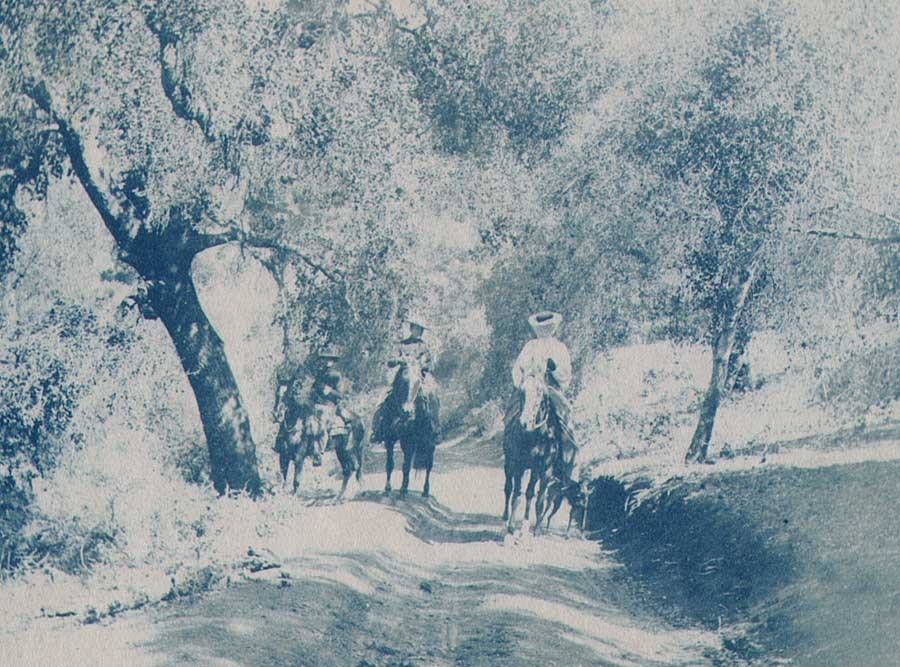 Detail: "Horseback Trail Ride": anonymous American photographer: cyanotype: 1899: 9.0 x 11.2 cm: Two men on horseback, who appear to be in military uniform at left, and a woman rider wearing mosquito netting over her hat and accompanied by a canine Whippet, stop for a moment in sunlight on a rural forest riding trail. Photograph may have been additionally printed on commercially available presensitized Venus paper manufactured by the Peerless Blue Print Co., as it was included in a cardboard box of this brand with an expiration date of 1899. Location may have been the midwestern U.S., as it was purchased with other cyanotypes from an Indiana seller. From: PhotoSeed Archive
Detail: "Horseback Trail Ride": anonymous American photographer: cyanotype: 1899: 9.0 x 11.2 cm: Two men on horseback, who appear to be in military uniform at left, and a woman rider wearing mosquito netting over her hat and accompanied by a canine Whippet, stop for a moment in sunlight on a rural forest riding trail. Photograph may have been additionally printed on commercially available presensitized Venus paper manufactured by the Peerless Blue Print Co., as it was included in a cardboard box of this brand with an expiration date of 1899. Location may have been the midwestern U.S., as it was purchased with other cyanotypes from an Indiana seller. From: PhotoSeed Archive
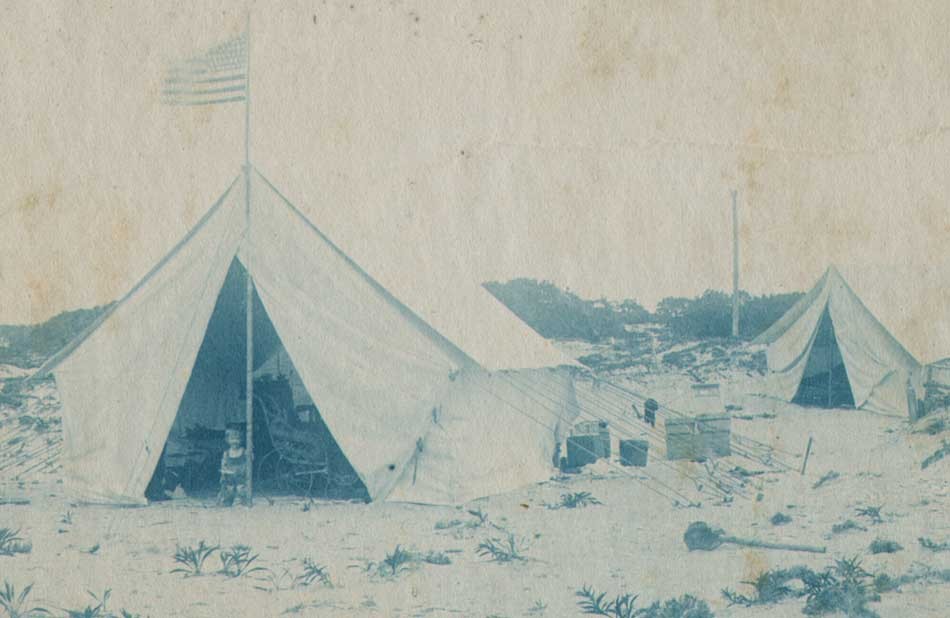 Detail: "Dorothy Tucker at Point O' Woods Beach Camp": Charles Rollins Tucker: American: cyanotype: 1901: 11.5 x 17.5 cm: Dorothy Tucker, (1899-1986) who appears to be no older than two years old, the young daughter of amateur photographer C.R. Tucker, stands at the entrance to a large canvas tent with American flag flying overhead on the beach at Point O' Woods. Wikipedia states this private retreat-even today- may have been the first settlement on Fire Island in Long Island Sound, and was originally organized in 1894 for religious retreats, some from the Chautauqua assemblies before ownership passed to the present-day Point O' Woods Association in 1898 after the first group went bankrupt. From: PhotoSeed Archive
Detail: "Dorothy Tucker at Point O' Woods Beach Camp": Charles Rollins Tucker: American: cyanotype: 1901: 11.5 x 17.5 cm: Dorothy Tucker, (1899-1986) who appears to be no older than two years old, the young daughter of amateur photographer C.R. Tucker, stands at the entrance to a large canvas tent with American flag flying overhead on the beach at Point O' Woods. Wikipedia states this private retreat-even today- may have been the first settlement on Fire Island in Long Island Sound, and was originally organized in 1894 for religious retreats, some from the Chautauqua assemblies before ownership passed to the present-day Point O' Woods Association in 1898 after the first group went bankrupt. From: PhotoSeed Archive
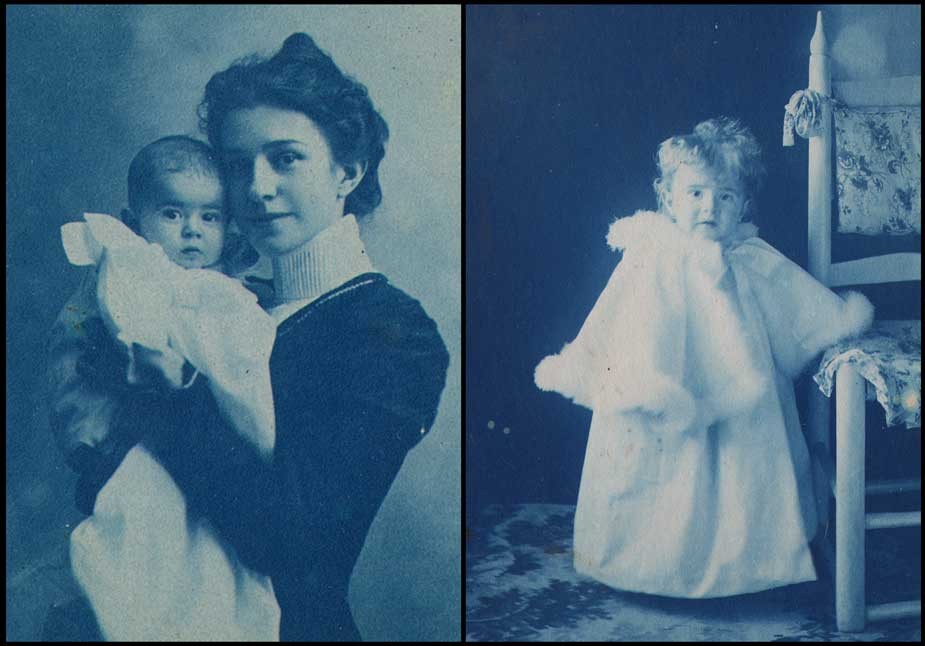 Left: Detail: "Baby Dorothy Tucker with Mother": Charles Rollins Tucker: American: cyanotype: 1899: 7.0 x 5.4 cm: Right: "Dorothy Tucker dressed in Fur-Trimmed Coat Next to Chair": Charles Rollins Tucker: American: cyanotype: 1900: 12.2 x 8.6 cm: Born in August of 1899 on New York's Staten Island, Dorothy Tucker was a constant subject for her father-a high school physics teacher at Curtis High School on the island-who trained his camera on her from birth to late teens. As a cyanotype, the photo showing Dorothy with her mother Mary Tucker (1870-1940) at left was thought well enough to frame behind glass as a family keepsake, lending credibility to the fact the process was not just considered a first way of proofing photos before a final selection was made. Instead, with the sequence shown in this post of four formal portraits of Dorothy as cyanotypes, the process was readily embraced by certain amateurs like Tucker. Both from: PhotoSeed Archive
Left: Detail: "Baby Dorothy Tucker with Mother": Charles Rollins Tucker: American: cyanotype: 1899: 7.0 x 5.4 cm: Right: "Dorothy Tucker dressed in Fur-Trimmed Coat Next to Chair": Charles Rollins Tucker: American: cyanotype: 1900: 12.2 x 8.6 cm: Born in August of 1899 on New York's Staten Island, Dorothy Tucker was a constant subject for her father-a high school physics teacher at Curtis High School on the island-who trained his camera on her from birth to late teens. As a cyanotype, the photo showing Dorothy with her mother Mary Tucker (1870-1940) at left was thought well enough to frame behind glass as a family keepsake, lending credibility to the fact the process was not just considered a first way of proofing photos before a final selection was made. Instead, with the sequence shown in this post of four formal portraits of Dorothy as cyanotypes, the process was readily embraced by certain amateurs like Tucker. Both from: PhotoSeed Archive
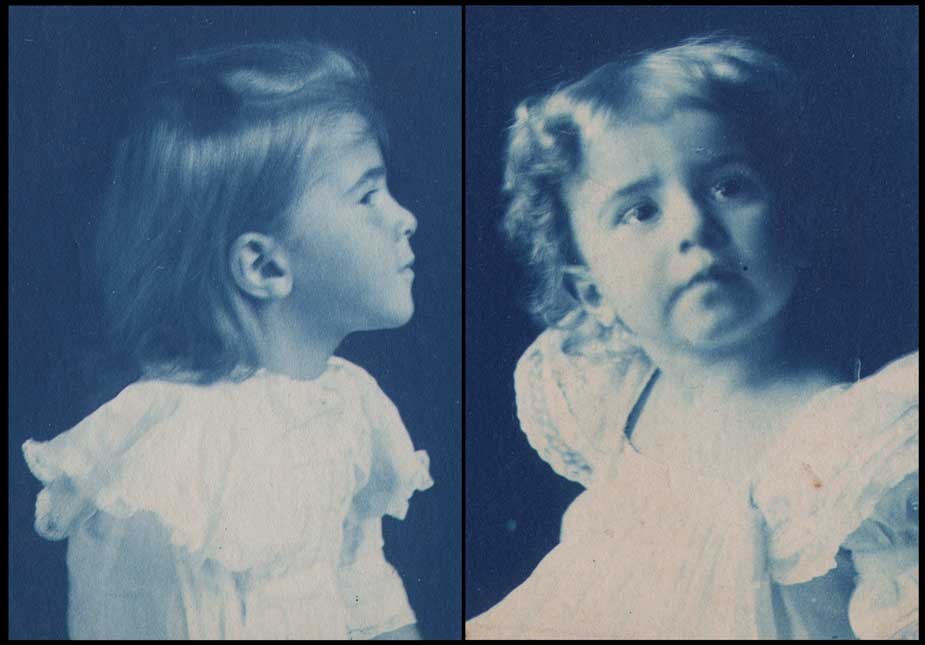 Left: "Dorothy Tucker Profile": Charles Rollins Tucker: American: cyanotype: ca. 1903: 9.9 x 7.2 cm: Right: "Portrait of Dorothy Tucker": Charles Rollins Tucker: American: cyanotype: ca. 1903: 9.3 x 6.9 | 17.8 x 12.8 cm. Born in August of 1899 on New York's Staten Island, Dorothy Tucker was a constant subject for her father-a high school physics teacher at Curtis High School on the island-who trained his camera on her from birth to late teens. Unlike many of the examples of Dorothy held by PhotoSeed that lack a mount, the cyanotype portrait of her at right was center-glued to a gray exhibition card, with another variant example printed in platinum showing evidence of being exhibited. Both from: PhotoSeed Archive
Left: "Dorothy Tucker Profile": Charles Rollins Tucker: American: cyanotype: ca. 1903: 9.9 x 7.2 cm: Right: "Portrait of Dorothy Tucker": Charles Rollins Tucker: American: cyanotype: ca. 1903: 9.3 x 6.9 | 17.8 x 12.8 cm. Born in August of 1899 on New York's Staten Island, Dorothy Tucker was a constant subject for her father-a high school physics teacher at Curtis High School on the island-who trained his camera on her from birth to late teens. Unlike many of the examples of Dorothy held by PhotoSeed that lack a mount, the cyanotype portrait of her at right was center-glued to a gray exhibition card, with another variant example printed in platinum showing evidence of being exhibited. Both from: PhotoSeed Archive
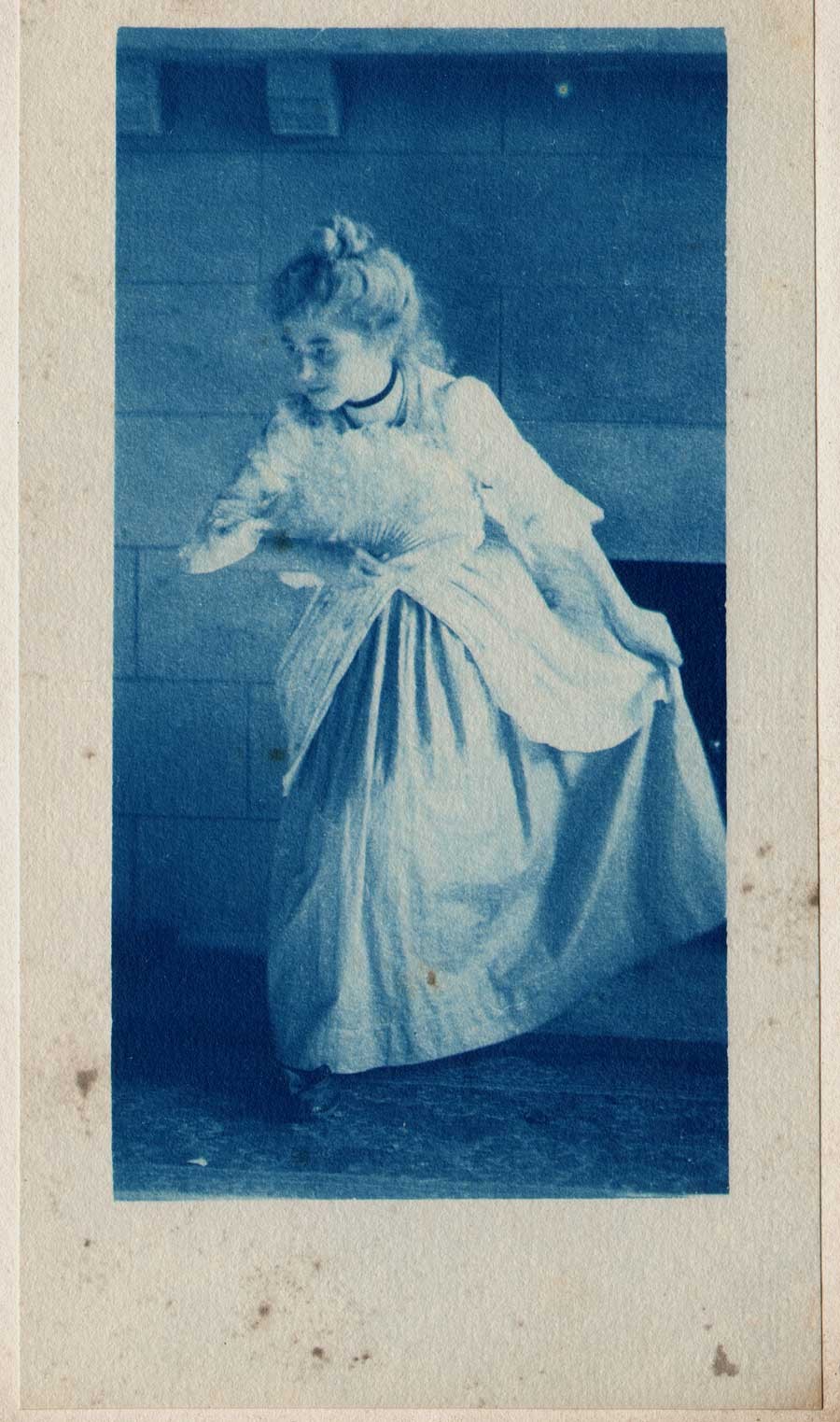 "Dorothy Tucker with Fan": presumed photographer: done in hand-inscribed, block letters: F.L.C.: American?: cyanotype: 1912: 16.5 x 8.6 | 22.0 x 11.3 cm: Shown presented within its tissue-guarded, ribbon tied folder, (22.6 x 12.3 cm) Dorothy Tucker, not quite 13 years old, strikes a pose with a fan inside her home on Staten Island, New York. She was most likely "performing" a part in a school play for "F.L.C.", presumed to be the photographer of this work who was certainly an acquaintance of Dorothy's amateur photographer father Charles Rollins Tucker. The presentation folder additionally dated in blue ink May 18, 1912 & annotated Dorothy Tucker in graphite along lower margin. From: PhotoSeed Archive
"Dorothy Tucker with Fan": presumed photographer: done in hand-inscribed, block letters: F.L.C.: American?: cyanotype: 1912: 16.5 x 8.6 | 22.0 x 11.3 cm: Shown presented within its tissue-guarded, ribbon tied folder, (22.6 x 12.3 cm) Dorothy Tucker, not quite 13 years old, strikes a pose with a fan inside her home on Staten Island, New York. She was most likely "performing" a part in a school play for "F.L.C.", presumed to be the photographer of this work who was certainly an acquaintance of Dorothy's amateur photographer father Charles Rollins Tucker. The presentation folder additionally dated in blue ink May 18, 1912 & annotated Dorothy Tucker in graphite along lower margin. From: PhotoSeed Archive
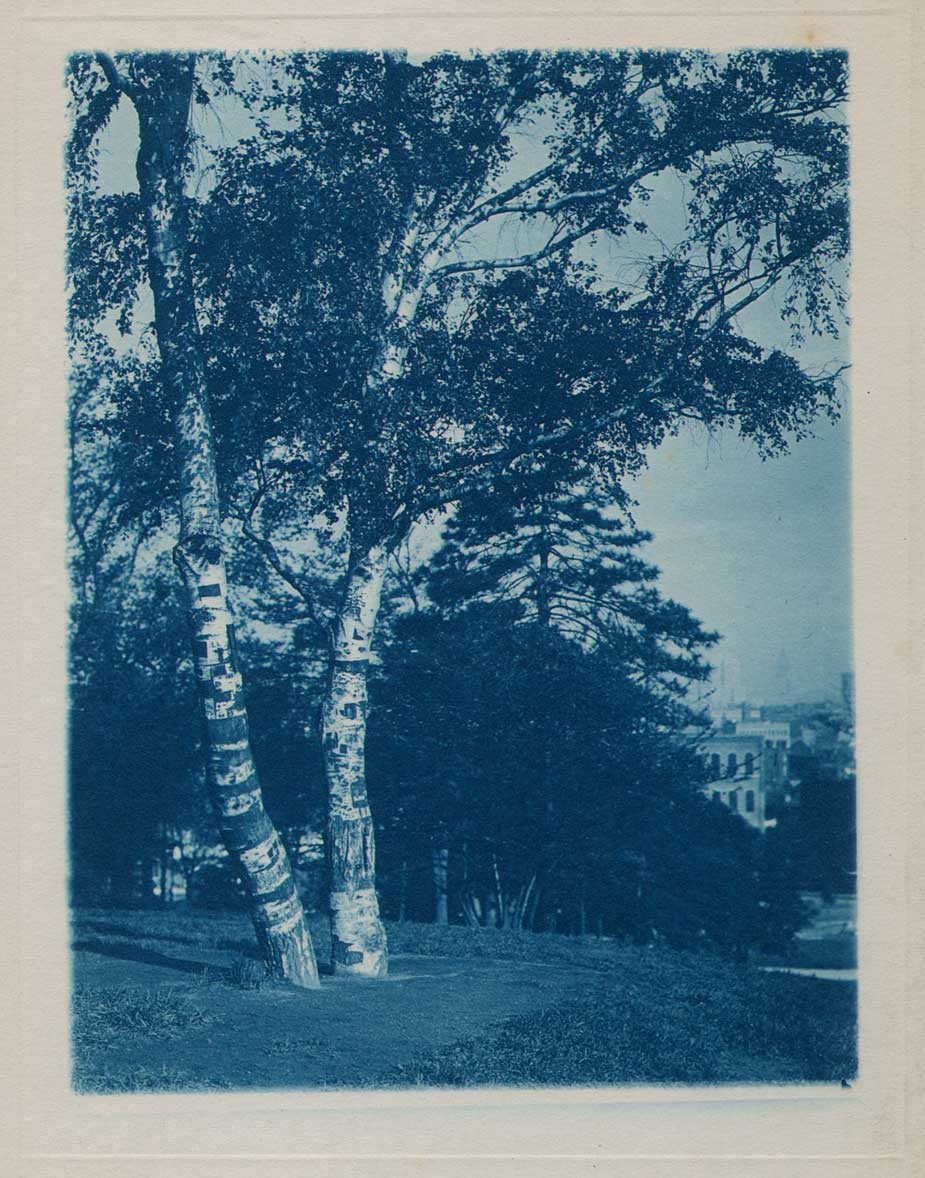 "White Birch Trees on Hill": by Unknown Brooklyn (photographer) : American: cyanotype: ca. 1905-10: 11.6 x 8.8 | 16.8 x 12.3 cm: A tantalizing backdrop of an unknown city can be seen in the distance at right of this cyanotype image featuring several sturdy white birch trees scarred in several places by penknives declaring true love. Possibly with a location of Prospect Park in Brooklyn, this photograph, with title supplied by this archive, is by an Unknown Brooklyn amateur photographer whose surviving work was discovered in a trunk in the American South. Background can be found by searching for this site's 2015 blog post: "No Junk in Trunk". From: PhotoSeed Archive
"White Birch Trees on Hill": by Unknown Brooklyn (photographer) : American: cyanotype: ca. 1905-10: 11.6 x 8.8 | 16.8 x 12.3 cm: A tantalizing backdrop of an unknown city can be seen in the distance at right of this cyanotype image featuring several sturdy white birch trees scarred in several places by penknives declaring true love. Possibly with a location of Prospect Park in Brooklyn, this photograph, with title supplied by this archive, is by an Unknown Brooklyn amateur photographer whose surviving work was discovered in a trunk in the American South. Background can be found by searching for this site's 2015 blog post: "No Junk in Trunk". From: PhotoSeed Archive
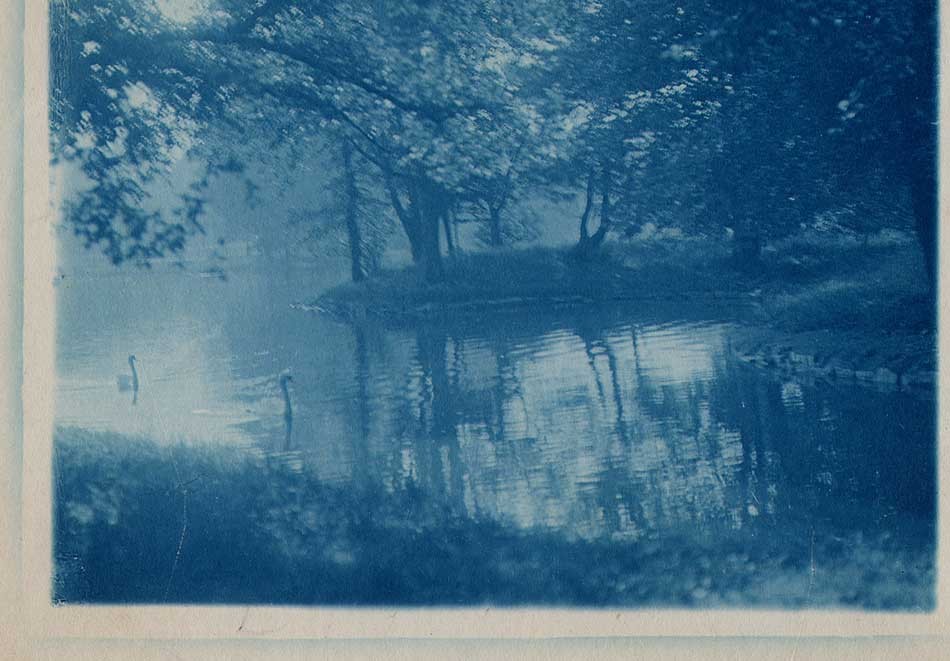 "Swans in Mist": by Unknown Brooklyn (photographer) : American: cyanotype: ca. 1905-10: 8.8 x 11.6 | 12.6 x 17.7 cm: Swans glide through mist on a lake in a park setting-possibly Brooklyn's Prospect Park as many known examples of this location were taken by this photographer. This photograph, with title supplied by this archive, is by an Unknown Brooklyn amateur photographer whose surviving work was discovered in a trunk in the American South. Background can be found by searching for this site's 2015 blog post: "No Junk in Trunk". From: PhotoSeed Archive
"Swans in Mist": by Unknown Brooklyn (photographer) : American: cyanotype: ca. 1905-10: 8.8 x 11.6 | 12.6 x 17.7 cm: Swans glide through mist on a lake in a park setting-possibly Brooklyn's Prospect Park as many known examples of this location were taken by this photographer. This photograph, with title supplied by this archive, is by an Unknown Brooklyn amateur photographer whose surviving work was discovered in a trunk in the American South. Background can be found by searching for this site's 2015 blog post: "No Junk in Trunk". From: PhotoSeed Archive
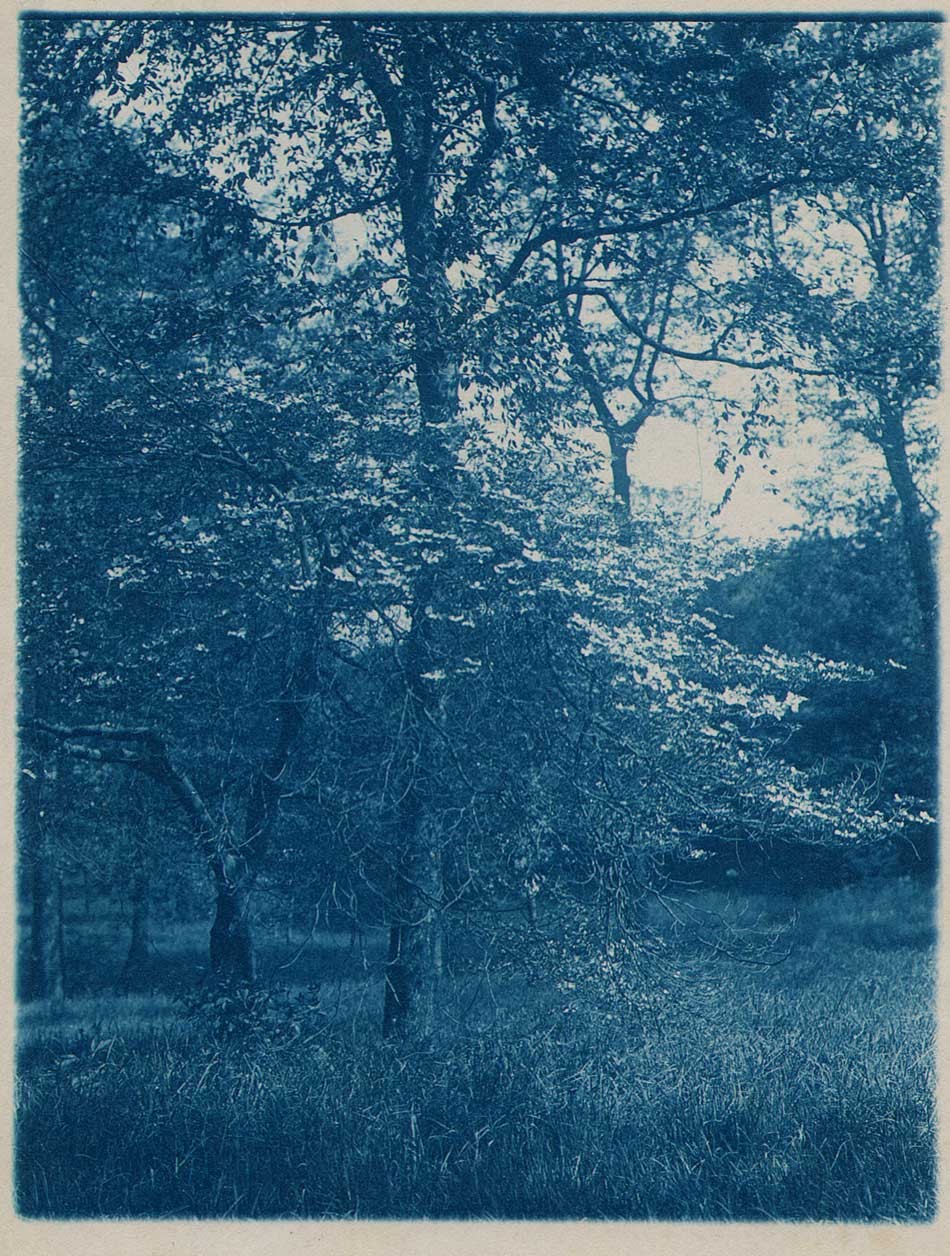 "Dogwood Tree in Bloom": by Unknown Brooklyn (photographer) : American: cyanotype: ca. 1905-10: 11.7 x 8.9 | 16.8 x 11.7 cm: A Dogwood tree blooms on the edge of a meadow in a park setting-possibly Brooklyn's Prospect Park as many known examples of this location were taken by this photographer. This photograph, with title supplied by this archive, is by an Unknown Brooklyn amateur photographer whose surviving work was discovered in a trunk in the American South. Background can be found by searching for this site's 2015 blog post: "No Junk in Trunk". From: private U.S. collection.
"Dogwood Tree in Bloom": by Unknown Brooklyn (photographer) : American: cyanotype: ca. 1905-10: 11.7 x 8.9 | 16.8 x 11.7 cm: A Dogwood tree blooms on the edge of a meadow in a park setting-possibly Brooklyn's Prospect Park as many known examples of this location were taken by this photographer. This photograph, with title supplied by this archive, is by an Unknown Brooklyn amateur photographer whose surviving work was discovered in a trunk in the American South. Background can be found by searching for this site's 2015 blog post: "No Junk in Trunk". From: private U.S. collection.
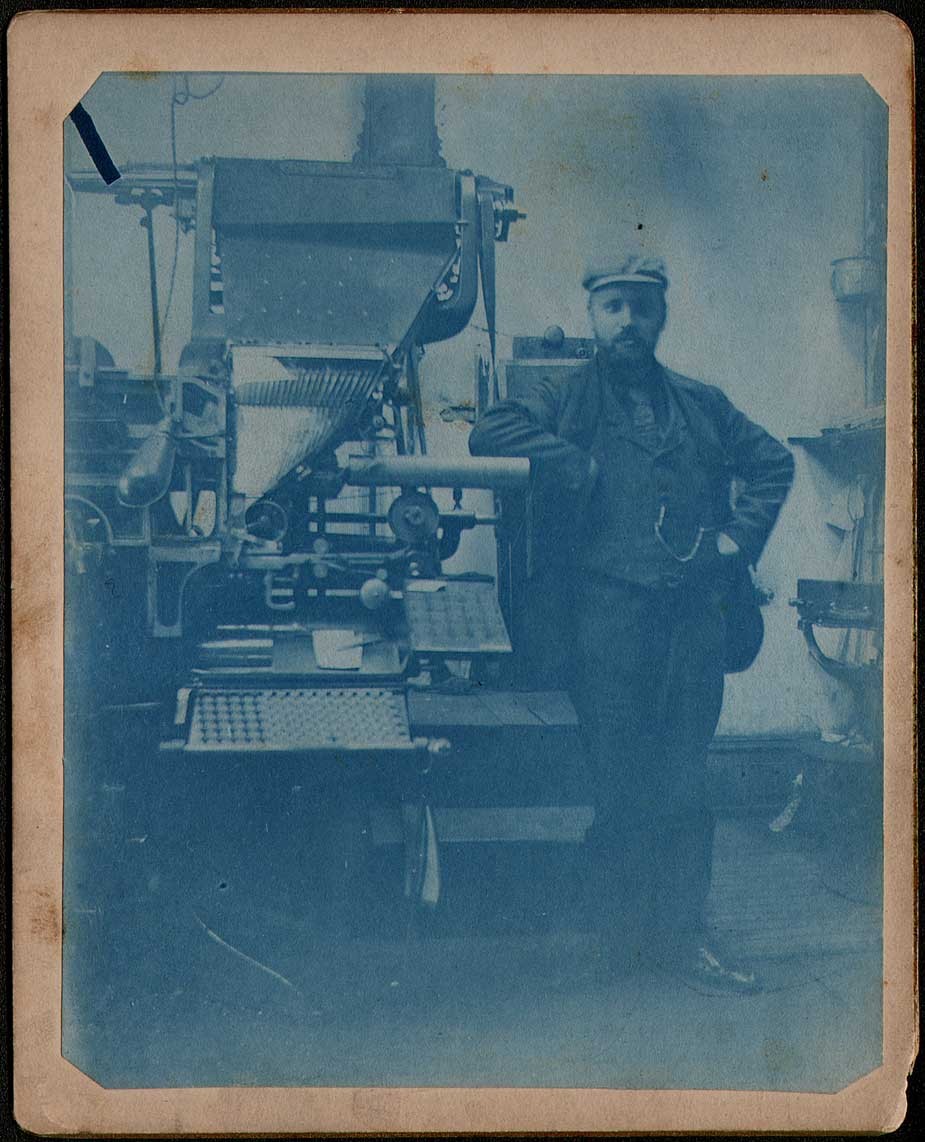 "Man Standing Next to Linotype Machine": unknown photographer: cyanotype: ca. 1895-1905: 11.9 x 9.6 | 13.2 x 10.6 cm: With the only annotation being the word Chicago written on the verso of this intriguing card-mounted cyanotype indicating origin, it's interesting to note that blueprinting, in addition to recording mechanical drawings, was also commonly used to make a record of large machinery like this early Linotype machine, an invention that revolutionized the speed of printing, particularly for newspapers and magazines. Invented by the German-born Ottmar Mergenthaler, (1854-1899) who has an uncanny surviving photographic likeness to the gentleman appearing in this cyanotype, the Linotype was first commercially used by the New York Tribune newspaper in 1886 and was in use into the 1970's, when it was largely replaced by offset lithography printing and computer typesetting. From: PhotoSeed Archive
"Man Standing Next to Linotype Machine": unknown photographer: cyanotype: ca. 1895-1905: 11.9 x 9.6 | 13.2 x 10.6 cm: With the only annotation being the word Chicago written on the verso of this intriguing card-mounted cyanotype indicating origin, it's interesting to note that blueprinting, in addition to recording mechanical drawings, was also commonly used to make a record of large machinery like this early Linotype machine, an invention that revolutionized the speed of printing, particularly for newspapers and magazines. Invented by the German-born Ottmar Mergenthaler, (1854-1899) who has an uncanny surviving photographic likeness to the gentleman appearing in this cyanotype, the Linotype was first commercially used by the New York Tribune newspaper in 1886 and was in use into the 1970's, when it was largely replaced by offset lithography printing and computer typesetting. From: PhotoSeed Archive
And now, examples of “blue prints” owing their roots to the beauty of the cyanotype reproduced using alternate photo-mechanical and photographic processes:
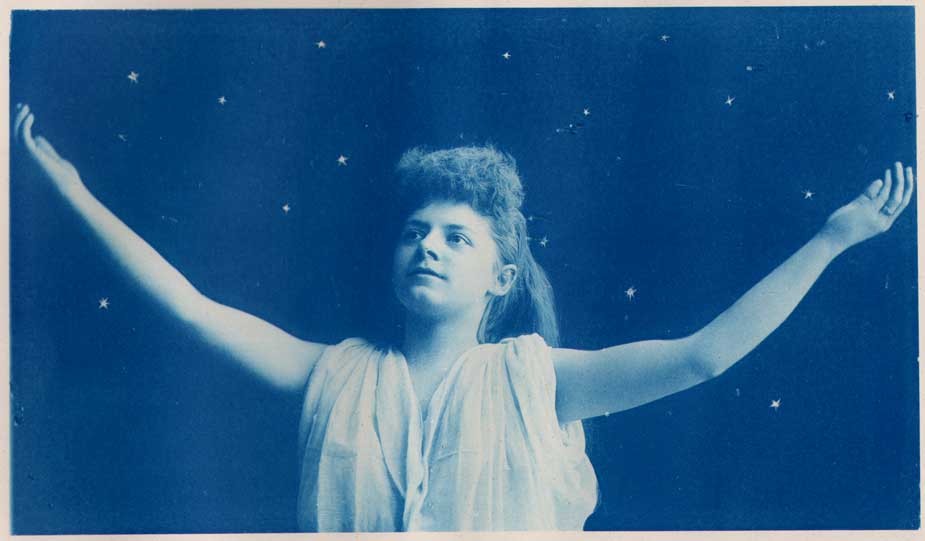 "Starlight": Charles Edward Doty: American 1862-1921: blue-toned collotype published in periodical "Sun & Shade: An Artistic Periodical": New York: January, 1890: whole #17: N.Y. Photo-Gravure Co.: 11.2 x 19.4 cm | 27.6 x 35.0 cm: The popularity of the cyanotype process gave reason for firms like the Photo Gravure Co. of New York to provide print runs for a larger audience of works like "Starlight" whose source imagery was originally a cyanotype. The model, said to be one Miss Emma McCormick, was photographed by Hamilton, Ohio portrait photographer Doty with outstretched arms against a backdrop of stars that were most likely added in the engraving process. Doty, according to the Smithsonian Institution in Washington, which owns hundreds of his original photographs, went on to become the "official photographer of the United States government in Havana," his duties included documenting the modernization of Cuba under American governorship. From: PhotoSeed Archive
"Starlight": Charles Edward Doty: American 1862-1921: blue-toned collotype published in periodical "Sun & Shade: An Artistic Periodical": New York: January, 1890: whole #17: N.Y. Photo-Gravure Co.: 11.2 x 19.4 cm | 27.6 x 35.0 cm: The popularity of the cyanotype process gave reason for firms like the Photo Gravure Co. of New York to provide print runs for a larger audience of works like "Starlight" whose source imagery was originally a cyanotype. The model, said to be one Miss Emma McCormick, was photographed by Hamilton, Ohio portrait photographer Doty with outstretched arms against a backdrop of stars that were most likely added in the engraving process. Doty, according to the Smithsonian Institution in Washington, which owns hundreds of his original photographs, went on to become the "official photographer of the United States government in Havana," his duties included documenting the modernization of Cuba under American governorship. From: PhotoSeed Archive
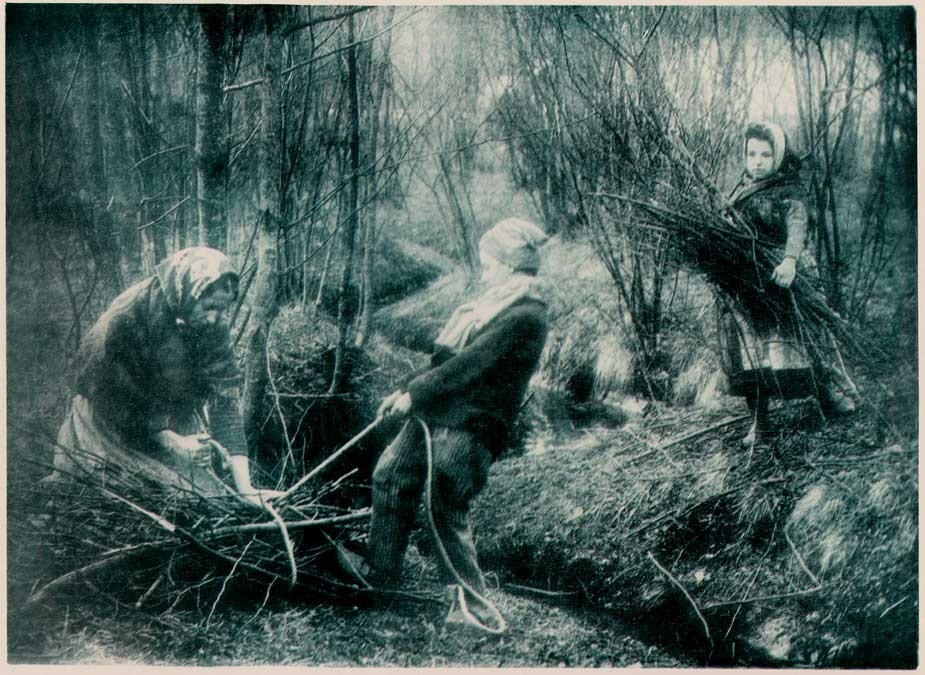 "Bundling and Gathering Faggots": Nestor Stekke: La Louvière, Belgium: blue-tinted collotype published in Sentiment d'Art en Photographie: Brussels,: Vol. II, No. 1, Planche 1: October, 1899: 16.1 x 22.3 | 26.5 x 37.2 cm: Featuring the work primarily of Belgian photographers but open to all, this folio-sized high-quality photographic plate publication, (The Feeling of Art in Photography) under the direction of Camille Smits with reproductions executed in collotype by Jules Liorel, featured the award winning work of pictorialists who entered monthly contests on a given theme judged by painter (M. Titz) and amateur photographer Van Gèle. Short-lived, Sentiment debuted in October, 1898 and ran until January, 1901 when it was renamed L'Art en Photographie . From: PhotoSeed Archive
"Bundling and Gathering Faggots": Nestor Stekke: La Louvière, Belgium: blue-tinted collotype published in Sentiment d'Art en Photographie: Brussels,: Vol. II, No. 1, Planche 1: October, 1899: 16.1 x 22.3 | 26.5 x 37.2 cm: Featuring the work primarily of Belgian photographers but open to all, this folio-sized high-quality photographic plate publication, (The Feeling of Art in Photography) under the direction of Camille Smits with reproductions executed in collotype by Jules Liorel, featured the award winning work of pictorialists who entered monthly contests on a given theme judged by painter (M. Titz) and amateur photographer Van Gèle. Short-lived, Sentiment debuted in October, 1898 and ran until January, 1901 when it was renamed L'Art en Photographie . From: PhotoSeed Archive
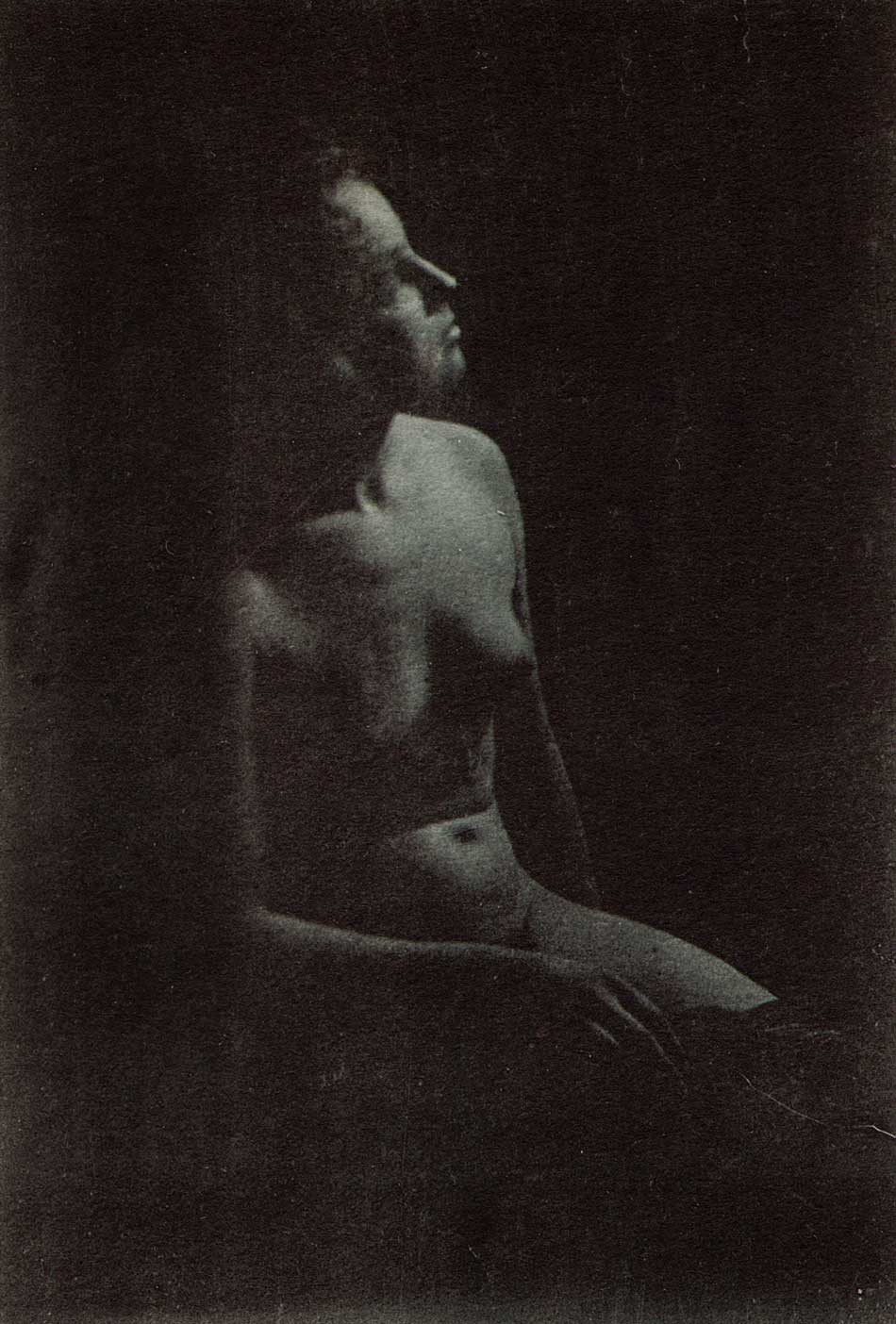 "Nude in Darkness": Léon Sneyers: Belgium:(1877-1949) collotype published in L'Art en Photographie: Brussels: No. 8: August, 1901: 12.4 x 8.3 | 37.0 x 25.5 cm: Translated to "Art in Photography", this folio-sized plate work was a continuation of "Le Sentiment d'Art en Photographie", with primarily Belgian pictorialists entering their work in contests on a given theme. Published by Jules Liorel, who also printed the plates in his Brussels atelier, a bibliography of this monthly work states it was "undoubtedly inspired by "Die Kunst in der Photographie", a German publication, and by "L'Art Photographique" published in Paris". This observation was made in reference to the fine-quality plates issued with it, as in this female nude study by Sneyers taken in the shadows and printed effectively by Liorel in collotype using an ink color combining deep black and violet to compliment the closed eyes of Sneyer's model. From: PhotoSeed Archive
"Nude in Darkness": Léon Sneyers: Belgium:(1877-1949) collotype published in L'Art en Photographie: Brussels: No. 8: August, 1901: 12.4 x 8.3 | 37.0 x 25.5 cm: Translated to "Art in Photography", this folio-sized plate work was a continuation of "Le Sentiment d'Art en Photographie", with primarily Belgian pictorialists entering their work in contests on a given theme. Published by Jules Liorel, who also printed the plates in his Brussels atelier, a bibliography of this monthly work states it was "undoubtedly inspired by "Die Kunst in der Photographie", a German publication, and by "L'Art Photographique" published in Paris". This observation was made in reference to the fine-quality plates issued with it, as in this female nude study by Sneyers taken in the shadows and printed effectively by Liorel in collotype using an ink color combining deep black and violet to compliment the closed eyes of Sneyer's model. From: PhotoSeed Archive
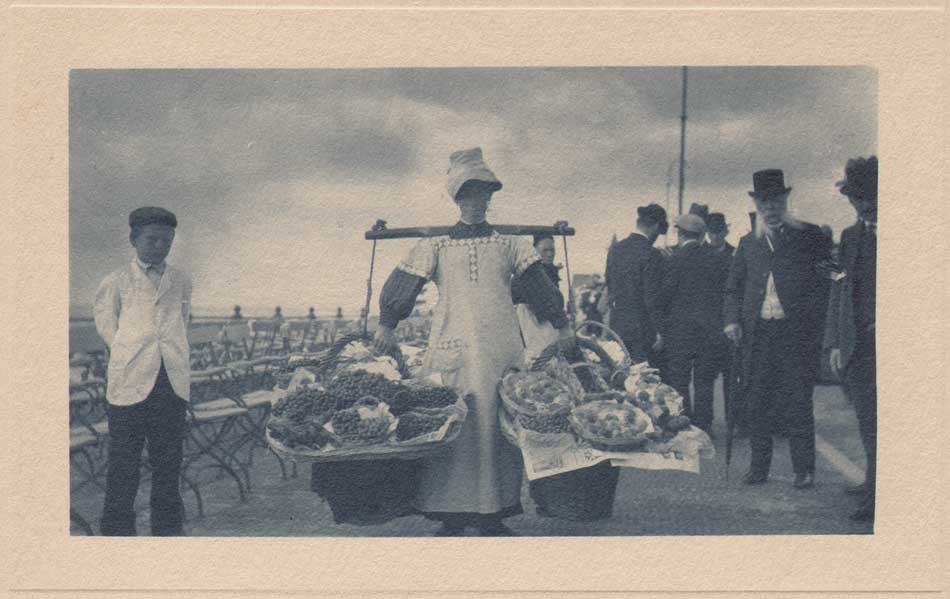 "Fruit Seller on Scheveningen Pier": Frank G.(eorge) Ensenberger, American: 1879-1966: blue-toned bromoil transfer print: 1910: 7.6 x 13.1 | 27.0 x 22.3 cm: A young woman balancing her load of grapes and other fruits for sale with a yoke stands on the Scheveningen Pier at the popular seaside resort located in The Hague in the Netherlands. In May, 1910, amateur photographer Frank Ensenberger of Bloomington, Ill sailed from Boston to Europe with his family, where he spent four months touring Great Britain, the Continent and other countries all while documenting the trip with his camera. On his return, approximately 900 selects were made by him and printed in various tints as bromoil transfer prints by an unknown professional photographer. They were gathered by country in leather-bound volumes, of which PhotoSeed owns nine. A prosperous business merchant and president of Ensenberger's home furnishings store in Bloomington, the Bloomington Pantagraph newspaper wrote of his photographic efforts during the trip in September, 1910, commenting: "The proofs show Mr. Ensenberger possesses the rare instinct of recognizing the setting for a good picture when he sees it, many of the views being truly artistic." Truthfully, his work was competent overall, with many of the plates being more "snapshot" in nature although documentary images scattered throughout the volumes show better than average compositional qualities. From: PhotoSeed Archive
"Fruit Seller on Scheveningen Pier": Frank G.(eorge) Ensenberger, American: 1879-1966: blue-toned bromoil transfer print: 1910: 7.6 x 13.1 | 27.0 x 22.3 cm: A young woman balancing her load of grapes and other fruits for sale with a yoke stands on the Scheveningen Pier at the popular seaside resort located in The Hague in the Netherlands. In May, 1910, amateur photographer Frank Ensenberger of Bloomington, Ill sailed from Boston to Europe with his family, where he spent four months touring Great Britain, the Continent and other countries all while documenting the trip with his camera. On his return, approximately 900 selects were made by him and printed in various tints as bromoil transfer prints by an unknown professional photographer. They were gathered by country in leather-bound volumes, of which PhotoSeed owns nine. A prosperous business merchant and president of Ensenberger's home furnishings store in Bloomington, the Bloomington Pantagraph newspaper wrote of his photographic efforts during the trip in September, 1910, commenting: "The proofs show Mr. Ensenberger possesses the rare instinct of recognizing the setting for a good picture when he sees it, many of the views being truly artistic." Truthfully, his work was competent overall, with many of the plates being more "snapshot" in nature although documentary images scattered throughout the volumes show better than average compositional qualities. From: PhotoSeed Archive
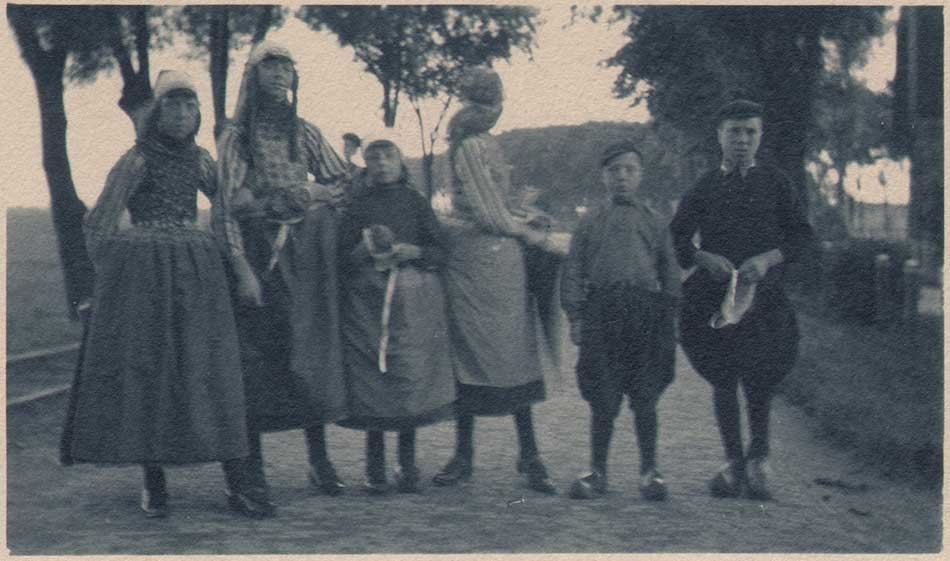 "Children Portrait Group in Holland": Frank G.(eorge) Ensenberger, American: 1879-1966: blue-toned bromoil transfer print: 1910: 7.6 x 13.1 | 27.0 x 22.3 cm: Standing in the middle of a roadway in Holland, a group of six children in their native dress stand for a portrait, the boys at right wearing traditional wooden shoes. In May, 1910, amateur photographer Frank Ensenberger of Bloomington, Ill sailed from Boston to Europe with his family, where he spent four months touring Great Britain, the Continent and other countries all while documenting the trip with his camera. On his return, approximately 900 selects were made by him and printed in various tints as bromoil transfer prints by an unknown professional photographer. They were gathered by country in leather-bound volumes, of which PhotoSeed owns nine. A prosperous business merchant and president of Ensenberger's home furnishings store in Bloomington, the Bloomington Pantagraph newspaper wrote of his photographic efforts during the trip in September, 1910, commenting: "The proofs show Mr. Ensenberger possesses the rare instinct of recognizing the setting for a good picture when he sees it, many of the views being truly artistic." Truthfully, his work was competent overall, with many of the plates being more "snapshot" in nature although documentary images scattered throughout the volumes show better than average compositional qualities. From: PhotoSeed Archive
"Children Portrait Group in Holland": Frank G.(eorge) Ensenberger, American: 1879-1966: blue-toned bromoil transfer print: 1910: 7.6 x 13.1 | 27.0 x 22.3 cm: Standing in the middle of a roadway in Holland, a group of six children in their native dress stand for a portrait, the boys at right wearing traditional wooden shoes. In May, 1910, amateur photographer Frank Ensenberger of Bloomington, Ill sailed from Boston to Europe with his family, where he spent four months touring Great Britain, the Continent and other countries all while documenting the trip with his camera. On his return, approximately 900 selects were made by him and printed in various tints as bromoil transfer prints by an unknown professional photographer. They were gathered by country in leather-bound volumes, of which PhotoSeed owns nine. A prosperous business merchant and president of Ensenberger's home furnishings store in Bloomington, the Bloomington Pantagraph newspaper wrote of his photographic efforts during the trip in September, 1910, commenting: "The proofs show Mr. Ensenberger possesses the rare instinct of recognizing the setting for a good picture when he sees it, many of the views being truly artistic." Truthfully, his work was competent overall, with many of the plates being more "snapshot" in nature although documentary images scattered throughout the volumes show better than average compositional qualities. From: PhotoSeed Archive
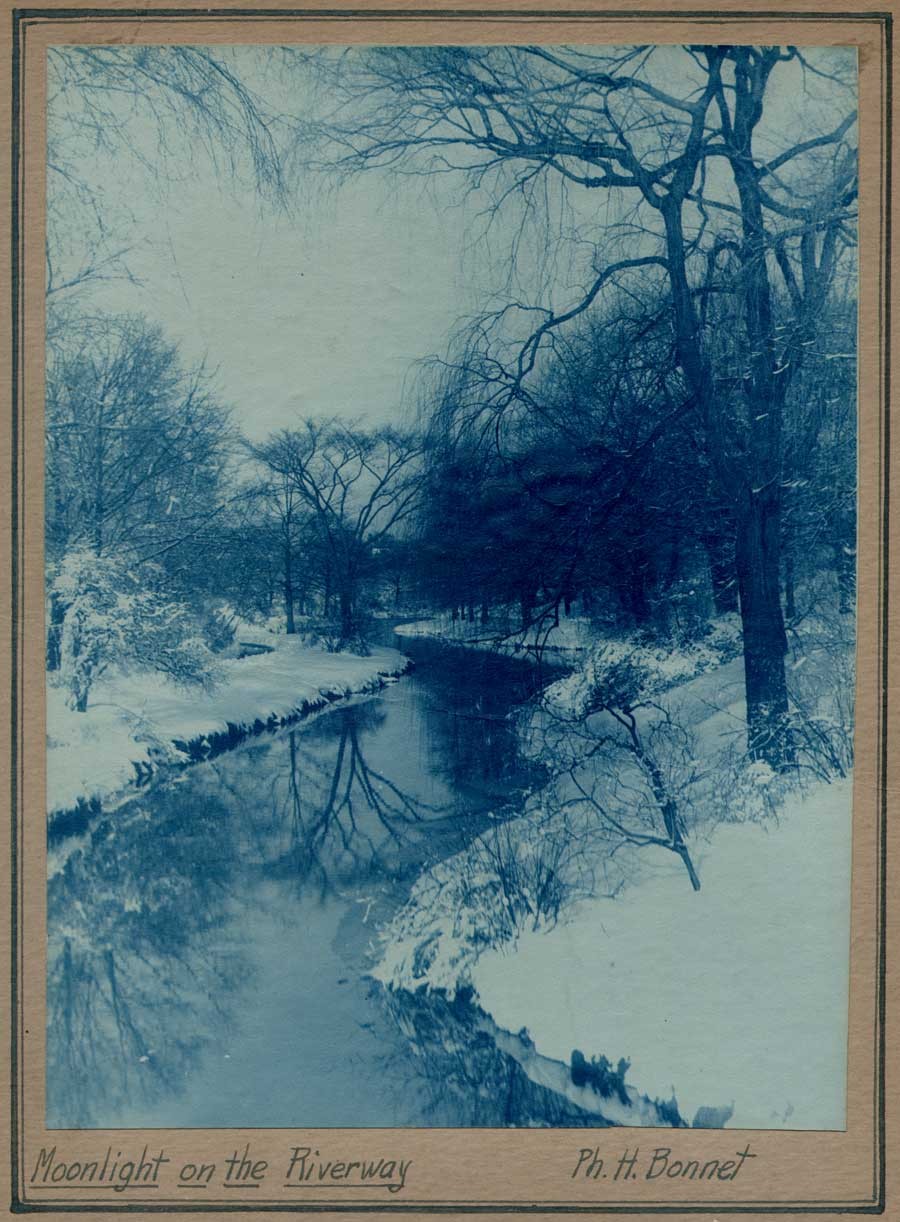 "Moonlight on the Riverway": Ph.(ilippe) H. Bonnet: 1904-1977: American: born France: blue-toned silver bromide print? ca. 1930-40: 24.8 x 18.6 | 38.6 x 26.3 cm: As a younger man, Philippe H. Bonnet was a staff photographer for The Tech, the Massachusetts Institute of Technology's undergraduate student newspaper. He is believed to have graduated from MIT in 1931 as listed in the Tech. In the early 1960's, a newspaper said he was a well known Boston architect. He also later made a name for himself as a railroad photographer-especially of trolley cars- and made his own real photo post cards and stamped them individually as a "Ferroviagraph". This scenic view of a river in Winter is from a series of landscape photographs believed to have been taken by him in the Middlesex Fells Reservation, a 2500 acre natural area located just north of Boston. A double-lined, hand-ruled frame in blue ink compliments the deep-blue effect achieved through the action of blue-toning. From: PhotoSeed Archive
"Moonlight on the Riverway": Ph.(ilippe) H. Bonnet: 1904-1977: American: born France: blue-toned silver bromide print? ca. 1930-40: 24.8 x 18.6 | 38.6 x 26.3 cm: As a younger man, Philippe H. Bonnet was a staff photographer for The Tech, the Massachusetts Institute of Technology's undergraduate student newspaper. He is believed to have graduated from MIT in 1931 as listed in the Tech. In the early 1960's, a newspaper said he was a well known Boston architect. He also later made a name for himself as a railroad photographer-especially of trolley cars- and made his own real photo post cards and stamped them individually as a "Ferroviagraph". This scenic view of a river in Winter is from a series of landscape photographs believed to have been taken by him in the Middlesex Fells Reservation, a 2500 acre natural area located just north of Boston. A double-lined, hand-ruled frame in blue ink compliments the deep-blue effect achieved through the action of blue-toning. From: PhotoSeed Archive
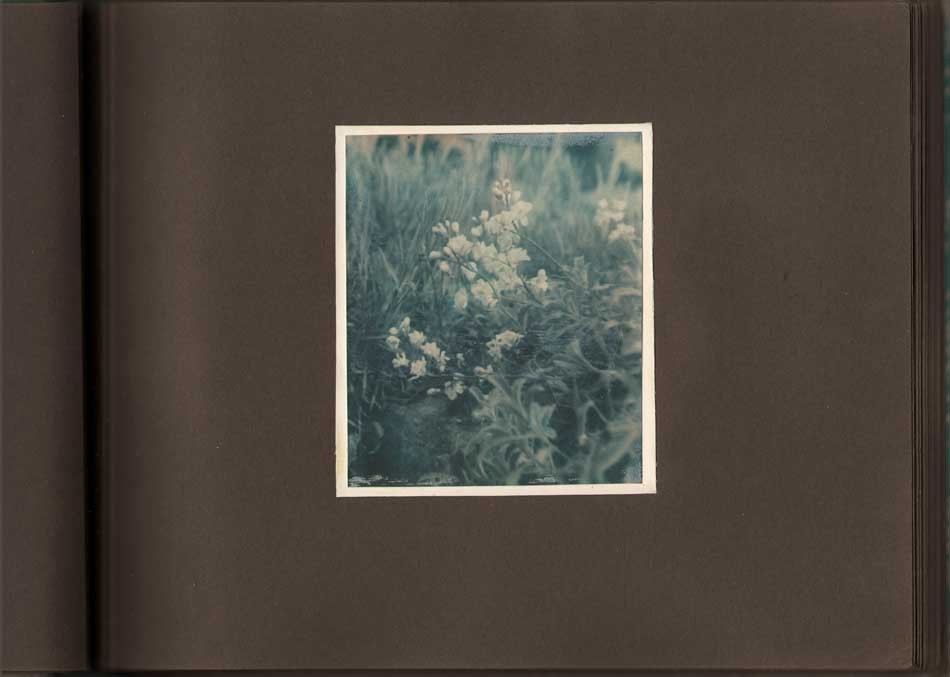 "Baby's Breath Growing in Wild": unknown photographer: blue-toned gelatin silver print: ca. 1930-40: 12.5 x 10.5 | 13.2 x 11.4 | 23.8 x 31.9 cm: This delicate study of what are believed to be Baby's Breath flowers (Gypsophilia, or Das Schleierkraut) is presented here in an album by an anonymous photographer (purchased from a seller in Greece) including a selection of pictorialist works featuring nicely mounted cityscape, mountain, and marine views, several of which show Frankfurt, Germany. From: PhotoSeed Archive
"Baby's Breath Growing in Wild": unknown photographer: blue-toned gelatin silver print: ca. 1930-40: 12.5 x 10.5 | 13.2 x 11.4 | 23.8 x 31.9 cm: This delicate study of what are believed to be Baby's Breath flowers (Gypsophilia, or Das Schleierkraut) is presented here in an album by an anonymous photographer (purchased from a seller in Greece) including a selection of pictorialist works featuring nicely mounted cityscape, mountain, and marine views, several of which show Frankfurt, Germany. From: PhotoSeed Archive
And in conclusion, a final cyanotype:
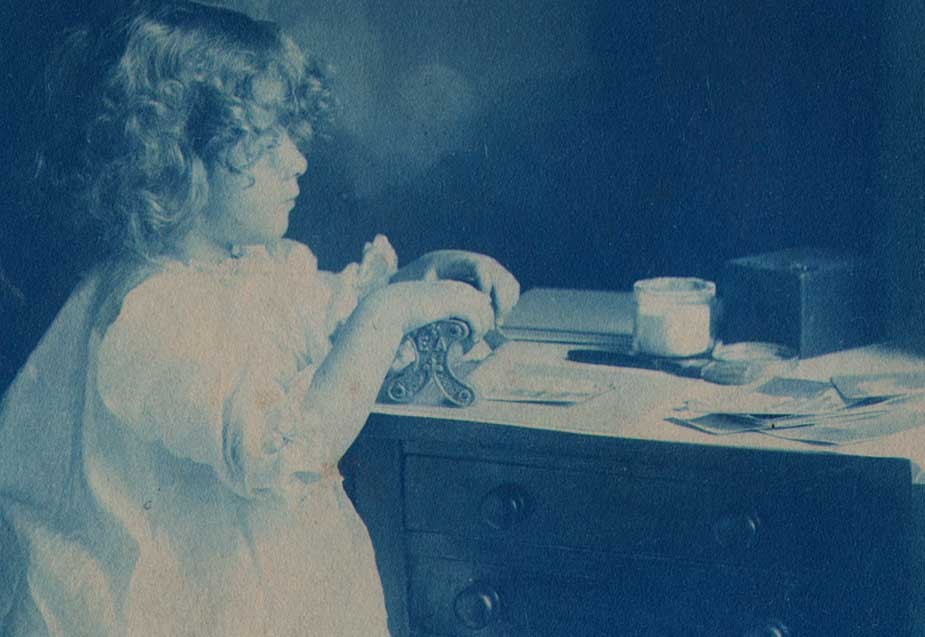 Detail: "Dorothy Tucker Mounting Photographs": Charles Rollins Tucker: American: cyanotype: ca. 1903: 11.3 x 8.6 | 15.0 x 12.6 cm: Seated on a stool, Dorothy Tucker, (1899-1986) the young daughter of amateur photographer Charles Rollins Tucker, is shown using an E. & H.T. Anthony brand Print Mounter to mount a photograph on a work table. Possibly taken for one of the yearly amateur Kodak advertising contests, the work space shows a Kodak Brownie camera at right rear, loose photographs, an album and a jar of what is most likely "Daisy" mounting paste with a brush next to it. Gripping the top of the mounter, young Dorothy prepares to slide the mounter with its two rollers over a print seen just to the right of it. The initials "EA" for Edward Anthony, are engraved on the side of roller. The E. & H.T. Anthony firm was considered the largest manufacturer and distributor of photographic supplies in the United States during the 19th century. From: PhotoSeed Archive
Detail: "Dorothy Tucker Mounting Photographs": Charles Rollins Tucker: American: cyanotype: ca. 1903: 11.3 x 8.6 | 15.0 x 12.6 cm: Seated on a stool, Dorothy Tucker, (1899-1986) the young daughter of amateur photographer Charles Rollins Tucker, is shown using an E. & H.T. Anthony brand Print Mounter to mount a photograph on a work table. Possibly taken for one of the yearly amateur Kodak advertising contests, the work space shows a Kodak Brownie camera at right rear, loose photographs, an album and a jar of what is most likely "Daisy" mounting paste with a brush next to it. Gripping the top of the mounter, young Dorothy prepares to slide the mounter with its two rollers over a print seen just to the right of it. The initials "EA" for Edward Anthony, are engraved on the side of roller. The E. & H.T. Anthony firm was considered the largest manufacturer and distributor of photographic supplies in the United States during the 19th century. From: PhotoSeed Archive
Silent Night
Posted December 2014 in Exhibitions, New Additions, Significant Photographs
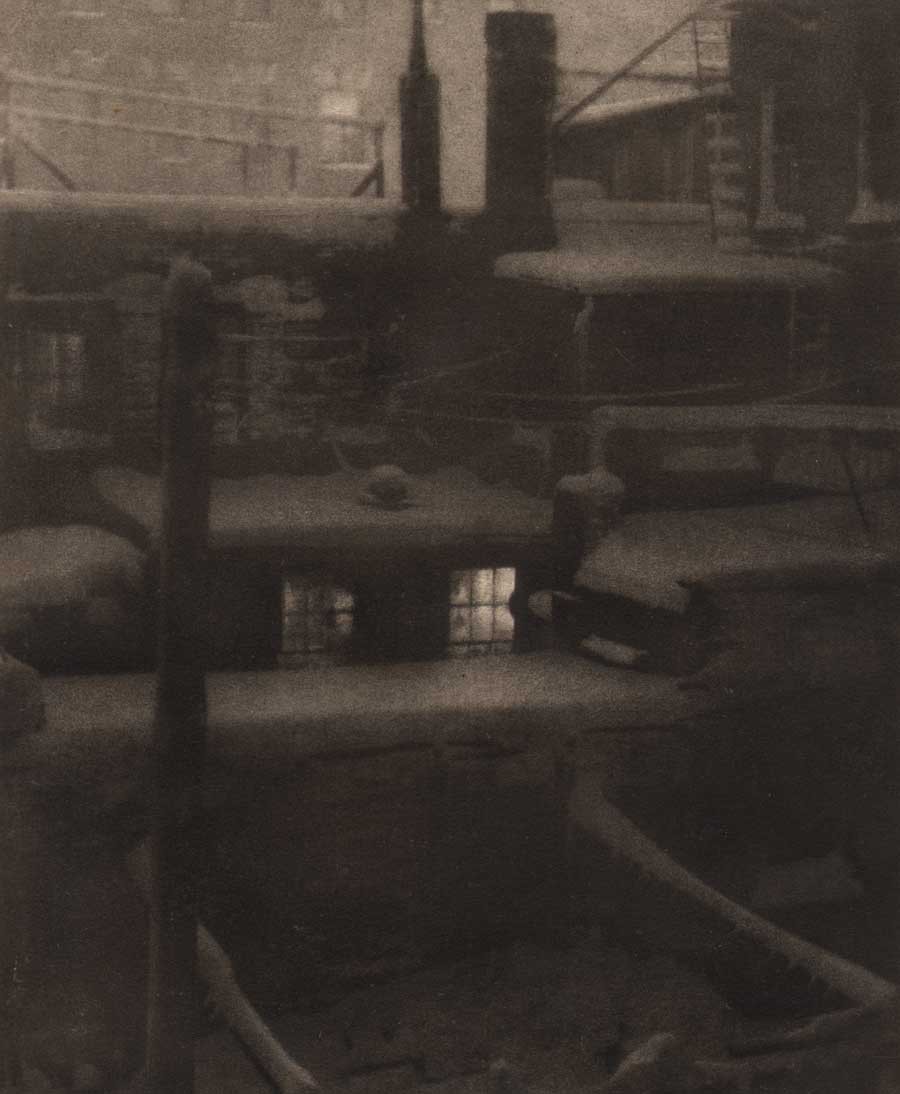 Detail: "Thru the Back Window": Charles A. Hellmuth: American: vintage 1924 Wellington bromoil print: 32.1 x 24.0 cm | 50.7 x 40.6 cm: from: PhotoSeed Archive
Detail: "Thru the Back Window": Charles A. Hellmuth: American: vintage 1924 Wellington bromoil print: 32.1 x 24.0 cm | 50.7 x 40.6 cm: from: PhotoSeed Archive
Rule Breaker; Dream Maker
Posted January 2014 in Exhibitions, History of Photography, Significant Photographers
Subversive and unwilling to play by the rules. This is why the body of work produced by British photographer Julia Margaret Cameron (1815–1879) should still matter to us today.
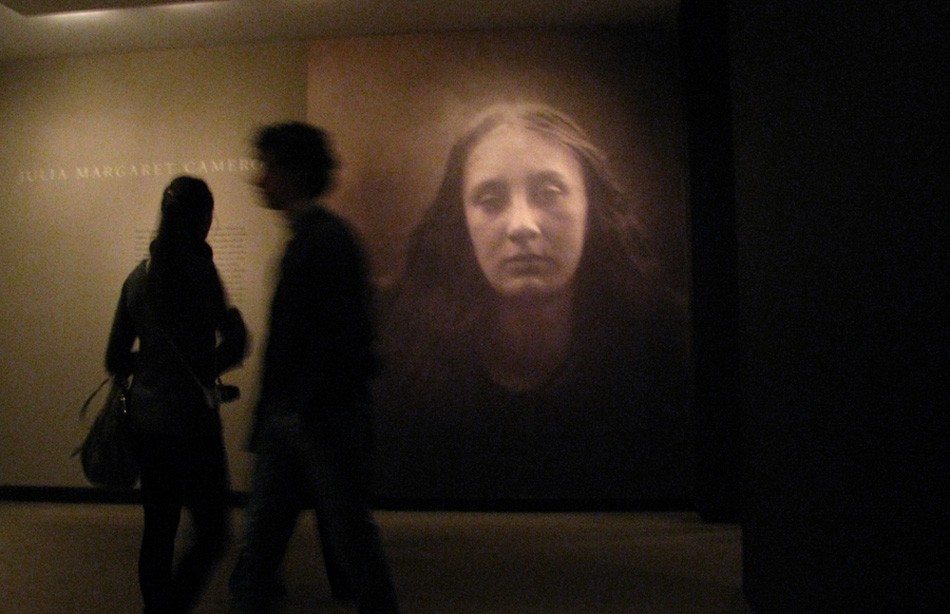 Silhouetted visitors to the Metropolitan Museum of Art's Gallery 852 in December, 2013 are seen in the entryway to the exhibit with a wall-mounted, mural-sized version of the Cameron photograph "Christabel" taken in 1866 in the background. The show was open from August 19, 2013 to January 5, 2014. PhotoSeed Archive photograph by David Spencer
Silhouetted visitors to the Metropolitan Museum of Art's Gallery 852 in December, 2013 are seen in the entryway to the exhibit with a wall-mounted, mural-sized version of the Cameron photograph "Christabel" taken in 1866 in the background. The show was open from August 19, 2013 to January 5, 2014. PhotoSeed Archive photograph by David Spencer
How can one not admire the intent and courage it must have taken her to focus a camera lens in the era of wet plate photography (1860s-1870s) and then, just as often as not, deliberately have the mischievous bent to throw that lens slightly out of focus in order to create photographs often resembling the feelings found in dreams? Photographs that justifiably draw admiration and discussion even today of the lives of Victorian celebrities and house servants who were convinced to sit or be dragged in front of that camera.
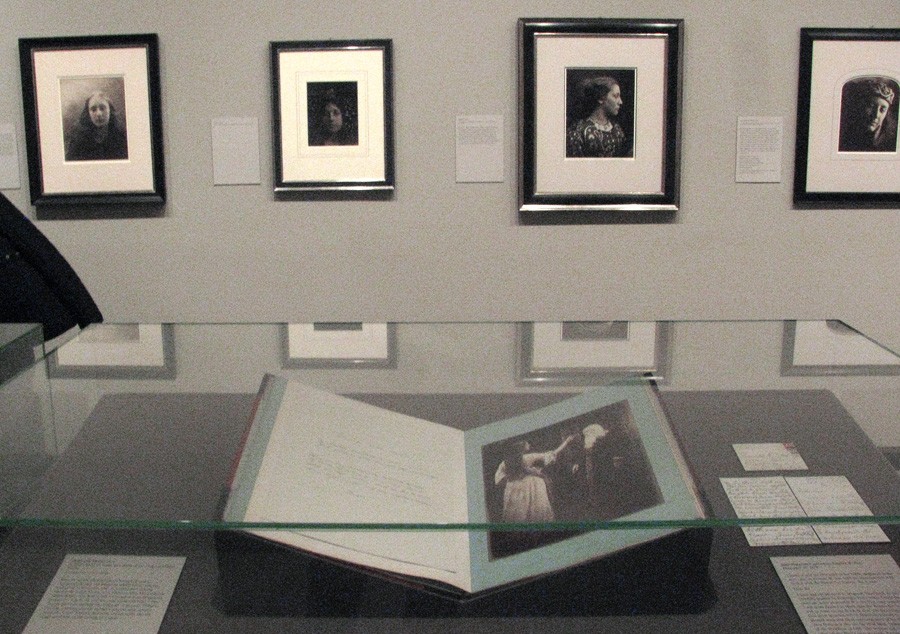 Organized by Malcolm Daniel, Senior Curator in the Department of Photographs at the Met, the tightly edited show featured 35 framed vintage works by Cameron as well as several photographs by her contemporaries. The glass display case in this installation view displayed several folio volumes of the work "Illustrations to Tennyson's Idylls of the King, and Other Poems" published by Henry S. King in London in 1875. The work seen here at front is "Vivien and Merlin" (1874)- one 24 original photographs that appeared in the double volume folio. PhotoSeed Archive photograph by David Spencer
Organized by Malcolm Daniel, Senior Curator in the Department of Photographs at the Met, the tightly edited show featured 35 framed vintage works by Cameron as well as several photographs by her contemporaries. The glass display case in this installation view displayed several folio volumes of the work "Illustrations to Tennyson's Idylls of the King, and Other Poems" published by Henry S. King in London in 1875. The work seen here at front is "Vivien and Merlin" (1874)- one 24 original photographs that appeared in the double volume folio. PhotoSeed Archive photograph by David Spencer
For those inclined to learn the mysterious ingredient-and staying power so to speak-of Cameron’s photography-the answer might be a single word: “beauty”. This might indeed be the key, a Citizen Kane, Rosebud moment if you will, the one final word she reportedly uttered on her deathbed.
Beauty, and a renewed appreciation is what I took away from a visit late last year to a show at the Metropolitan Museum of Art simply titled “Julia Margaret Cameron”.
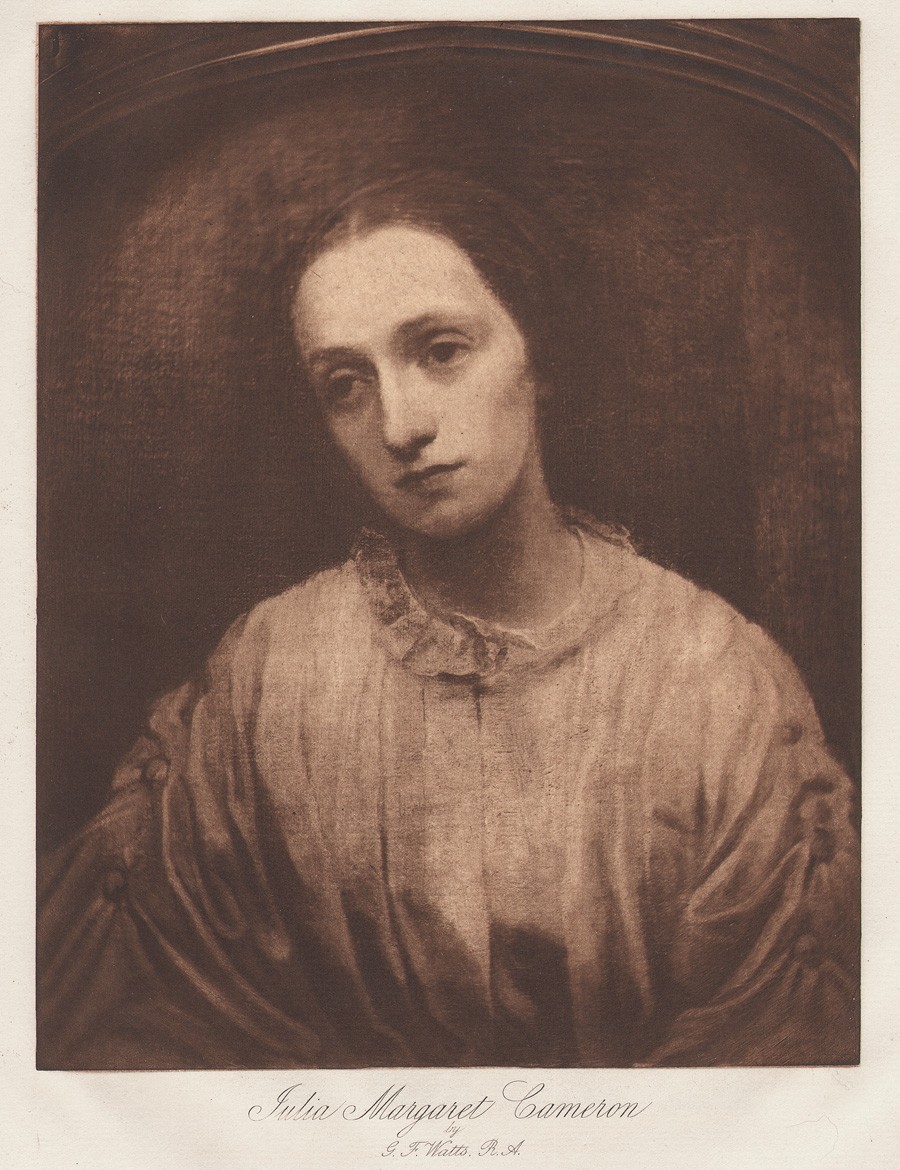 A painting by English artist George Frederick Watts of Julia Margaret Cameron completed in 1852 is reproduced here as a large format plate photogravure included in the 1893 folio volume "Alfred, Lord Tennyson and his Friends" published in London by T. Fisher Unwin in a limited edition. image: 24.5 x 19.3 cm : laid paper cream-colored leaf: 44.3 x 36.0 cm. from: PhotoSeed Archive
A painting by English artist George Frederick Watts of Julia Margaret Cameron completed in 1852 is reproduced here as a large format plate photogravure included in the 1893 folio volume "Alfred, Lord Tennyson and his Friends" published in London by T. Fisher Unwin in a limited edition. image: 24.5 x 19.3 cm : laid paper cream-colored leaf: 44.3 x 36.0 cm. from: PhotoSeed Archive
Surprisingly, it was first devoted solely to her work at the museum, a tightly edited overview comprised of 38 works, including several by her contemporaries: David Wilkie Wynfield, William Frederick Lake Price, and Oscar Gustav Rejlander.
The wall copy set the stage for those not already familiar with Cameron, describing her rightly as:
”One of the greatest portraitists in the history of photography—indeed in any medium“…
A further explanatory statement in her own words followed:
”From the first moment I handled my lens with a tender ardour,” she wrote, “and it has become to me as a living thing, with voice and memory and creative vigour.”
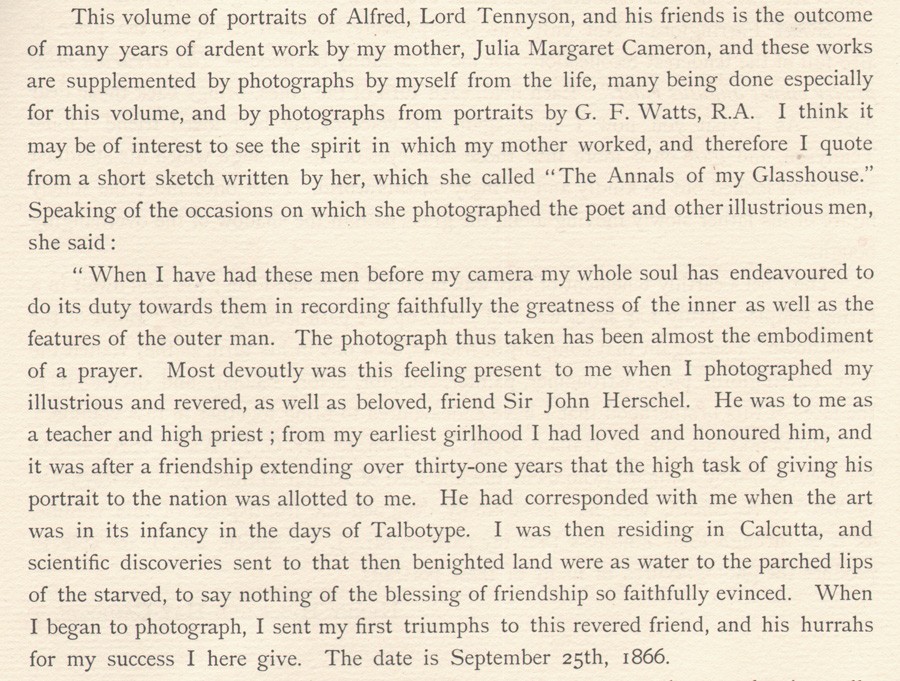 A detail from the first page of the letterpress Introduction to "Alfred, Lord Tennyson and his Friends"(1893) by Cameron's son Henry Herschel Hay Cameron. A quote from her "Annals of my Glasshouse" states she felt the photographs taken of illustrious men were akin to being "almost the embodiment of a prayer". from: PhotoSeed Archive
A detail from the first page of the letterpress Introduction to "Alfred, Lord Tennyson and his Friends"(1893) by Cameron's son Henry Herschel Hay Cameron. A quote from her "Annals of my Glasshouse" states she felt the photographs taken of illustrious men were akin to being "almost the embodiment of a prayer". from: PhotoSeed Archive
Words that no doubt have influenced scores of photographers, painters and others working in various artistic disciplines during the many decades since her passing. An important early tribute came in the lifetime of Cameron’s youngest son Henry Herschel Hay Cameron. (1852-1911) Inspired no doubt by his mother’s art, he was a working photographer who maintained a London studio, and provided the Introduction as well as a series of complimentary portraits paired with those by his mother for the folio volume Alfred, Lord Tennyson and his Friends. This series of 25 large-plate photogravures along with letterpress was published in a limited edition in 1893.
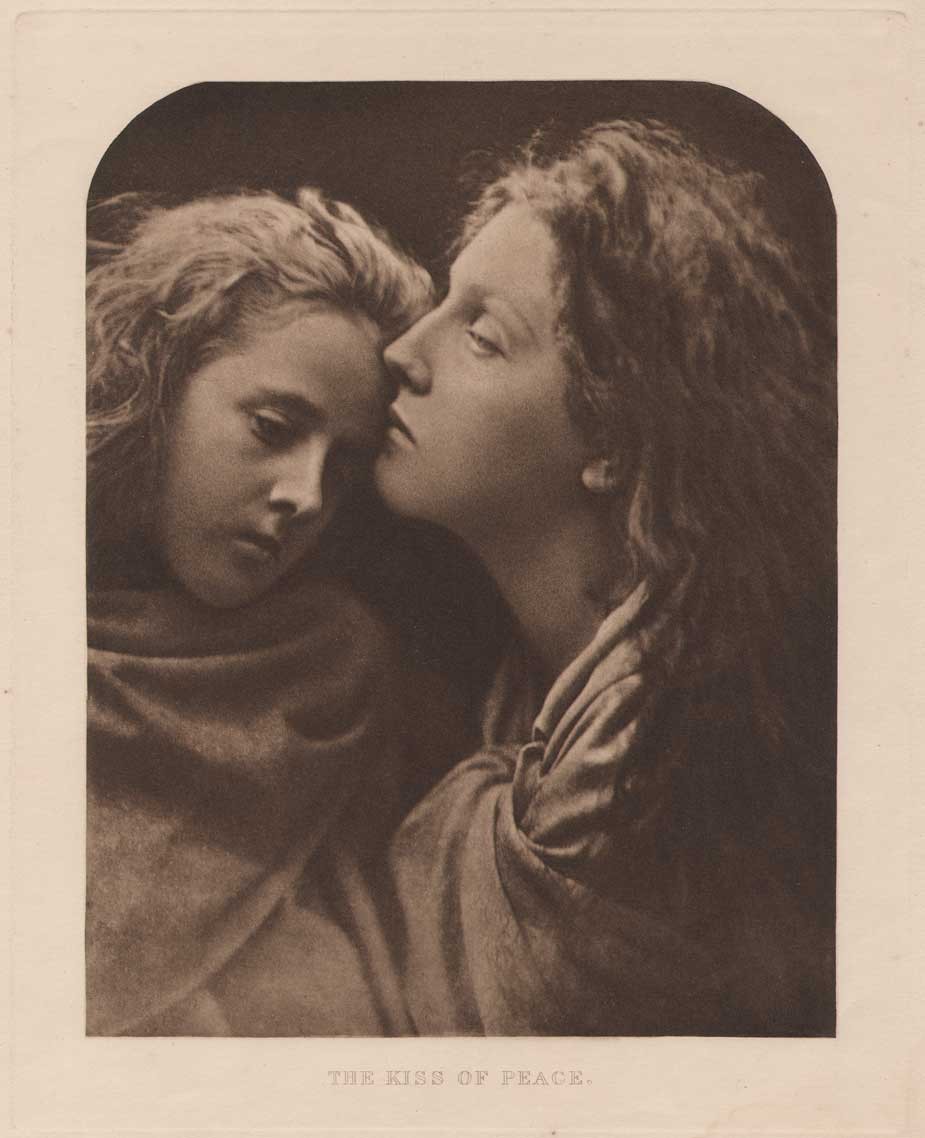 Inspired by the Biblical story of the Visitation, "The Kiss of Peace" is shown here as a large plate photogravure included with the 5th issue of the English publication "Sun Artists" published in 1890. Taken in 1869 by Cameron, it is believed to show Florence Anson at left, the daughter of Lord Litchfield, and Mary Hillier, Cameron's personal maid. See: JMC: The Complete Photographs, cat. #1129. image: 21.8 x 17.1 cm: sheet: 38.0 x 28.4 cm: Vintage gravure from PhotoSeed Archive.
Inspired by the Biblical story of the Visitation, "The Kiss of Peace" is shown here as a large plate photogravure included with the 5th issue of the English publication "Sun Artists" published in 1890. Taken in 1869 by Cameron, it is believed to show Florence Anson at left, the daughter of Lord Litchfield, and Mary Hillier, Cameron's personal maid. See: JMC: The Complete Photographs, cat. #1129. image: 21.8 x 17.1 cm: sheet: 38.0 x 28.4 cm: Vintage gravure from PhotoSeed Archive.
Other notable remembrances of Cameron’s work appeared earlier and much later. In 1890, the English publication Sun Artists featured four of her photographs: Sir John Herschel, Alfred Lord Tennyson and the allegorical works The Day Dream and The Kiss of Peace. All large-plate gravures for the 5th Number.
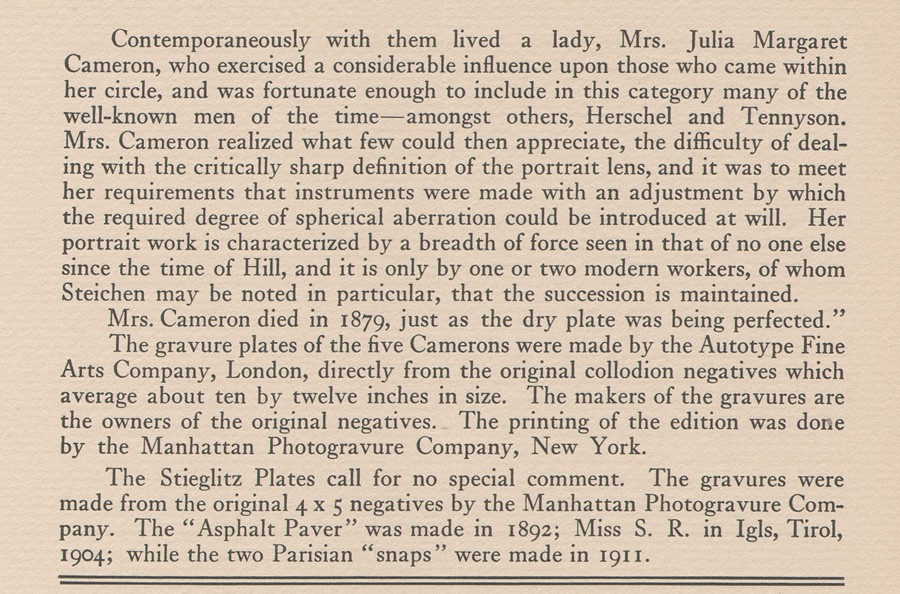 Editor Alfred Stieglitz gave background to Cameron's work he published in Camera Work XLI, (1913) with a nod to her willingness to break rules when it came to portraiture: "Mrs. Cameron realized what few could then appreciate, the difficulty of dealing with the critically sharp definition of the portrait lens, and it was to meet her requirements that instruments were made with an adjustment by which the required degree of spherical aberration could be introduced at will." detail: vintage letterpress page from PhotoSeed Archive.
Editor Alfred Stieglitz gave background to Cameron's work he published in Camera Work XLI, (1913) with a nod to her willingness to break rules when it came to portraiture: "Mrs. Cameron realized what few could then appreciate, the difficulty of dealing with the critically sharp definition of the portrait lens, and it was to meet her requirements that instruments were made with an adjustment by which the required degree of spherical aberration could be introduced at will." detail: vintage letterpress page from PhotoSeed Archive.
For Camera Work 41 published in 1913, editor Alfred Stieglitz presented five plates of Cameron’s work published as tissue gravures: two of Scottish philosopher Thomas Carlyle, portraits of English polymath John Herschel and Hungarian violinist Joseph Joachim and an allegorical study of English Shakespearean actress Ellen Terry taken done in 1864 when she was 16 originally titled “Sadness”.
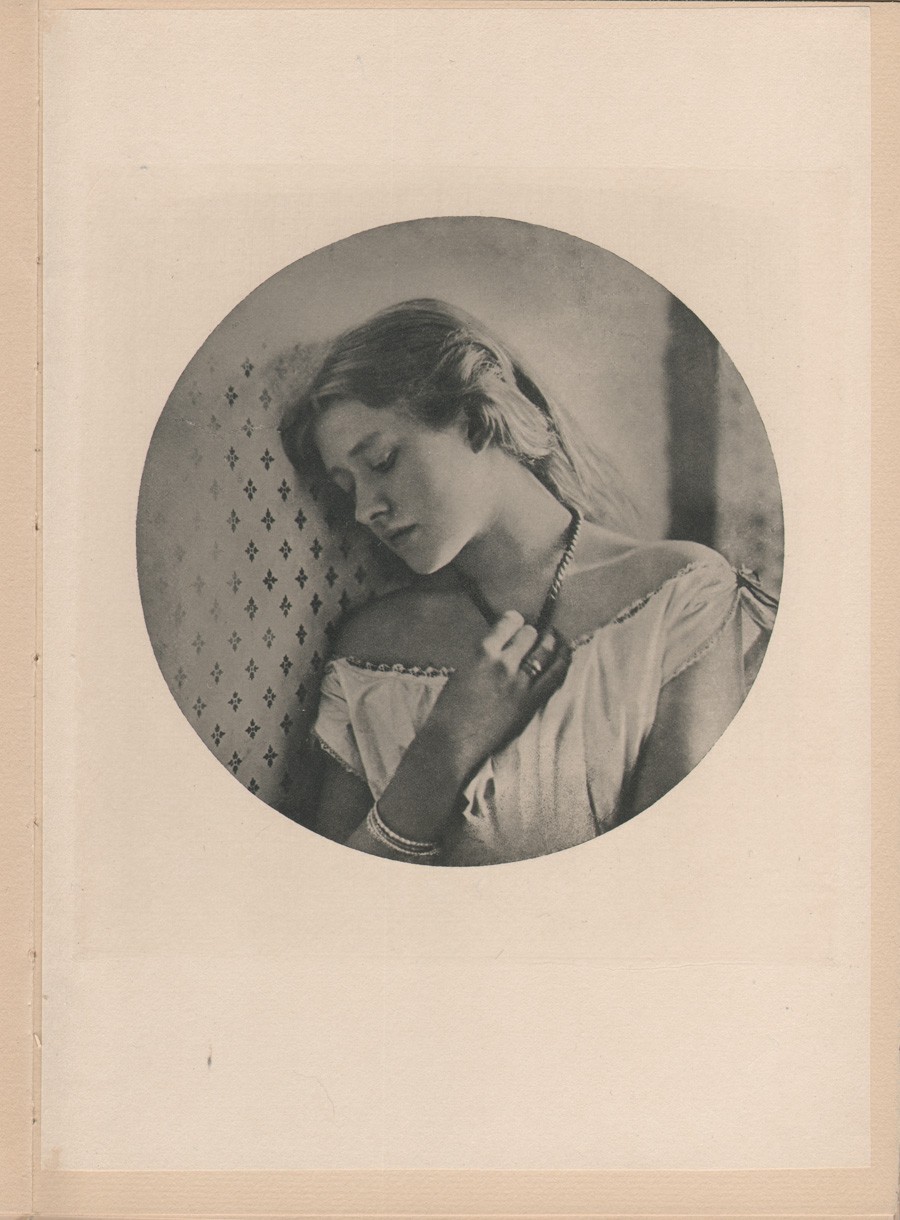 English Shakespearean actress Ellen Terry was included as a hand-pulled, Japanese tissue photogravure in Camera Work XLI,(1913) photographed by Cameron in 1864 when she was 16 years of age. The allegorical photograph originally carried the title of "Sadness". entire vintage tipped plate shown on original CW mount: circular image: 15.7 cm | sheet: 28.0 x 20.1 cm | mount: 29.4 x 21.0 cm. from PhotoSeed Archive
English Shakespearean actress Ellen Terry was included as a hand-pulled, Japanese tissue photogravure in Camera Work XLI,(1913) photographed by Cameron in 1864 when she was 16 years of age. The allegorical photograph originally carried the title of "Sadness". entire vintage tipped plate shown on original CW mount: circular image: 15.7 cm | sheet: 28.0 x 20.1 cm | mount: 29.4 x 21.0 cm. from PhotoSeed Archive
Later in the British Number of the short-lived publication Platinum Print published in Feb. 1915, American photographer Clarence White’s essay titled Old Masters in Photography lauded Cameron as an early influence, singling out her photograph he most likely saw in an 1891 issue of Sun and Shade titled the Dalmatian Maid.
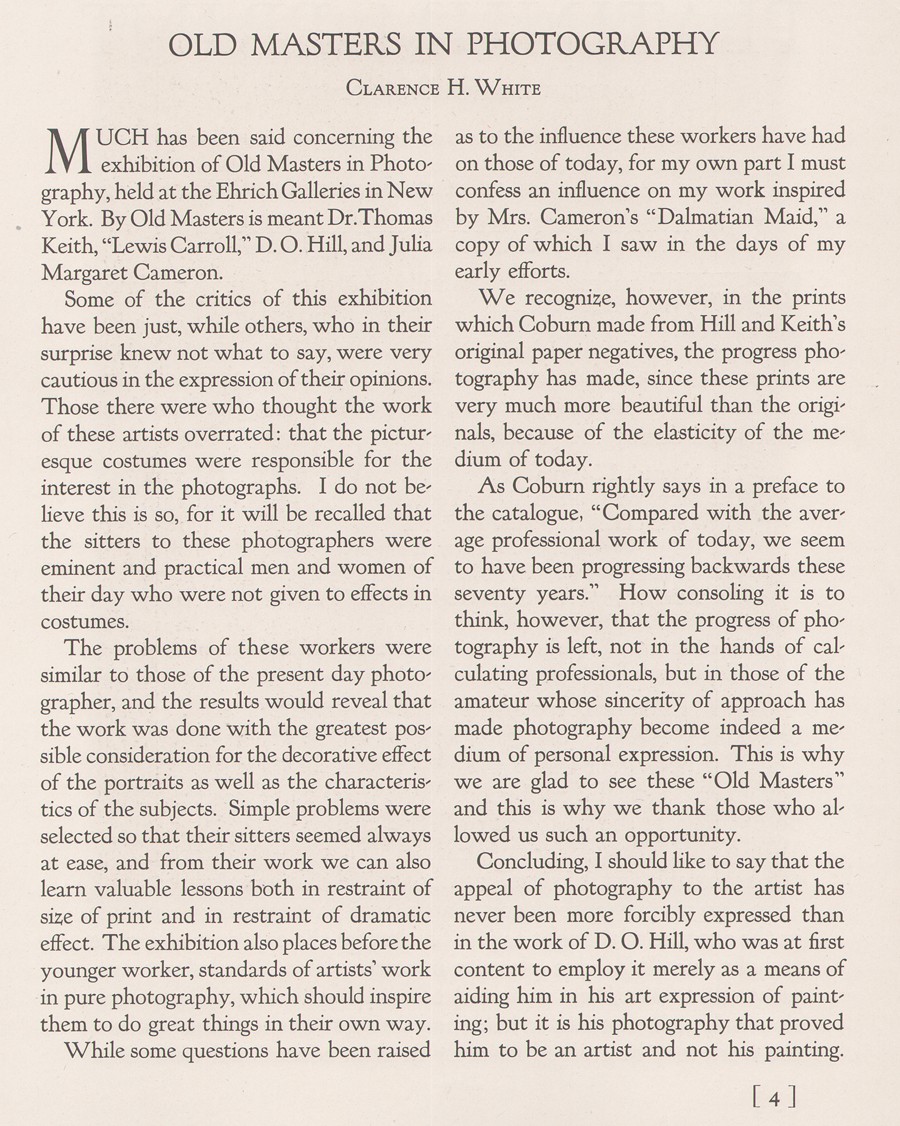 Julia Margaret Cameron was one of "The Old Masters of Photography" exhibit arranged by Alvin Langdon Coburn and presented at the Ehrich Galleries of New York City in December, 1914. Author Clarence White weighs in on the exhibit, discussing the influence of Cameron on his own work. Single letterpress page from "Platinum Print": Feb. 1915: PhotoSeed Archive
Julia Margaret Cameron was one of "The Old Masters of Photography" exhibit arranged by Alvin Langdon Coburn and presented at the Ehrich Galleries of New York City in December, 1914. Author Clarence White weighs in on the exhibit, discussing the influence of Cameron on his own work. Single letterpress page from "Platinum Print": Feb. 1915: PhotoSeed Archive
This portrait of Christina Spartali, a neighbor of Cameron on the Isle of Wight who was most certainly not a maid, as her family had made their fortune from the cotton trade and her father was Consul-General for Greece, was taken in 1868. White observed:
”While some questions have been raised as to the influence these workers have had on those of today, for my own part I must confess an influence on my work inspired by Mrs. Cameron’s “Dalmatian Maid,” a copy of which I saw in the days of my early efforts.” (p.4)
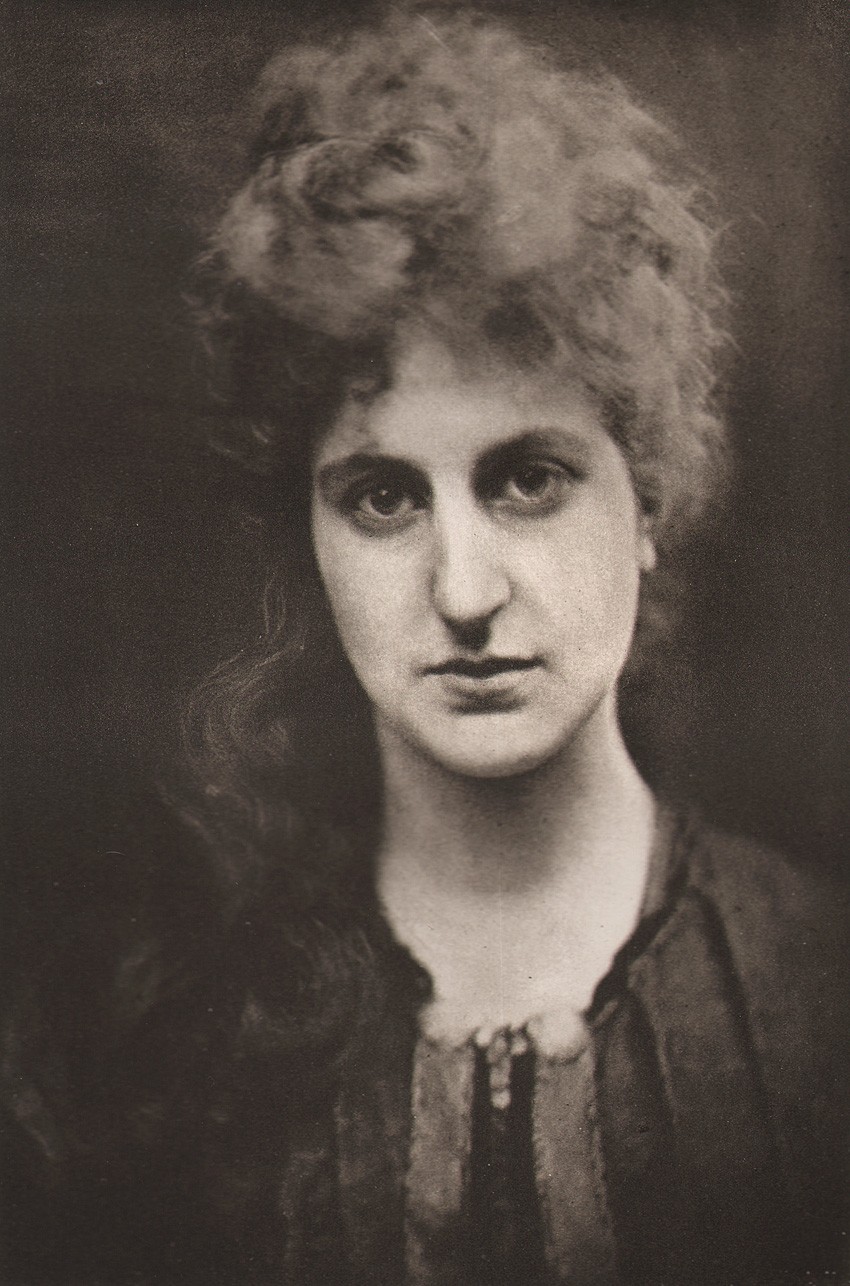 "A Dalmatian Maid", taken in 1868, is a portrait of Christina Spartali, a neighbor to Cameron on the Isle of Wight. from: Sun & Shade: July, 1891: plate IV (whole issue #35) image: 19.3 x 12.8 cm | plate: 34.0 x 26.2 cm N.Y. Photogravure Co.: PhotoSeed Archive
"A Dalmatian Maid", taken in 1868, is a portrait of Christina Spartali, a neighbor to Cameron on the Isle of Wight. from: Sun & Shade: July, 1891: plate IV (whole issue #35) image: 19.3 x 12.8 cm | plate: 34.0 x 26.2 cm N.Y. Photogravure Co.: PhotoSeed Archive
Although ended, photographs from the Cameron show at the Met can still be viewed in digital form, along with an ambitious project devoted to her and other notable photographers now ongoing on behalf of the rich photographic collection held by the Royal Photographic Society at the National Media Museum in Bradford, England.
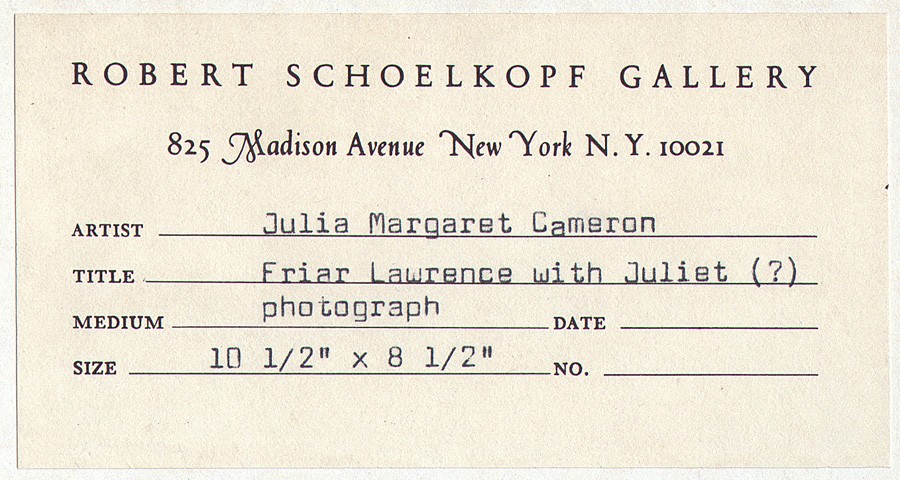 Robert Schoelkopf Gallery paper adhesive label from ca. 1965-1972 affixed to verso of mount from photograph "Friar Laurence and Juliet" : 5.8 x 11.1 cm. Formerly located at 825 Madison Ave. in New York City, the Schoelkopf gallery was established in 1962 and closed in 1991. It was one of the very first in the United States to present photography as a fine art and by the Spring of 1974, had "opened a gallery dedicated to photography on the second floor" of this address. from: PhotoSeed Archive
Robert Schoelkopf Gallery paper adhesive label from ca. 1965-1972 affixed to verso of mount from photograph "Friar Laurence and Juliet" : 5.8 x 11.1 cm. Formerly located at 825 Madison Ave. in New York City, the Schoelkopf gallery was established in 1962 and closed in 1991. It was one of the very first in the United States to present photography as a fine art and by the Spring of 1974, had "opened a gallery dedicated to photography on the second floor" of this address. from: PhotoSeed Archive
Other treasures await additional scholarship. For our part, PhotoSeed presents with this post a seldom-seen work by Cameron formerly owned by Peter Hukill, (1927-2003) an early collector of fine art photography who built a collection thanks to the early efforts of galleries including the former Robert Schoelkopf Gallery in New York City, the records of which now reside in the Smithsonian Archives of American Art.
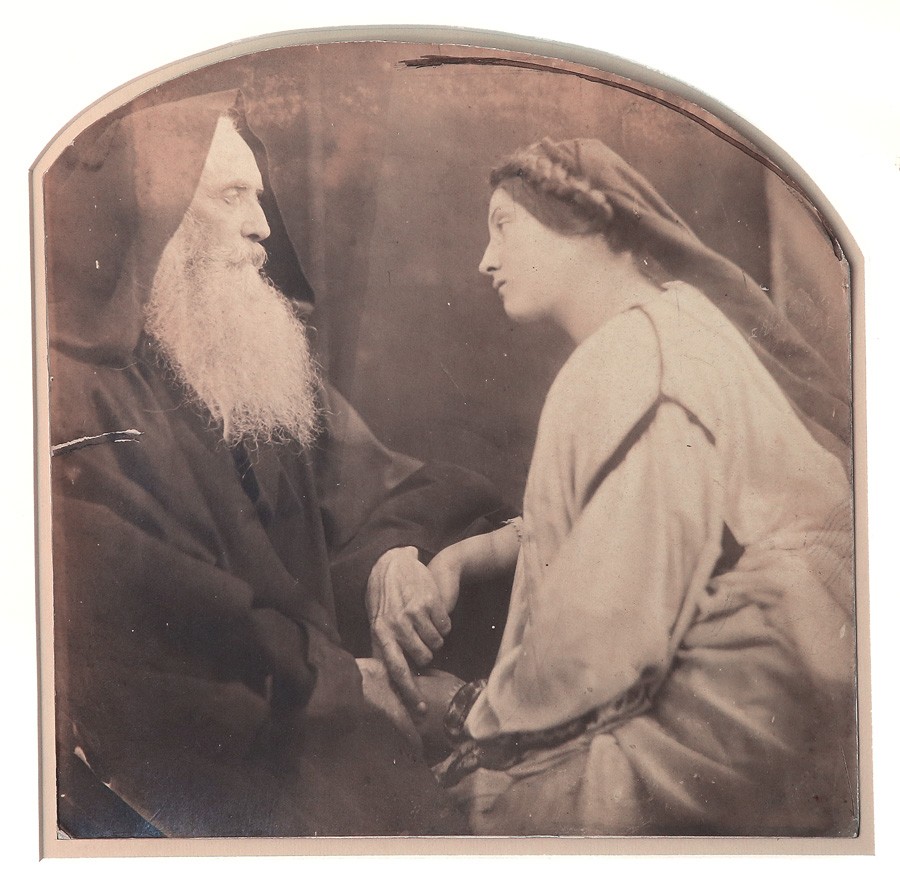 "Friar Laurence and Juliet", by Julia Margaret Cameron: copyrighted Nov. 11, 1865. Three separate versions of this title exist as recorded in Julia Margaret Cameron: The Complete Photographs. (Cox & Ford) This version with model Mary Hillier- Cameron's personal maid- wearing lighter-colored topcoat posing with Henry Taylor. (C&F #1089) Vintage albumen silver print mounted separately on board presented within window of modern mount. Condition of print exhibits uneven arched top with free-hand drawn ink line near top margin and surface marks to print emulsion. image: 28.2 x 28.6 cm | mount: 60.7 x 50.7 cm. photograph placed at auction by Robert Schoelkopf Gallery in 1972 (Parke-Bernet) and acquired by Peter Hukill. from: PhotoSeed Archive
"Friar Laurence and Juliet", by Julia Margaret Cameron: copyrighted Nov. 11, 1865. Three separate versions of this title exist as recorded in Julia Margaret Cameron: The Complete Photographs. (Cox & Ford) This version with model Mary Hillier- Cameron's personal maid- wearing lighter-colored topcoat posing with Henry Taylor. (C&F #1089) Vintage albumen silver print mounted separately on board presented within window of modern mount. Condition of print exhibits uneven arched top with free-hand drawn ink line near top margin and surface marks to print emulsion. image: 28.2 x 28.6 cm | mount: 60.7 x 50.7 cm. photograph placed at auction by Robert Schoelkopf Gallery in 1972 (Parke-Bernet) and acquired by Peter Hukill. from: PhotoSeed Archive
Prescient, and subversive indeed. The Schoelkopf Gallery was apparently one of the first to feature photography as fine art in the United States. In 1967, it had the distinction of mounting the last solo show of Cameron’s work before the Met’s which opened in 2013: “timing it to coincide with a show at the Metropolitan Museum of Art that focused on Cameron as one of four Victorian photographers.” (1.)
1. excerpt: Robert Schoelkopf Gallery records, 1851-1991: Smithsonian Archives of American Art online resource: “In its early years the Robert Schoelkopf Gallery contributed considerably to the development of interest in fine art photography that fostered an increasingly lucrative market for photographic prints during the 1960s and 1970s.”
Sharp as Needles & Woolly as Mary's Lamb
Posted April 2013 in Advertising, Childhood Photography, Exhibitions
The 1905 Kodak Competition | Exhibition & Kodak Advertising Contests
The cryptic title of this post owes a debt to advertising. Seeing an opportunity to redefine their annual photographic contest for 1905 by marketing products to all kinds of photographers, the Eastman Kodak Company decided to embrace the two distinct schools of the period.
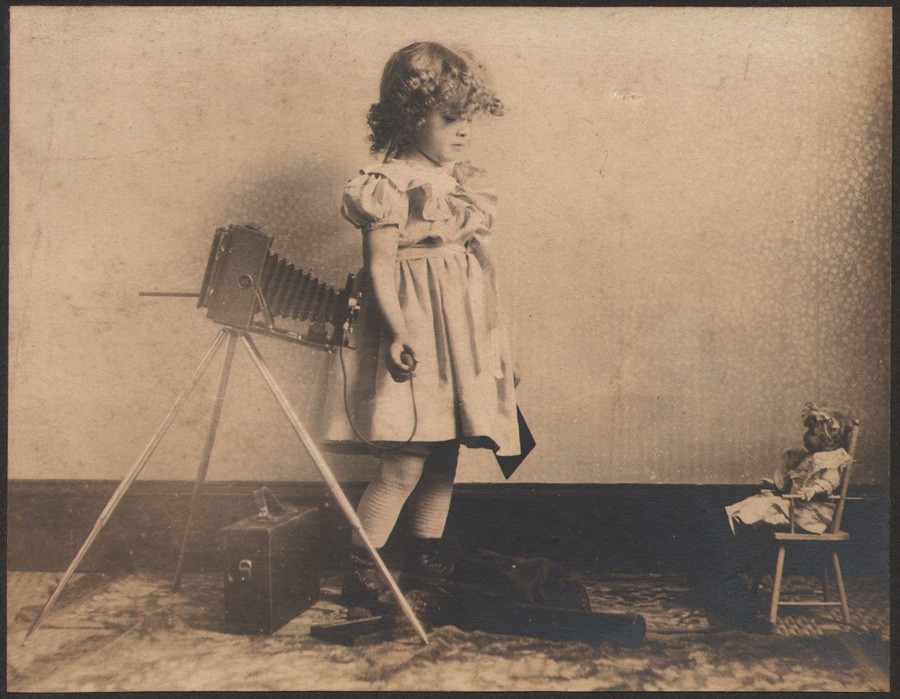 Taken ca. 1903-05 and the subject of an extensive series of photographs by her amateur photographer father from infancy to late teens, Dorothy (b. August, 1899, of Staten Island, N.Y.) prepares to squeeze a bulb shutter while photographing her dolly. This photograph or variant was likely entered in one of the annual "Kodak Competitions" from the period, as it features the company’s products, including a tripod-mounted plate camera. (undetermined model) A camera and tripod case can be seen on floor along with a single plate holder and dark cloth. Dorothy holds the dark slide for the camera in her left hand while making the exposure. Mounted vintage gelatin silver print: 17.9 x 22.0 cm | 11.0 x 14.1 cm: from: PhotoSeed Archive (photographer details withheld pending further research)
Taken ca. 1903-05 and the subject of an extensive series of photographs by her amateur photographer father from infancy to late teens, Dorothy (b. August, 1899, of Staten Island, N.Y.) prepares to squeeze a bulb shutter while photographing her dolly. This photograph or variant was likely entered in one of the annual "Kodak Competitions" from the period, as it features the company’s products, including a tripod-mounted plate camera. (undetermined model) A camera and tripod case can be seen on floor along with a single plate holder and dark cloth. Dorothy holds the dark slide for the camera in her left hand while making the exposure. Mounted vintage gelatin silver print: 17.9 x 22.0 cm | 11.0 x 14.1 cm: from: PhotoSeed Archive (photographer details withheld pending further research)
The so-called “straight” shooters, whose intent was a picture sharply in focus and the “pictorialists”; those embracing the painterly concept of selective focus in their work.
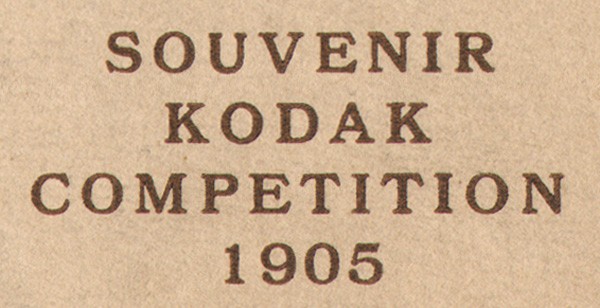 Letterpress detail from cover: (24.2 x 18.0 cm) "Souvenir Kodak Competition 1905". This souvenir book is believed to have been published sometime in 1906 or 1907, the culmination of one of the company’s annual contests which included public exhibitions in major American cities at the end of 1906 and through March of 1907. From PhotoSeed Archive
Letterpress detail from cover: (24.2 x 18.0 cm) "Souvenir Kodak Competition 1905". This souvenir book is believed to have been published sometime in 1906 or 1907, the culmination of one of the company’s annual contests which included public exhibitions in major American cities at the end of 1906 and through March of 1907. From PhotoSeed Archive
This inclusivity was emphasized after the company announced criteria for their selection of judges for the 1905 contest:
In the selection of a jury we have had two important points in mind. First, the selection of gentleman of high standing and unquestioned competency. Second, the selection of gentlemen affiliated with neither of the warring factions ⎯men who are broad-minded enough to recognize merit where it exists in a picture, no matter whether that picture be as sharp as a needle or as woolly as Mary’s little lamb. (1.)
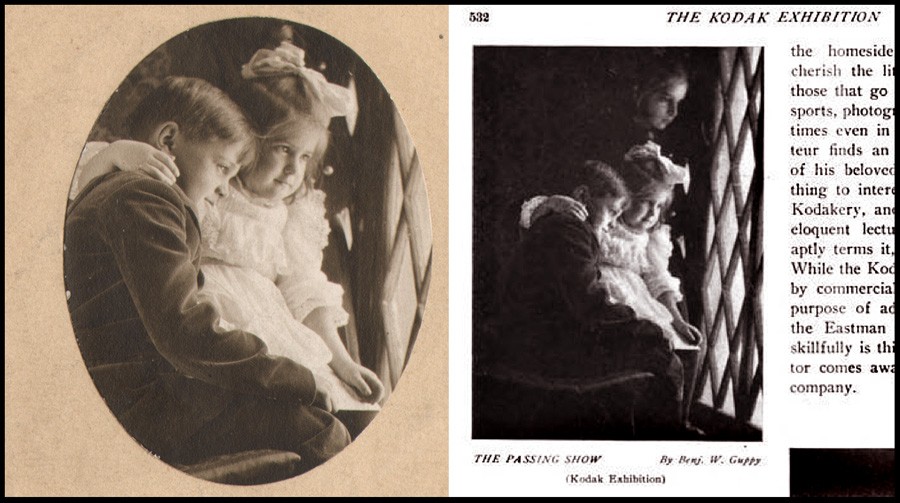 Left: Maine resident and amateur photographer Benjamin Wilder Guppy (1870-1960) won $10.00 and an honorable mention in the "1905 Kodak Competition" for this photograph: "The Passing Show", used as the cover photograph of the souvenir book: gelatin silver print: 6.6 x 5.2 cm. (PhotoSeed Archive) Right: the uncropped version of "The Passing Show" as it appeared in the Kodak exhibitions from 1906-07.: source: halftone from: "The Photographic Times": New York: December, 1906: p. 532
Left: Maine resident and amateur photographer Benjamin Wilder Guppy (1870-1960) won $10.00 and an honorable mention in the "1905 Kodak Competition" for this photograph: "The Passing Show", used as the cover photograph of the souvenir book: gelatin silver print: 6.6 x 5.2 cm. (PhotoSeed Archive) Right: the uncropped version of "The Passing Show" as it appeared in the Kodak exhibitions from 1906-07.: source: halftone from: "The Photographic Times": New York: December, 1906: p. 532
Rhetoric aside, these judges certainly had artistic ambitions. They were:
Charles Berg: (1856-1926) studied at the Ecole des Beaux Arts in Paris and London, opening an architectural practice in New York City in 1880, and later designing one of the city’s earliest skyscrapers, the Gillender Building. In 1896 he became a founding member of the Camera Club of New York, and his amateur work reflected his classical training-classically draped models often surrounded by architectural elements.
Arthur Radclyffe Dugmore: (1870-1955) at the time of the 1905 contest a pioneering nature photographer, he had the distinction in 1903 of one of his photographs, “A Study in Natural History”, a photogravure of baby birds, appearing in the first issue of Camera Work I. He later became a recognized painter and printmaker.
Henry Troth: (1863-1948) was an active member of the Photographic Society of Philadelphia, a pioneering artistic photography society in the United States. A professional photographer specializing in genre and the natural world, his work appeared in magazines and volume compilations of poetry and verse, often uncredited, such as Poetry of Nature. (1909)
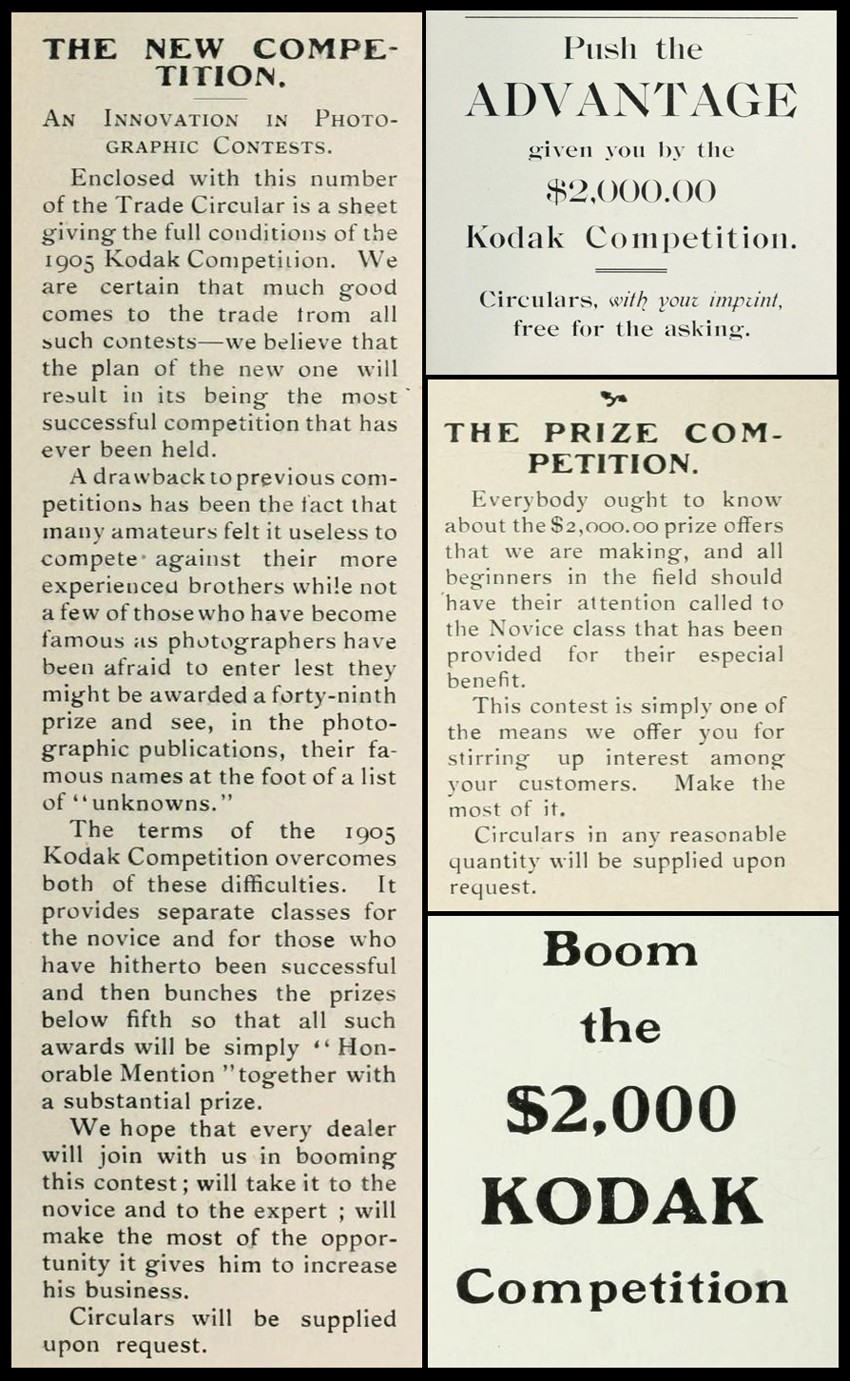 The 1905 Kodak Competition as well as the annual contests that followed were heavily promoted by the Eastman Kodak Company in their dealer trade circulars. This composite of editorial and advertising matter are taken from 1904-05. Left: first notice for the contest appeared in December, 1904. Right column, top: Kodak dealers are told of the Advantage they would receive (in increased sales) by "pushing" the contest on their customers. Middle: In January, dealers are alerted that "all beginners in the field should have their attention called to the Novice class that has been provided for their especial benefit." "This contest is simply one of the means we offer you for stirring up interest among your customers." Bottom: The term "Boom", an arcane word similar to "Shout" from the beginning of the 20th century, was used in an advertisement for the contest in the May, 1905 issue of the circular. Letterpress pages from Canadian Kodak Co., Limited Trade Circular: Toronto: online resource courtesy Ryerson University Library Special Collections
The 1905 Kodak Competition as well as the annual contests that followed were heavily promoted by the Eastman Kodak Company in their dealer trade circulars. This composite of editorial and advertising matter are taken from 1904-05. Left: first notice for the contest appeared in December, 1904. Right column, top: Kodak dealers are told of the Advantage they would receive (in increased sales) by "pushing" the contest on their customers. Middle: In January, dealers are alerted that "all beginners in the field should have their attention called to the Novice class that has been provided for their especial benefit." "This contest is simply one of the means we offer you for stirring up interest among your customers." Bottom: The term "Boom", an arcane word similar to "Shout" from the beginning of the 20th century, was used in an advertisement for the contest in the May, 1905 issue of the circular. Letterpress pages from Canadian Kodak Co., Limited Trade Circular: Toronto: online resource courtesy Ryerson University Library Special Collections
Particulars
In late 1904, Kodak announced they would break down and eliminate what they felt had been barriers for amateurs and professionals alike in regard to photographic contests up to that period:
A drawback to previous competitions has been the fact that many amateurs felt it useless to compete against their more experienced brothers while not a few of those who have become famous as photographers have been afraid to enter lest they might be awarded a forty-ninth prize and see, in the photographic publications, their famous names at the foot of a list of unknowns.
The terms of the 1905 Kodak Competition overcomes both of these difficulties. It provides separate classes for the novice and for those who have hitherto been successful and then bunches the prizes below fifth so that all such awards will be simply “Honorable Mention” together with a substantial prize. (2.)
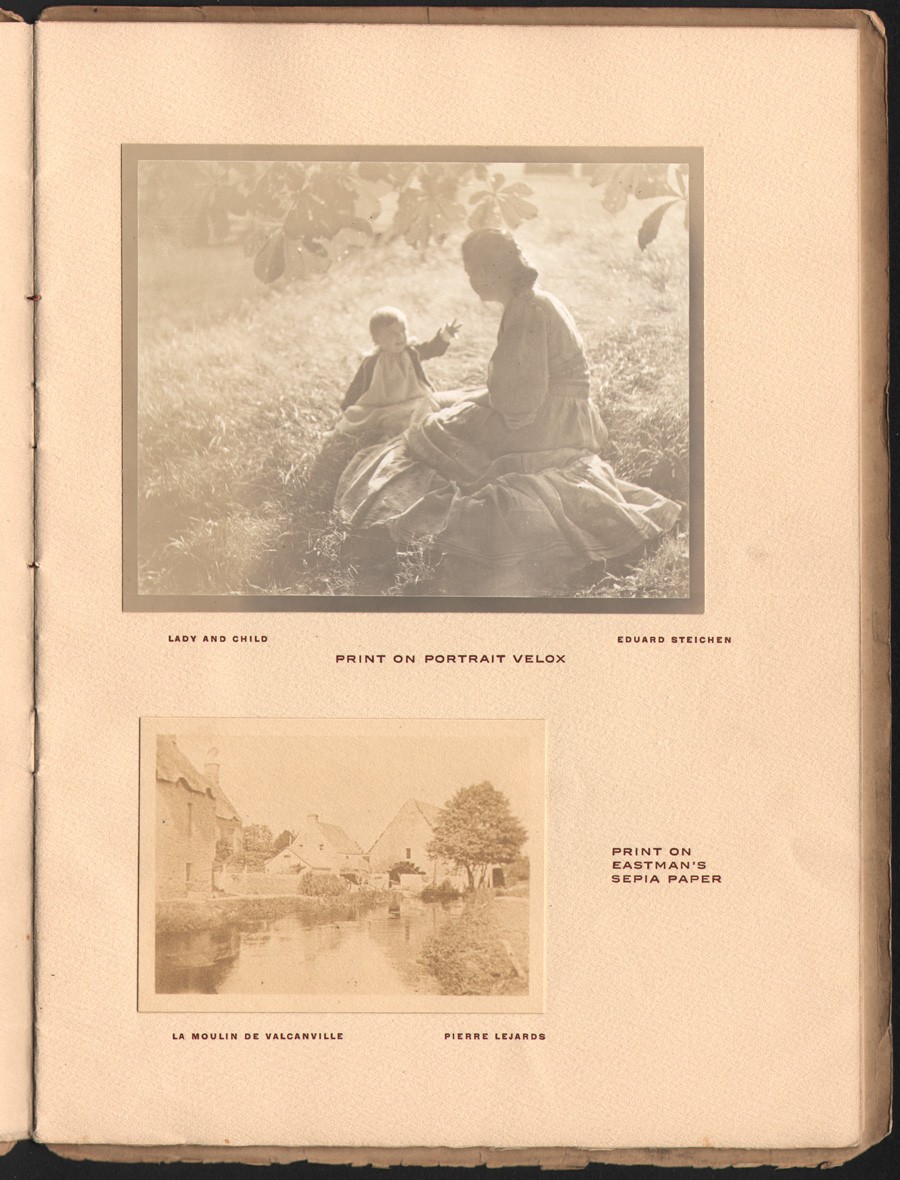 Ten original photographs printed on Kodak gelatin silver papers are featured in the souvenir book for the 1905 Kodak Competition. Top: "Lady and Child", (9.8 x 12.2 cm | 9.1 x 11.5 cm) likely from a copy negative or print, (as it includes a gray border) is by American master Edward Steichen. Printed on Portrait Velox paper, it is also known as Mother and Child — Sunlight, (published as a photogravure in Camera Work XIV) and won the $150.00 first prize for him in the Class A Open category, featuring negatives 3 ¼ x 4 ¼ or larger in size. Bottom: "La Moulin de Valcanville" (6.2 x 8.5 cm |5.4 x 7.8 cm) by Pierre Lejards of Paris, France is printed on Eastman's Sepia Paper. It was awarded honorable mention and earned him a No. 0 F.P. Kodak camera in the Class F Novice category. (Brownie Pictures) from: PhotoSeed Archive
Ten original photographs printed on Kodak gelatin silver papers are featured in the souvenir book for the 1905 Kodak Competition. Top: "Lady and Child", (9.8 x 12.2 cm | 9.1 x 11.5 cm) likely from a copy negative or print, (as it includes a gray border) is by American master Edward Steichen. Printed on Portrait Velox paper, it is also known as Mother and Child — Sunlight, (published as a photogravure in Camera Work XIV) and won the $150.00 first prize for him in the Class A Open category, featuring negatives 3 ¼ x 4 ¼ or larger in size. Bottom: "La Moulin de Valcanville" (6.2 x 8.5 cm |5.4 x 7.8 cm) by Pierre Lejards of Paris, France is printed on Eastman's Sepia Paper. It was awarded honorable mention and earned him a No. 0 F.P. Kodak camera in the Class F Novice category. (Brownie Pictures) from: PhotoSeed Archive
A true marketing ploy, the company also made sure there would be plenty of time for those contemplating a submission for the contest. In America, entrants had up to November 1st to enter and in England, a month earlier, although this was changed to a later date to accommodate the mailing of the large amount of submissions, which totaled 28,000 entries worldwide. Particulars for the contest were printed in multiple publications, including the January 1905 issue of Camera & Dark-Room:
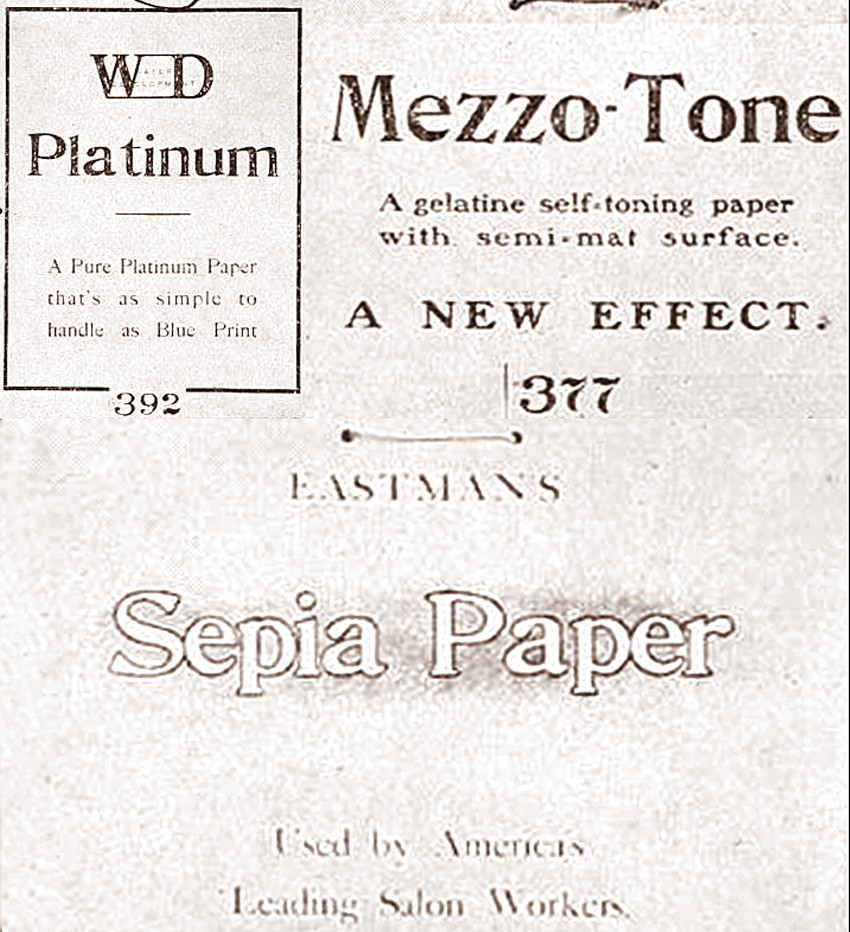 The September, 1904 issue of the Kodak Trade Circular featured brand logos of various Kodak papers, including W-D Platinum, (water development) Mezzo-Tone, and Eastman's Sepia Paper. Along with Portrait and Velvet Velox, the papers were used to print winning entries for the 1905 Kodak Competition souvenir book. Composite letterpress advertisements: Canadian Kodak Co., Limited Trade Circular: Toronto: online resource courtesy Ryerson University Library Special Collections
The September, 1904 issue of the Kodak Trade Circular featured brand logos of various Kodak papers, including W-D Platinum, (water development) Mezzo-Tone, and Eastman's Sepia Paper. Along with Portrait and Velvet Velox, the papers were used to print winning entries for the 1905 Kodak Competition souvenir book. Composite letterpress advertisements: Canadian Kodak Co., Limited Trade Circular: Toronto: online resource courtesy Ryerson University Library Special Collections
The 1905 Kodak Competition.
We have pleasure in announcing that another great picture competition is to take place during the year. The Eastman Kodak Company offer $2,000 in prizes and have arranged for two classes of competitors, “Open” and “Novice.” The “open” class is for all who may care to enter, but the “novice” is open only to amateurs who have never won a prize in a photographic contest. This is a feature which will greatly please many who do good work but who do not care to compete against the regular pot hunters.
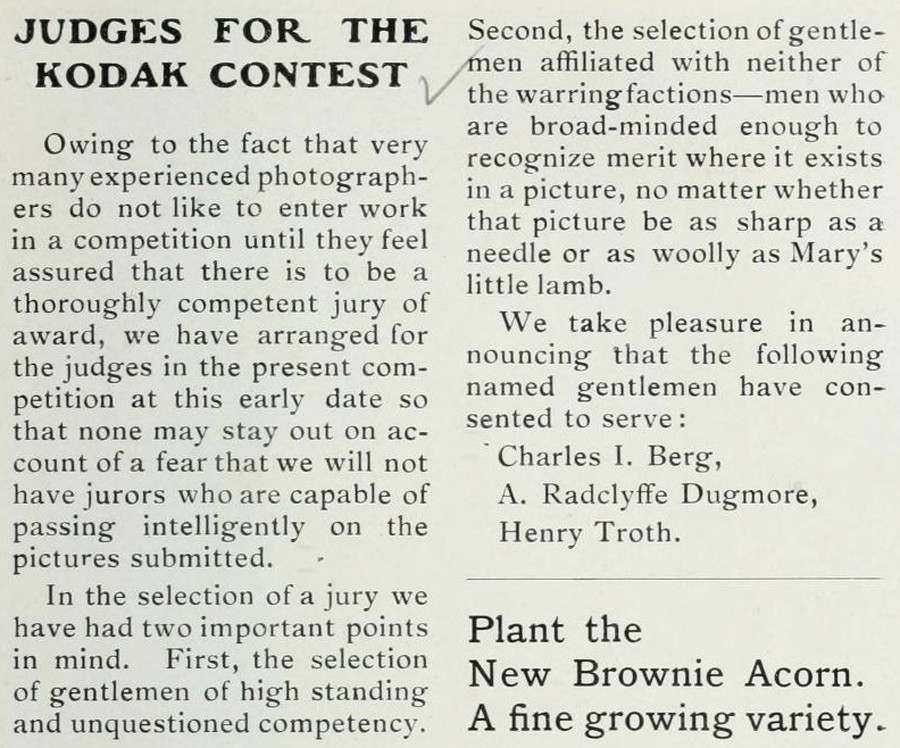 "Sharp as a needle or as woolly as Mary's little lamb" : In announcing the three judges for the 1905 Competition, the April, 1905 issue of the Kodak Trade Circular let it be known the contest would be open to all schools of photography, as well as degrees of experience. from: Canadian Kodak Co., Limited Trade Circular: Toronto: online resource courtesy Ryerson University Library Special Collections
"Sharp as a needle or as woolly as Mary's little lamb" : In announcing the three judges for the 1905 Competition, the April, 1905 issue of the Kodak Trade Circular let it be known the contest would be open to all schools of photography, as well as degrees of experience. from: Canadian Kodak Co., Limited Trade Circular: Toronto: online resource courtesy Ryerson University Library Special Collections
The classes and conditions are as follows:
Class A. Open to all. For Kodak pictures 3 ¼ x 4 ¼ or larger, including the Panoram Kodaks.
Class B. Open to all. For Kodak pictures 3 ½ x 3 ½ or smaller, including No. 1A Folding Pocket Kodak.
Class C. Open to all. For enlargements of any size from Kodak or Brownie negatives on Eastman. Nepera or Photo-Materials Bromide Paper.
Class D. Novice. Open only to amateurs who have never been awarded a prize in a photographic contest. For Kodak pictures 3 ¼ x 4 ¼ or larger, including the Panoram Kodaks.
Class E. Novice. Open only to amateurs who have never been awarded a prize in a photographic contest. For Kodak pictures 3 ½ x 3 ½ or smaller, including No. 1A Folding Pocket Kodak.
Class F. Novice. Open only to amateurs who have never been awarded a prize in a photographic contest. For Brownie pictures only.
All pictures sent in for competition must be from negatives made with a Kodak or Brownie on Kodak N. C. Film, and must be printed on papers manufactured or sold by us.
PRINTS ONLY are to be sent in; not negatives.
Prints must be mounted, but not framed.
The title of the picture, with the name and address of the competitor, class entered for, and the name of the printing paper used for the pictures, must be legibly written on the back of mount.
The films must have been exposed by the competitor, but it is not necessary that competitors finish their own pictures.
No competitor will be awarded more than one prize in a class.
Not more than one prize will be awarded to prints from one negative, except that all Velox Prints will be considered In the awarding of the Special Velox Prizes regardless of the prizes said prints may have received in the other classes.
Contact prints from the same negative cannot be entered in two classes.
This contest closes at Rochester. N. Y., on November 1, 1905; at Toronto. Canada, on October 20, 1905. and at London, Eng., on October 1, 1905.
All entries sent in from the United States and the possessions thereof and from South America should be addressed to EASTMAN KODAK CO..
Kodak Contest Dep’t. Rochester, N. Y. (3.)
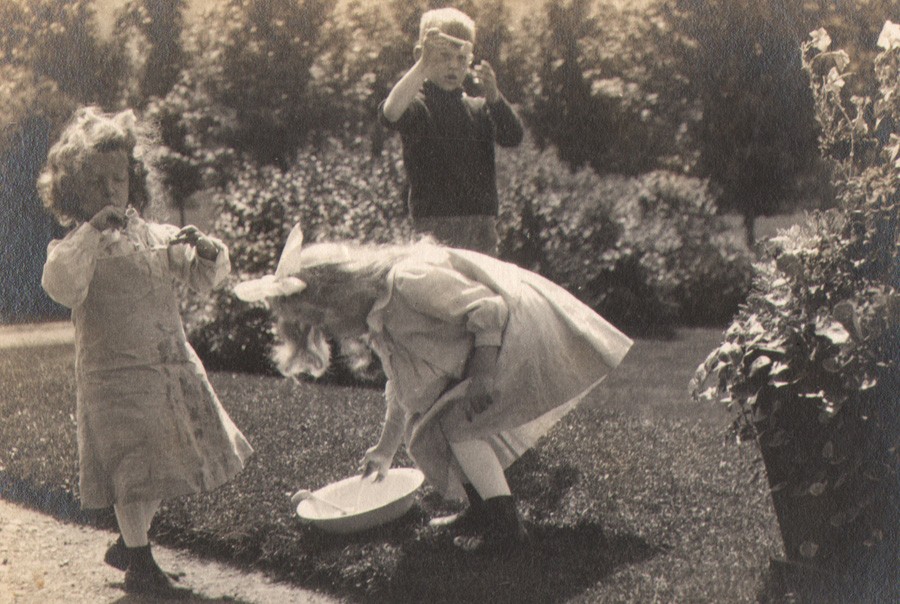 Detail: Alfred Stieglitz: "Soap Bubbles", from 1905 Kodak Competition Souvenir book. (8.8 x 14.4 cm | 8.0 x 13.7 cm) Printed on Velvet Velox and believed to be from the original negative, Stieglitz received an honorable mention and $20.00 in the Kodak contest in Class C Open category for Enlargements. from: PhotoSeed Archive
Detail: Alfred Stieglitz: "Soap Bubbles", from 1905 Kodak Competition Souvenir book. (8.8 x 14.4 cm | 8.0 x 13.7 cm) Printed on Velvet Velox and believed to be from the original negative, Stieglitz received an honorable mention and $20.00 in the Kodak contest in Class C Open category for Enlargements. from: PhotoSeed Archive
History of Kodak Competitions
Little scholarship seems to have been spent on the annual photographic competitions which in turn lead to public exhibitions sponsored by the Eastman Kodak Company in the early years of the late 19th and early 20th centuries. Besides accomplishing the desired result of brand recognition, they are undoubtedly a rich resource for understanding the changing aesthetic trends for primarily amateur photography during this period.
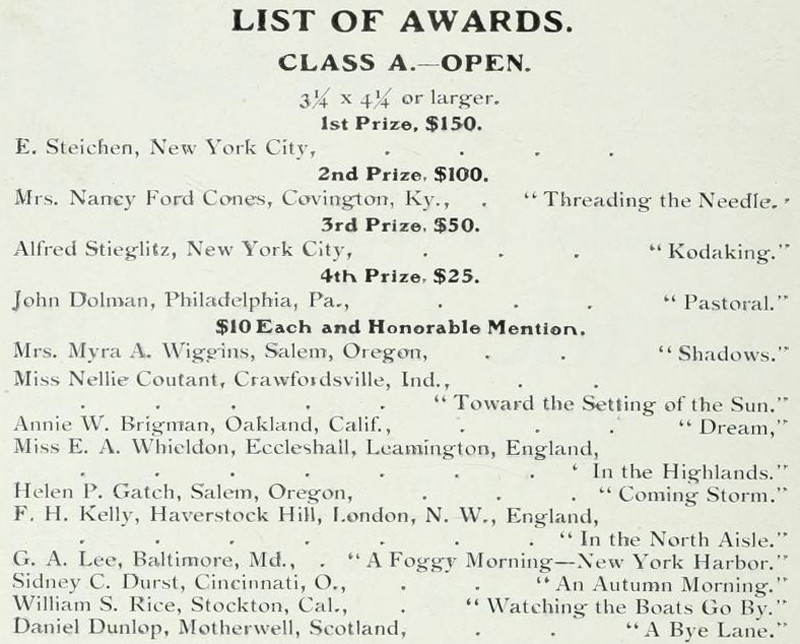 Detail: letterpress: Awards for the 1905 Kodak Competition were announced and listed in March, 1906. Some of the results for the bigger names who competed in Class A, Open category, (negatives 3 ¼ x 4 ¼ or larger in size) are seen here. From: Canadian Kodak Co., Limited Trade Circular: Toronto: March, 1906: online resource courtesy Ryerson University Library Special Collections
Detail: letterpress: Awards for the 1905 Kodak Competition were announced and listed in March, 1906. Some of the results for the bigger names who competed in Class A, Open category, (negatives 3 ¼ x 4 ¼ or larger in size) are seen here. From: Canadian Kodak Co., Limited Trade Circular: Toronto: March, 1906: online resource courtesy Ryerson University Library Special Collections
Of the resulting exhibition which the 1905 competition spawned, a Photographic Times editor provided an overview but also gave it a veiled endorsement after it closed at Madison Square Garden Concert Hall in New York City in November, 1906:
While the Kodak Exhibition is prompted by commercial interests and is for the purpose of advertising the products of the Eastman Kodak Company, yet so skillfully is this concealed that each visitor comes away feeling indebted to the company.
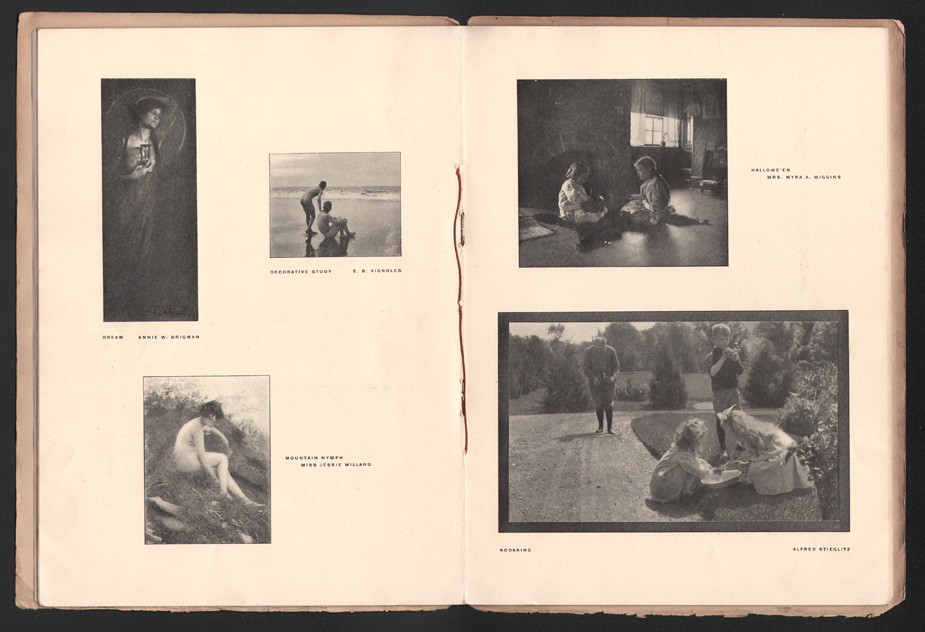 20 winning photographs printed as halftones (printed on coated manilla stock) are featured in the souvenir book for the 1905 Kodak Competition. This representative page spread features clockwise from top left: "Dream" by Annie W. Brigman, "Decorative Study" by E.B. Vignoles, "Hallowe'en" by Mrs. Myra A. Wiggins, "Kodaking" by Alfred Stieglitz, "Mountain Nymph" by Miss Jessie Willard. Dimensions of open book sans card cover: 23.5 x 34.5 cm from: PhotoSeed Archive
20 winning photographs printed as halftones (printed on coated manilla stock) are featured in the souvenir book for the 1905 Kodak Competition. This representative page spread features clockwise from top left: "Dream" by Annie W. Brigman, "Decorative Study" by E.B. Vignoles, "Hallowe'en" by Mrs. Myra A. Wiggins, "Kodaking" by Alfred Stieglitz, "Mountain Nymph" by Miss Jessie Willard. Dimensions of open book sans card cover: 23.5 x 34.5 cm from: PhotoSeed Archive
In 1897, one of the very first Kodak international competitions originated in England, which lead to a show known as the Eastman Photographic Exhibition.
Held at the New Gallery on Regent Street in London from October 27 to November 16, 1897, the exhibit drew 25,000 photographic entries from around the world, with $3000.00 in prize money. It was organized by amateur photographer George Davison, (1856-1930) a founding member of the British Linked Ring and Director of the Eastman Photographic Materials Company in England. In America, these annual competitions were promoted by Kodak advertising department manager Lewis Bunnell Jones. And with the known exception of the 1897 show traveling to America in 1898 where it was enlarged and displayed at The National Academy of Design in New York City in January, Jones’ hand became more evident beginning in 1905. At least five years of public exhibitions beginning in 1906, of which the Kodak Competition Souvenir of 1905 is one of the finest records of, was the result:
Under Jones’s autocratic supervision, Kodak’s advertising department devised some of the company’s most legendary campaigns and strategies, including the 1893 introduction of the Kodak Girl in magazine ads and posters; the Traveling Kodak Exhibitions that toured the country between 1905 and 1910; the famous “yellow box” packaging in 1905… “(4.)
 Edward Steichen won 2nd prize and $100.00 in the Class C open category for enlargements for this photo titled "Sheep Study". This halftone version from the enlarged exhibited print was reproduced in London's Amateur Photographer in August, 1907. Compared to the more commonly known version by Steichen's hand, a hand-toned photogravure published in Camera Work XIX, this image is practically "straight". The editors however make their feelings known it does no justice to his original intent: "In the second place, the pictures are not the original prize-winning prints, but enlargements made at the Company's English works; and however skilful the enlarger is, he cannot possibly always catch and elaborate the ideas of men like Steichen. Bearing this in mind, it is easy to imagine the beauty of Steichen's own enlargement of the "Sheep Study," No. 1, with the sheep blended into a soft mass of tones"…
Edward Steichen won 2nd prize and $100.00 in the Class C open category for enlargements for this photo titled "Sheep Study". This halftone version from the enlarged exhibited print was reproduced in London's Amateur Photographer in August, 1907. Compared to the more commonly known version by Steichen's hand, a hand-toned photogravure published in Camera Work XIX, this image is practically "straight". The editors however make their feelings known it does no justice to his original intent: "In the second place, the pictures are not the original prize-winning prints, but enlargements made at the Company's English works; and however skilful the enlarger is, he cannot possibly always catch and elaborate the ideas of men like Steichen. Bearing this in mind, it is easy to imagine the beauty of Steichen's own enlargement of the "Sheep Study," No. 1, with the sheep blended into a soft mass of tones"…
Records from primary source material shed light on these competitions, which beginning in 1907 began to be annually known as the Kodak Advertising Contests:
1904:
Book of the £1,000 Kodak Exhibition.
This is the title, stamped in gold, on the cover of a handsome portfolio just issued by the Kodak Press. “To show something of the work that is being accomplished in pictorial photography by the devotees of the Kodak system.” The world-wide interest in the Kodak competition of 1904 naturally brought together much of the best work of the camera and the public exhibition of the competing pictures in London was an eye-opener to all who could attend. From this exhibition sixty or more prints were selected and have been reproduced in half-tone, which will enable photographers in the most remote localities to see the work of others and note the kind and quality of the work which finds favor with competition judges. (5.)
And from The Photographic Times:
A detailed report of the results of the £1,000 Kodak Competition has been received in this country, and the results cannot but prove gratifying to those who take an interest in the advancement of American photography. There were something over 20,000 entries received, of which about 12,000 were from the British Isles, 2,500 from France, 2,000 from the United States, 1,700 from Germany and 2,000 scattering. The British Isles received 229 prizes, the United States 85 prizes, France 28 and Germany 12. It will thus be seen that the British exhibitors received one prize to every 52 entries, the French one to every 89, the German one to every 141 and the American one to every 23 entries. Our American amateurs, in proportion to their entries, carried off over twice as much as their British cousins, three and a half times as much as the French competitors and did six times as well as the Germans—at least such was the opinion of the British judges who were no less personages than Sir William Abney, Mr. Craig Annan and Mr. Frank Sutcliffe. (6.)
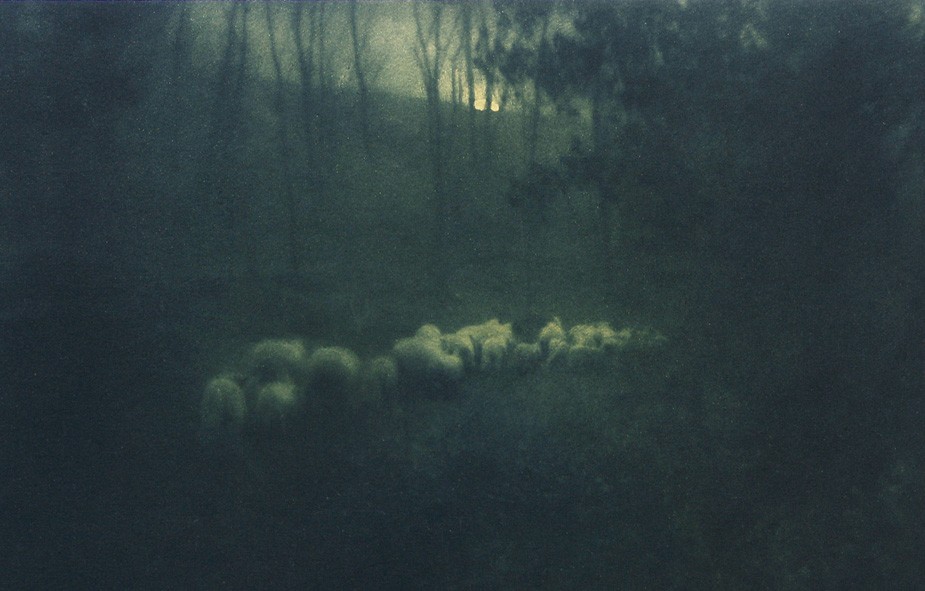 Detail: Edward Steichen: "Pastoral - Moonlight" (Camera Work XIX, 1907: 15.6 x 19.9 cm) This blue/green hand-toned photogravure better reflects the intent of Steichen as it is by his own hand- especially when compared to the "straight" version exhibited in London in 1906 as part of the 1905 Kodak Competition. from: PhotoSeed Archive
Detail: Edward Steichen: "Pastoral - Moonlight" (Camera Work XIX, 1907: 15.6 x 19.9 cm) This blue/green hand-toned photogravure better reflects the intent of Steichen as it is by his own hand- especially when compared to the "straight" version exhibited in London in 1906 as part of the 1905 Kodak Competition. from: PhotoSeed Archive
1905-06
The subject of this post concerns the 1905 Kodak Competition, which concluded the following year in 1906 with public exhibitions in America as well as London, England in 1907.
1907
The 1907 Advertising Contest of the Eastman Kodak Company possessed a far greater value than the securing of good pictures for use in advertising the products of the Eastman Company. Its value from an educational and artistic standpoint is exceedingly great, and of inestimable value to all photographers and illustrators who use other methods than photography. The results of this competition were a revelation as to the possibilities of graphic illustration by means of the camera when handled understandingly.
The pictures possess human interest far surpassing anything that could have been drawn or painted, for the subjects were real live people, and not the imaginative creations of some artistic brain. Such pictures grasp and hold the interest of the reader and, when their story is pleasingly told, are most convincing.
Glance over the advertising section of any of the popular magazines, and see how important a part the camera plays in illustrating and in pictorially clinching the advertiser’s argument. In many instances, the picture has been that of some charming bit of femininity and used often only to hold the attention in order that the accompanying text might be read. (7.)
1908
In 1908, the Eastman Kodak Company sponsored an advertising contest for professional as well as amateur photographers. $1600.00 was offered as cash prizes. Winning submissions would be used to advertise Kodak products. Mrs. W.W. Pearce, an active woman amateur photographer from Waukegan, IL, won first prize and $300.00 in the Class B Amateur class of the contest. The PhotoSeed Archive owns a vintage example of this winning print, and more background on the contest and results from 1908 can be found here.
1909
The contention that better pictures for advertising purposes could be produced by means of photography than by any other artistic method has been still further justified by the result of the 1909 Kodak Advertising Contest.
It is gratifying to note the continued interest of competitors in former contests, and also in highly artistic work submitted by newcomers in the field.
The jury which passed on the work was highly competent, consisting of Mr. Rudolph Eickemeyer, of Davis & Eickemeyer; Mr. A. F. Bradley, ex president of the P. P. S. of New York; Mr. Henry D. Wilson, advertising manager of Cosmopolitan; Mr. C. C. Vernam, general manager of the Smith & Street publications, and Mr. Walter R. Hine, vice-president and general manager of Frank Seaman, Incorporated, one of the largest, if not the largest advertising agency in the United States. Mr. Frank R. Barrows, president of the P. A. of A., was announced as one of the judges, but was unavoidably detained, Mr. Bradley acting in his place. (8.)
1910
THE Eastman Kodak Company, always a most generous patron of photographers, both professional and amateur, has just closed its advertising competition for 1910. This contest has become one of the most important fixtures of the photographic world, not only because of the remarkably large cash prizes awarded, but also because of the tremendous stimulus it has been to the application of photography to advertising. Photo-era has many times called attention to the increasing use of photographs by the general advertiser, and one has only to pick up almost any of the popular magazines and glance at the advertising pages (more interesting, oftentimes, than the body of the letter-press) to see how greatly the ad-writer depends on the halftone cut from a photograph to present his goods in an attractive manner. In this development, beyond question, the Eastman Company has had a large share, and the successful contestants in its contests have gained valuable experience which they can apply with profit, should they so desire, to photographic illustration-work. (9.)
1911
From our standpoint the previous Kodak Advertising Contests have been a distinct and growing success. They have supplied us with pictures that told interestingly of the charm and simplicity of Kodakery. But there has been one drawback. In the professional division (Class A), the prizes have gone so often to the same people that we fear other photographers are likely to be discouraged. In order to remove this possible objection to our contests, these former winners will be barred from participation in Class A in the 1911 competition. (10.)
1913
1913 Kodak Advertising Contest — $3,000.00 In Cash Prizes.— The Kodak Advertising Contests are not for the purpose of securing sample prints. They are for the purpose of securing illustrations to be used in our magazine advertising, for street car cards, for booklet covers and the like.
We prefer photographs to paintings, not only because they are more real, but also because it seems particularly fit that photographs should be used in preference to drawings in advertising the photographic business. The successful pictures are those that suggest the pleasures that are to be derived from the use of the kodak, or the simplicity of the kodak system of photography — pictures around which the advertising man can write a simple and convincing story. Of course the subject is an old one — therefore the more value in the picture that tells the old story in a new way. Originality, simplicity, interest, beauty—and with these good technique —are all qualities that appeal to the judges.
In addition to the prize pictures we often purchase several of the less successful pictures for future use in our advertising. So it will be seen that in reality our prize money is even bigger than we advertise.
There is a big future for the camera in the illustrative field. There’s a growing use of photographs in magazine and book illustrations, to say nothing of the rapid advance along the same lines in advertising work. There’s a constant demand for pictures that are full of human interest. Such are the pictures that we need, that others need. The Kodak Advertising Contests offer an opportunity for your entry into this growing field of photographic work. (11.)
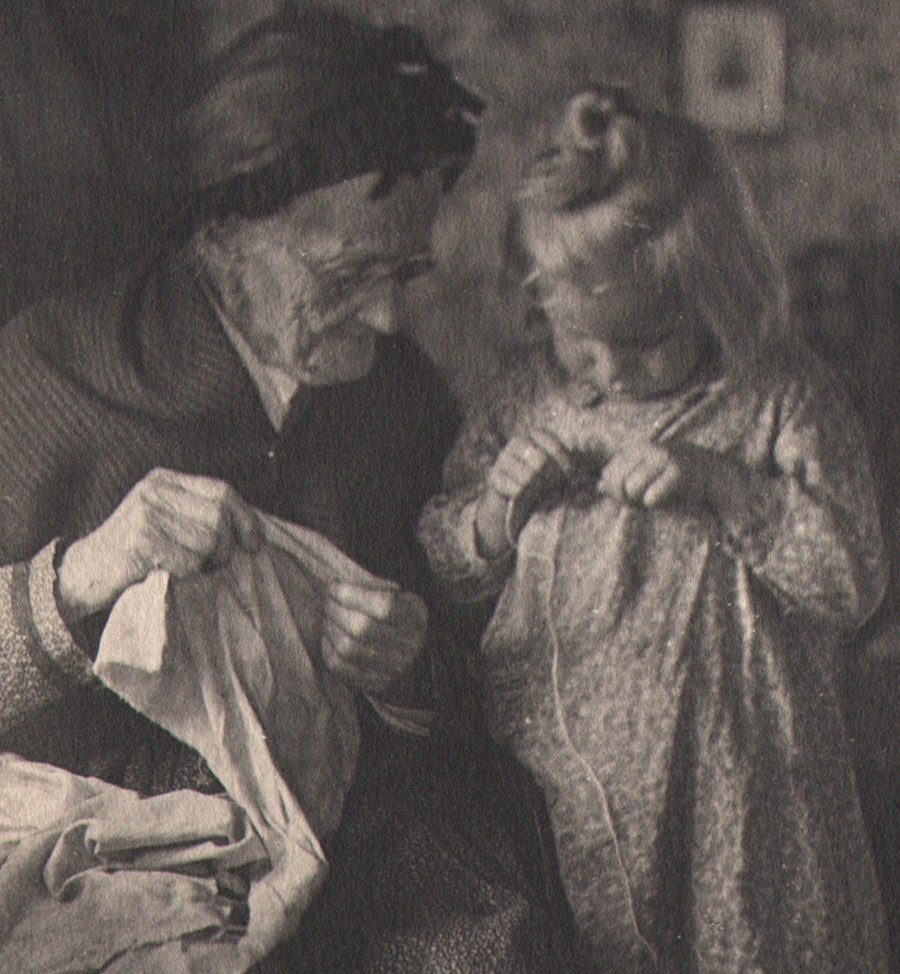 Detail: platinum print: "Threading the Needle", (12.4 x 9.9 cm | 11.7 x 9.2 cm) by Nancy Ford Cones (American,1869-1962) This photograph, printed on Kodak's WD Platinum (water-development) paper, and featured in the 1905 Competition Souvenir book, won the $100.00 second prize for Cones in the Class A Open category, featuring negatives 3 ¼ x 4 ¼ or larger in size. Cones was born in Milan, Ohio but is listed as being from Covington, Kentucky when the photo was taken. from: PhotoSeed Archive
Detail: platinum print: "Threading the Needle", (12.4 x 9.9 cm | 11.7 x 9.2 cm) by Nancy Ford Cones (American,1869-1962) This photograph, printed on Kodak's WD Platinum (water-development) paper, and featured in the 1905 Competition Souvenir book, won the $100.00 second prize for Cones in the Class A Open category, featuring negatives 3 ¼ x 4 ¼ or larger in size. Cones was born in Milan, Ohio but is listed as being from Covington, Kentucky when the photo was taken. from: PhotoSeed Archive
The 1905 Competition might certainly be considered key in launching the careers of many serious amateurs, and it undoubtedly gave others the opportunity to pursue photography professionally as a career:
The Kodak Competitions which have been held during the past six or seven years have been something of a revelation in that they have shown that a very large proportion of those amateurs who take photography seriously are frequent users of the Kodak. The same names that appear as Salon Exhibitors have appeared in the Kodak prize lists and often times the pictures that have hung on the Salon walls were from the same negative that won cash and honor in the Kodak competition. (12.)
Doing the Rest
Similar to celebrity endorsement today, Kodak had the uncanny ability to associate the big photographic names of the early 20th century; including Stieglitz, Steichen and Brigman, with the idea amateur photographers using their products could become as skilled or famous. The often mocked Kodak mantra of “you press the button and we do the rest”-acknowledged even by someone as famous as Stieglitz himself -is ironically shot down when it is learned Kodak made the enlarged prints from competitor’s negatives for exhibition purposes for the 1905 competition and those following it:
THE Kodak Exhibition, at No. 40, Strand, W.C, will come as a surprise to persons who are only accustomed to the ordinary enlargements of prize-winning photographs which are displayed in dealers’ windows; it will come as a decided shock to those who are wont to ridicule the “you press the button, and we do the rest” method of photography. Out of some twenty-eight thousand prints and enlargements which were submitted to the judges at the latest Kodak competition, some sixty were adjudged prizes varying from one to thirty pounds; and the negatives of these prints, which have become the property of the Kodak Company, have been enlarged into huge enlargements at the Kodak works, and are now on view for all to see.
There are many well-known names amongst the prizewinners—Steichen, Stieglitz, Harold Baker, Mrs. Barton, Miss Annie Brigman—but these only made the exposures and developed the negatives, Kodak has done the rest, and, as a rule, Kodak has done it uncommonly well. It is not, of course, to be imagined that the Company’s enlargements of negatives by such individual workers as Steichen and Stieglitz are similar to the results that these men would have themselves obtained, but the wonder is that the work has been done so well. The enlargements of Stieglitz’s negatives are particularly good, especially that of “Soap Bubbles,” No. 7, in which the feeling of light and atmosphere has been successfully maintained; and those subjects in which the figures are lit from behind, and, so to speak, silhouetted against the light, are not easy to handle. …
In considering the question of the awards, two facts must be borne in mind: in the first place, the judges in this particular competition belonged to the American school of photography, and the present tendency of this school is to ascribe great merit to original and beautiful schemes of natural outdoor lighting; and therefore we find Steichen’s tour de force, “Mother and Child,” No. 60, awarded the first prize in Class A; and photographs taken against the light have scored throughout. However, such subjects are undoubtedly beautiful, and the rendering of true values in such subjects is exceedingly difficult, and therefore the attitude of the judges is comprehensible. In the second place, the pictures are not the original prize-winning prints, but enlargements made at the Company’s English works; and however skilful the enlarger is, he cannot possibly always catch and elaborate the ideas of men like Steichen.
Bearing this in mind, it is easy to imagine the beauty of Steichen’s own enlargement of the “Sheep Study,” No. 60, with the sheep blended into a soft mass of tones; and the above-mentioned “Mother and Child” (with the imperfections in the values of the child’s hand corrected during the enlargement) must have been quite good in the original; Stieglitz’s “Bubbles,” No. 7, however, has lost but little through enlargement, and although Stieglitz would probably have rendered the subject in a higher key, the Kodak work is excellent.
Why has not Miss Annie Brigman’s “Melody” (15) secured a first prize? It is certainly one of the gems of the collection, and it is good throughout, from the posing and lighting of the hand which holds the mandolin, to the subdued lighting of the music illuminated only by the light reflected from the face of “Melody.” Possibly the judges may have considered the lighting, which might have been arranged by Rembrandt himself, somewhat artificial; but there is no doubt that European judges would have thought differently. This picture, taken with a Kodak, enlarged on Kodak bromide paper, by the Kodak Company, is one of the finest pictures ever rendered by the camera. (13.)
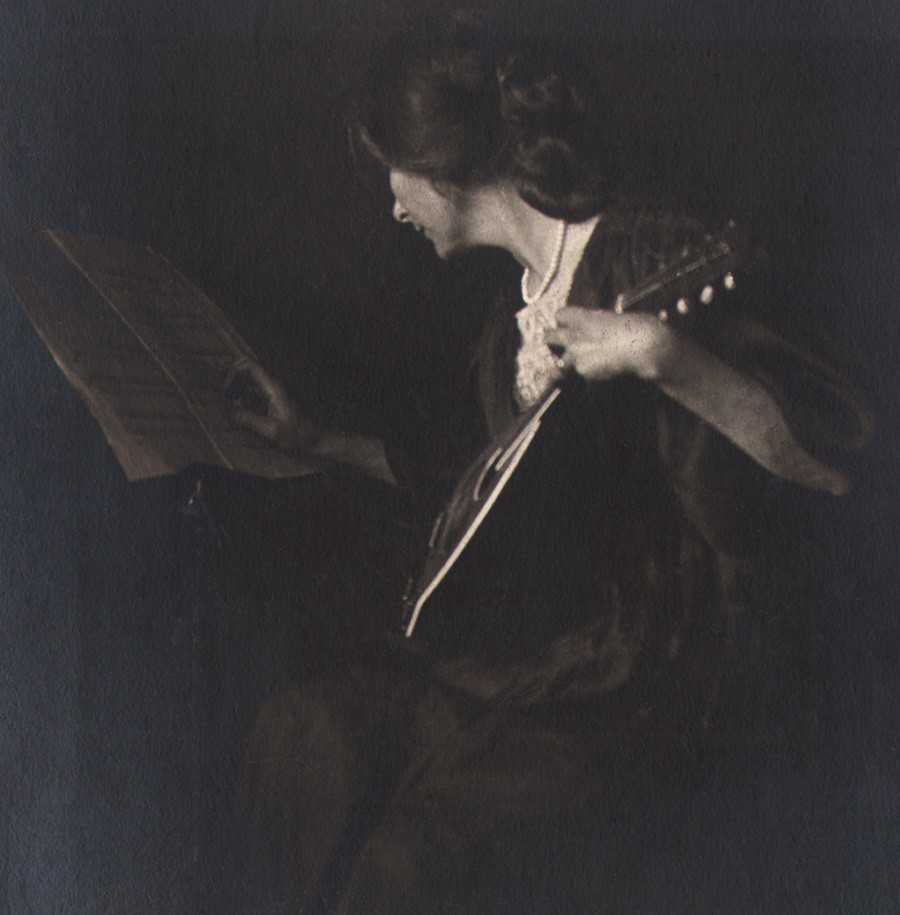 Detail: gelatin silver print: "Melody", (16.4 x 11.2 cm | 15.7 x 10.6 cm) by Anne Brigman (American, 1869-1950) This photograph, which a critic in London's Amateur Photographer journal in 1907 proclaimed "One of the finest pictures ever rendered by the camera" is printed on Kodak's Carbon Velox paper, and featured in the 1905 Competition Souvenir book. It won an honorable mention and $20.00 for Brigman in the Class C Open category for Enlargements. The photo is also known as "Woman with Mandolin" from: PhotoSeed Archive
Detail: gelatin silver print: "Melody", (16.4 x 11.2 cm | 15.7 x 10.6 cm) by Anne Brigman (American, 1869-1950) This photograph, which a critic in London's Amateur Photographer journal in 1907 proclaimed "One of the finest pictures ever rendered by the camera" is printed on Kodak's Carbon Velox paper, and featured in the 1905 Competition Souvenir book. It won an honorable mention and $20.00 for Brigman in the Class C Open category for Enlargements. The photo is also known as "Woman with Mandolin" from: PhotoSeed Archive
Notes
1. excerpt: Judges for the Kodak Contest: Kodak Trade Circular: Toronto, Canada: April, 1905
2. Ibid: Kodak Trade Circular: December, 1904
3. Camera & Dark-Room: Edited by J.P. Chalmers: New York: January, 1905: p. 30
4. excerpt: A Short History of Kodak Advertising 1888-1932: Kodak and the Lens of Nostalgia: Nancy Martha West: The University Press of Virginia: 2000: p. 27
5. excerpt: Book of the £1,000 Kodak Exhibition: The Camera and Dark-Room: New York: January, 1905: pp. 29-30
6. excerpt: £1,000 Kodak Exhibition: Notes, News & Extracts: The Photographic Times: New York: September, 1904: p. 426
7. excerpt: The Kodak Advertising Contest: The Photographic Times: May, 1908: p. 154. The top prize of $1000.00 was awarded to E. Donald Roberts of Detroit.
8. excerpt: AWARDS, PROFESSIONAL CLASS, 1909 KODAK ADVERTISING CONTEST: Wilson’s Photographic Magazine: New York: January, 1910: p. 46
9. excerpt: The Eastman Advertising-Competition: Malcolm Dean Miller: Photo-Era: Boston: January, 1911: p. 73
10. excerpt: With the Trade: 1911 Kodak Advertising-Contest: Photo-Era: Boston: March, 1911: p. 157
11. excerpt: Our Table: American Photography: Boston: May, 1913: pp. 311-312
12. Advertisements: Eastman Kodak Company: excerpt: The New Competition: The American Amateur Photographer: New York: Jan-Dec. 1905
13. excerpt: The Kodak Picture Exhibition: The Amateur Photographer: London: August 27, 1907: pp. 200-01
Neue look at Kühn
Posted June 2012 in Exhibitions, Painters|Photographers
An objective reviewer I am not when it comes to photographers considered major figures in the emerging artistic aesthetic movement from the beginning of the 20th century.
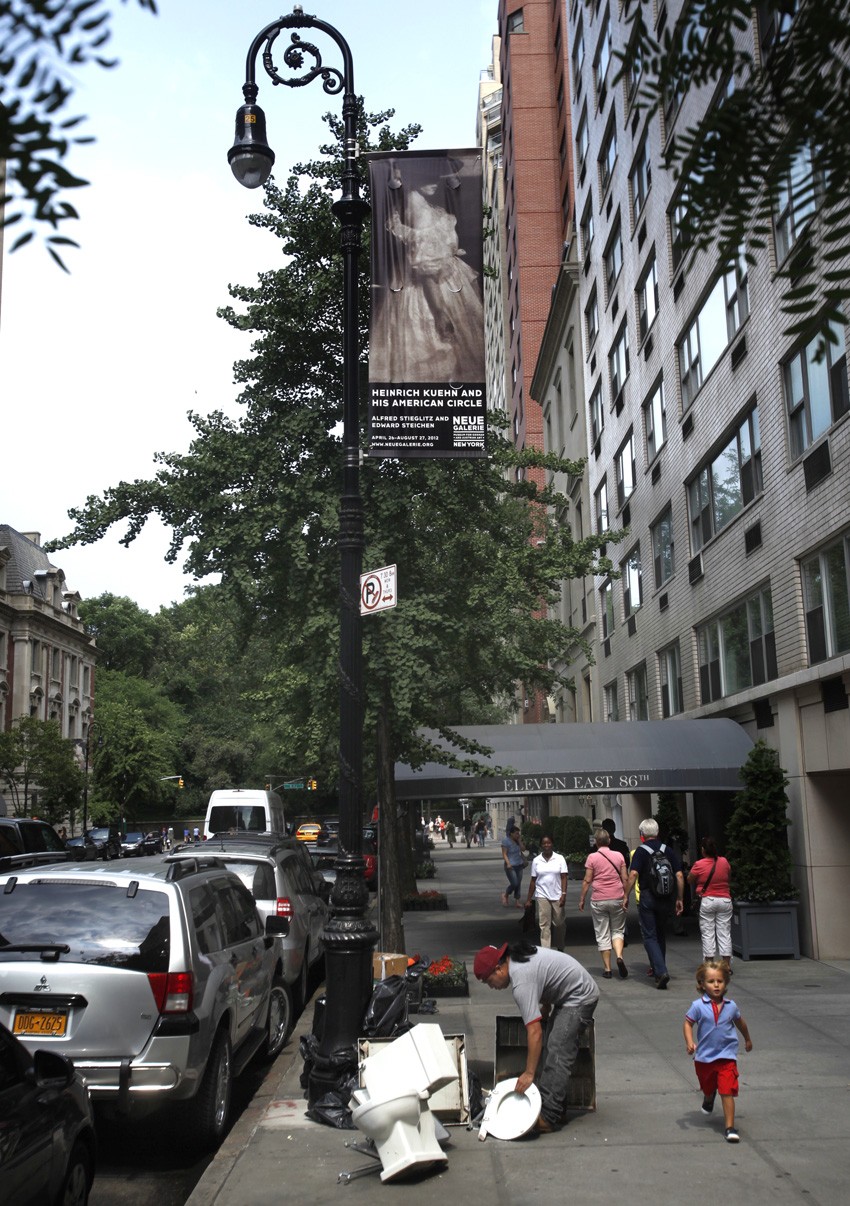 While a lampost banner with the Heinrich Kühn photograph "Study in Tonal Values III, (Mary Warner)" taken in 1908 is displayed along East 86th Street near the New York City museum Neue Galerie for the show "Heinrich Kuehn and his American Circle: Alfred Stieglitz and Edward Steichen", the evolving tableau of life on the street below provides for a continual source of photographic delights. PhotoSeed Archive photograph by David Spencer
While a lampost banner with the Heinrich Kühn photograph "Study in Tonal Values III, (Mary Warner)" taken in 1908 is displayed along East 86th Street near the New York City museum Neue Galerie for the show "Heinrich Kuehn and his American Circle: Alfred Stieglitz and Edward Steichen", the evolving tableau of life on the street below provides for a continual source of photographic delights. PhotoSeed Archive photograph by David Spencer
Instead, shameless promoter would perhaps better describe my enthusiasm for Austrian Heinrich Kühn, (1866-1944) the subject of a museum exhibition now taking place in New York City. And with that, I heartily recommend a visit to:
Heinrich Kuehn and his American Circle: Alfred Stieglitz and Edward Steichen
now on view at the Neue Galerie through August 27th.
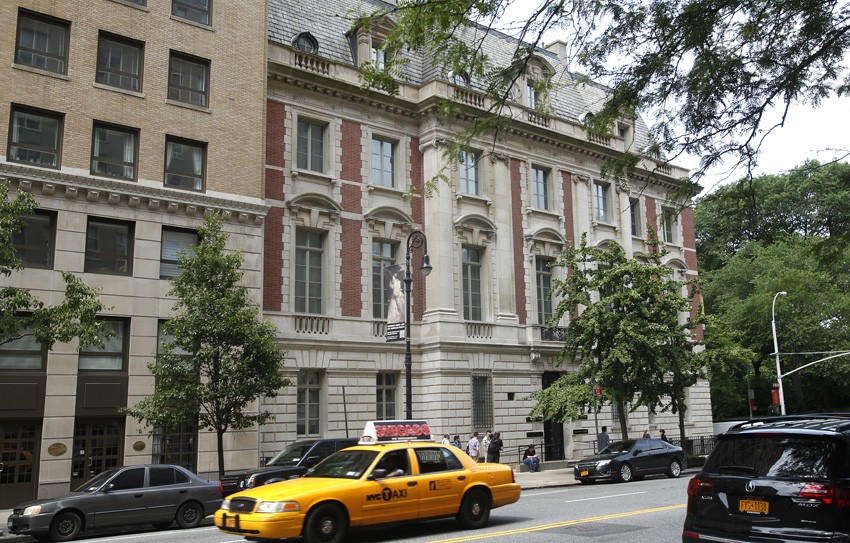 Originally finished in 1914 for the industrialist William Starr Miller II at 1048 Fifth Avenue by the architectural firm Carrère & Hastings, (responsible for the design of the New York Public Library) the Neue Galerie was first opened to the public in 2001 and specializes in German and Austrian art and design. PhotoSeed Archive photograph by David Spencer
Originally finished in 1914 for the industrialist William Starr Miller II at 1048 Fifth Avenue by the architectural firm Carrère & Hastings, (responsible for the design of the New York Public Library) the Neue Galerie was first opened to the public in 2001 and specializes in German and Austrian art and design. PhotoSeed Archive photograph by David Spencer
It was exhilarating to be back in New York so soon after my attendance at the Webby awards, but this was a working trip for PhotoSeed, with the first half of the day spent uptown at the Neue Galerie and the rest spent downtown working on an upcoming post on the history of The Photographic Times.
 Left: self-portrait of Heinrich Kühn from October, 1901 issue of Photographisches Centralblatt; Middle: detail: multiple-color lithograph by Munich illustrator Fritz Rehm for German dry plate manufacturer Otto Perutz; Right: detail: Peter Behrens Jugendstil calendar. (all from PhotoSeed Archive) All three artists represented here were active participants in the Munich Secession at the end of the 19th century, an important exchange of creative ideas and radical thought made real through their own works. Behrens, whose work is in the permanent collection at the Neue Galerie, later went on to be one of the founders of the German Werkbund, a German modernist arts & crafts movement founded in 1907.
Left: self-portrait of Heinrich Kühn from October, 1901 issue of Photographisches Centralblatt; Middle: detail: multiple-color lithograph by Munich illustrator Fritz Rehm for German dry plate manufacturer Otto Perutz; Right: detail: Peter Behrens Jugendstil calendar. (all from PhotoSeed Archive) All three artists represented here were active participants in the Munich Secession at the end of the 19th century, an important exchange of creative ideas and radical thought made real through their own works. Behrens, whose work is in the permanent collection at the Neue Galerie, later went on to be one of the founders of the German Werkbund, a German modernist arts & crafts movement founded in 1907.
After emerging from the subway at 86th street from Grand Central and walking towards Fifth Ave., I spied a lamppost promotional banner for the show, complete with a readymade arranged beneath it: a toilet bowl cast off near the curb and the activity of the street all around it. For those game enough, New York is the kind of place where street photography could easily supplant any type of planned tourist activities, and so my inner muse, taken with the scene, made a few quick frames before venturing a short distance to the entrance of the impressive pile located at 1048 Fifth avenue-a New York landmark completed in 1914 by Carrère & Hastings- the same architectural firm that built the New York Public Library.
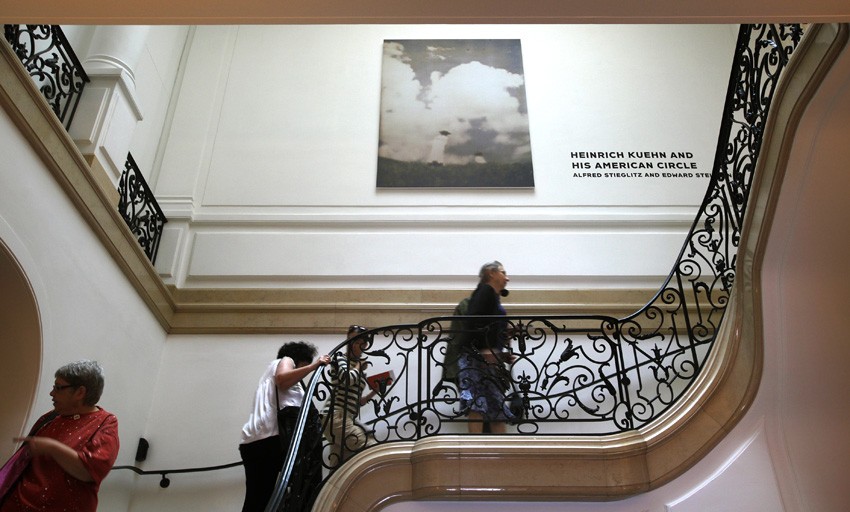 The sweeping wrought-iron staircase seemed a perfect fit for whisking visitors to the third floor exhibition galleries at the Neue Galerie, where some of the breathtaking landscape work of Kühn was on display in the form of vintage, large format gum-bichromate prints. An enlarged exhibition panel above the visitors at center is taken from the photograph "Mary Warner and Edeltrude on the Brow of a Hill", ca. 1908-originally taken by Kühn on a color Autochrome Lumière plate, first introduced in 1907. PhotoSeed Archive photograph by David Spencer
The sweeping wrought-iron staircase seemed a perfect fit for whisking visitors to the third floor exhibition galleries at the Neue Galerie, where some of the breathtaking landscape work of Kühn was on display in the form of vintage, large format gum-bichromate prints. An enlarged exhibition panel above the visitors at center is taken from the photograph "Mary Warner and Edeltrude on the Brow of a Hill", ca. 1908-originally taken by Kühn on a color Autochrome Lumière plate, first introduced in 1907. PhotoSeed Archive photograph by David Spencer
The converted Georgian-style townhouse was originally built for industrialist William Starr Miller II (1856-1935) and purchased in 1994 by art dealer and museum exhibition organizer Serge Sabarsky and businessman, cosmetics heir and art collector Ronald Lauder. German for “New Gallery”, the Neue Galerie is a museum featuring early 20th century German and Austrian art and design, which recently celebrated it’s 10th anniversary in November, 2011.
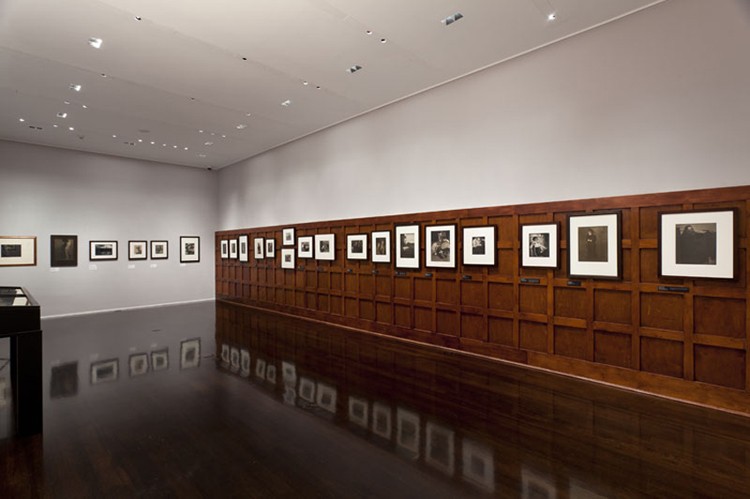 The 4th gallery exhibition space, titled "Family Drama", is taken up at right by a dark cherry-stained wood lattice panel: a re-creation of the backdrop Kühn utilized for some of his portraits. Photograph courtesy of the Neue Galerie.
The 4th gallery exhibition space, titled "Family Drama", is taken up at right by a dark cherry-stained wood lattice panel: a re-creation of the backdrop Kühn utilized for some of his portraits. Photograph courtesy of the Neue Galerie.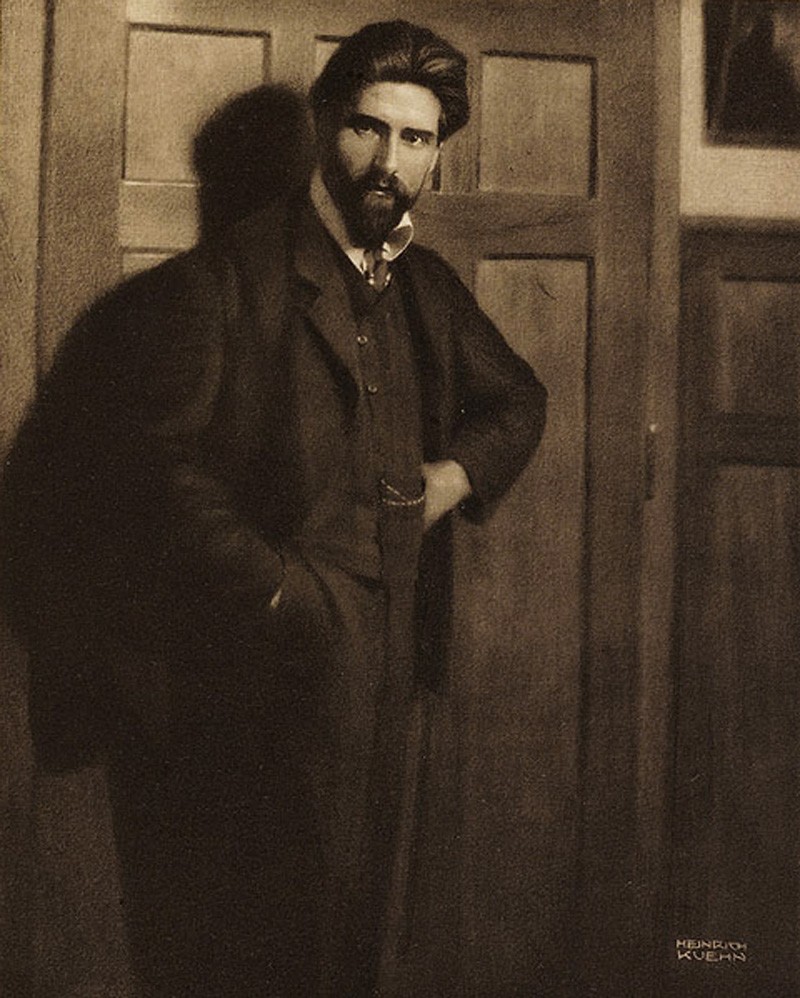 One of many portraits Kühn used the backdrop for was for this study of Tyrolean sculptor and painter Hans Perathoner. (1872-1946) Taken ca. 1906-1907, the portrait was reproduced as a hand-pulled photogravure in Camera Work XXXIII (1911). Image courtesy of Photogravure.com
One of many portraits Kühn used the backdrop for was for this study of Tyrolean sculptor and painter Hans Perathoner. (1872-1946) Taken ca. 1906-1907, the portrait was reproduced as a hand-pulled photogravure in Camera Work XXXIII (1911). Image courtesy of Photogravure.com
In doing background for this post, I learned from The New York Times that the current Kühn exhibit is only the 2nd show of photography to be featured at the museum, and is curated by Kühn scholar Dr. Monika Faber, a champion for his and other work from this period, and currently the Director of the Photoinstitut Bonartes in Vienna.
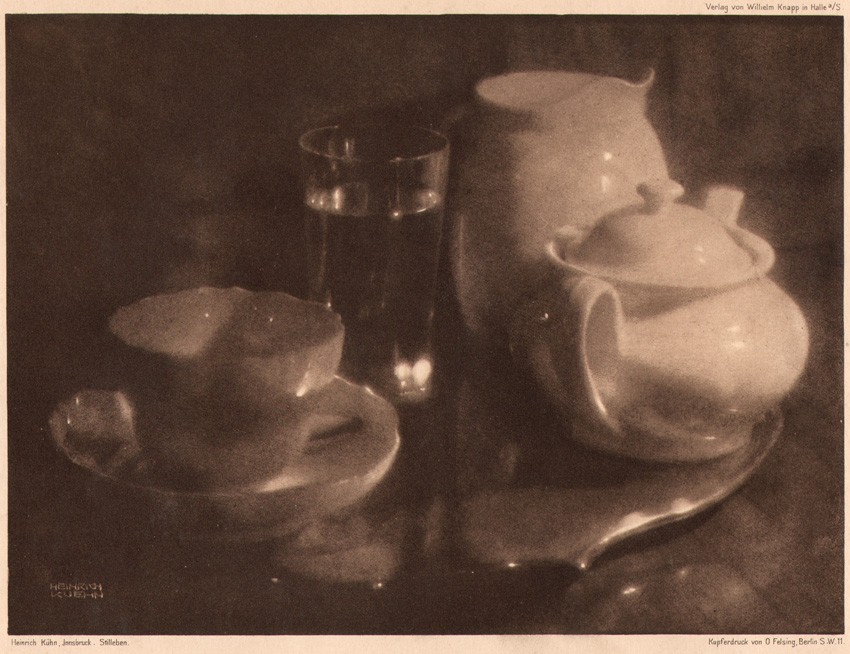 Tea Still-life, Version III (Teestilleben, III. Fassung) is a fine example of Kühn's still-life work showing his masterful control of light. Later reproduced as a hand-pulled photogravure by the Berlin atelier Otto Felsing and appearing in the January, 1908 issue of Photographische Rundschau , it was also most likely taken in one of his new home photographic studios on Richard Wagner Strasse, designed by Wiener Werkstätte founders Josef Hoffman and Koloman Moser. Image: (13.1 x 17.7 cm) from PhotoSeed Archive
Tea Still-life, Version III (Teestilleben, III. Fassung) is a fine example of Kühn's still-life work showing his masterful control of light. Later reproduced as a hand-pulled photogravure by the Berlin atelier Otto Felsing and appearing in the January, 1908 issue of Photographische Rundschau , it was also most likely taken in one of his new home photographic studios on Richard Wagner Strasse, designed by Wiener Werkstätte founders Josef Hoffman and Koloman Moser. Image: (13.1 x 17.7 cm) from PhotoSeed Archive
A contributor to and co-editor of the essential 2010 volume “Heinrich Kühn: The Perfect Photograph,” Faber can be seen in this video describing Kühn’s role in the development of artistic photography as well as his relationships with Alfred Stieglitz, who he first met in 1904 (Stieglitz had known of Kühn since 1894) and Edward Steichen in 1907, whose atmospheric work, we learn in the video, was inspired by some of Kühn’s massive (for the time) gum-bichromate photographs featuring sweeping and expansive Tyrolean landscapes.
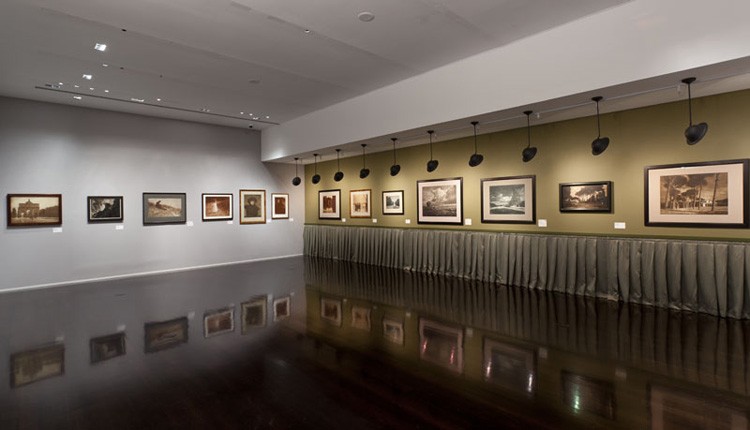 The 2nd gallery exhibition space, titled "Early Success", features a re-creation at far right of the 6th exhibition that took place at the Alfred Stieglitz gallery "291" on Fifth Avenue-from April 7-28, 1906. The Viennese and German photographers Heinrich Kühn, Hans Watzek and Hugo Henneberg-known as the Cloverleaf or Viennese Trifolium, all had vintage, massive frames on display. Photograph courtesy of the Neue Galerie.
The 2nd gallery exhibition space, titled "Early Success", features a re-creation at far right of the 6th exhibition that took place at the Alfred Stieglitz gallery "291" on Fifth Avenue-from April 7-28, 1906. The Viennese and German photographers Heinrich Kühn, Hans Watzek and Hugo Henneberg-known as the Cloverleaf or Viennese Trifolium, all had vintage, massive frames on display. Photograph courtesy of the Neue Galerie.
Not surprisingly, I soon discovered taking pictures is off-limits in the second and third floor exhibition rooms of the museum, which made it easier for me to scribble notes and not worry about the supplemental visuals for this post, most of which I’ve pulled from the PhotoSeed Archive. Emerging on the third floor, I first ducked into gallery 5 to take in a video narrated by Neue Galerie director Renée Price on Kühn’s pioneering 1907 involvement, along with Stieglitz and Steichen, with color Autochrome Lumière plates. I talked with the guard near the entrance who smiled when I asked how many times he had already seen it. Needless to say, he probably will not take the bait to see it again here on his day off, but you of course should.
 One of the original vintage framed photographs on display in the "Early Success" gallery was this landscape study titled "Twilight" (Dämmerung), which Kühn did in 1896. This hand-pulled Chine-collé photogravure version published in the important Austrian photographic journal Wiener Photographische Blätter in February, 1897 surely does the original an injustice: a bi-color gum bichromate print (enhanced with watercolor) that is certainly unique. Image: (15.6 x 11.8 cm) PhotoSeed Archive
One of the original vintage framed photographs on display in the "Early Success" gallery was this landscape study titled "Twilight" (Dämmerung), which Kühn did in 1896. This hand-pulled Chine-collé photogravure version published in the important Austrian photographic journal Wiener Photographische Blätter in February, 1897 surely does the original an injustice: a bi-color gum bichromate print (enhanced with watercolor) that is certainly unique. Image: (15.6 x 11.8 cm) PhotoSeed Archive
The show is arranged in five galleries, with a total of 105 vintage photographs in a variety of photographic media. In addition to the aforementioned work by Stieglitz and Steichen, Kühn’s fellow Viennese Trifolium partners Hans Watzek and Hugo Henneberg are also included, as well as select examples by Photo-Secession members Frank Eugene, Gertrude Kasebier, George Seeley and Clarence White.
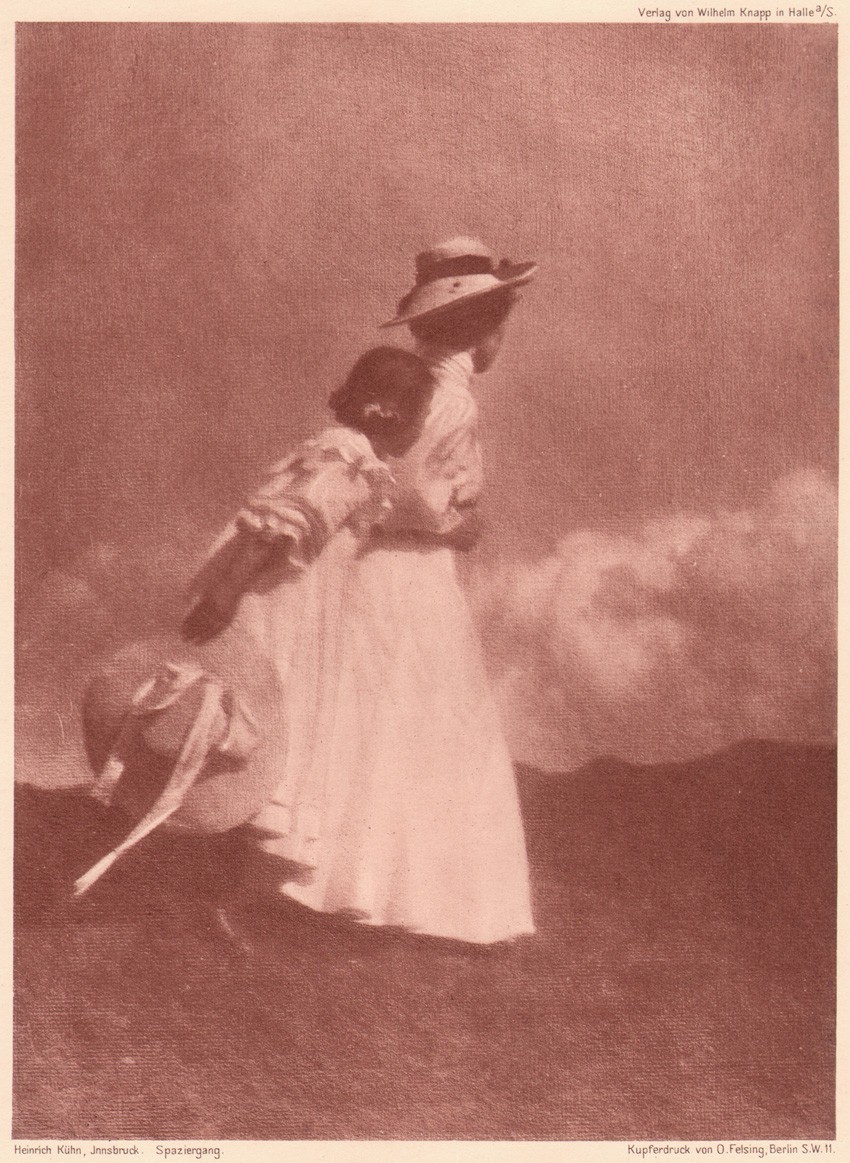 White Excursion, (Weiẞer Ausflug) from ca. 1905, is a fine early example of genre landscape study by Kühn incorporating his family members taken in the Tyrol. (most likely nanny Mary Warner and daughter Edeltrude) After the 1907 introduction to the public of Autochrome Lumière plates, he would create elaborate staged scenes similar to this but with specially made clothing worn by his models in order to take advantage of the added color dimension. Image: from September, 1908 issue of Photographische Rundschau: ( 17.7 x 13.1 cm) PhotoSeed Archive
White Excursion, (Weiẞer Ausflug) from ca. 1905, is a fine early example of genre landscape study by Kühn incorporating his family members taken in the Tyrol. (most likely nanny Mary Warner and daughter Edeltrude) After the 1907 introduction to the public of Autochrome Lumière plates, he would create elaborate staged scenes similar to this but with specially made clothing worn by his models in order to take advantage of the added color dimension. Image: from September, 1908 issue of Photographische Rundschau: ( 17.7 x 13.1 cm) PhotoSeed Archive
The two galleries I found most fascinating were the 4th gallery, which the museum assigns the collective title “Family Drama” and the 2nd gallery, called “Early Success”. In Family Drama, a massive, dark cherry-stained wood lattice panel forms the backdrop along one wall which has been installed specially for this exhibit. According to a museum guard, the panel blocks large windows overlooking Fifth Ave. The prop is a subtle and welcome touch for those familiar with some of Kühn’s portrait work, which often balances expanses of dark (the paneled background) with select highlights for the figure posed in front of it.
 There were several examples of original vintage prints taken by American Photo-Secession founder member Frank Eugene (1865-1936) included in the show, in order to show Kühn's active participation in and acceptance by the upstart Photo-Secession (founded 1902) in America. In this study taken in 1907 by Eugene, who can be seen at far left of frame, Alfred Stieglitz, Heinrich Kühn and Edward Steichen (far right) examine Eugene's photographic work. Detail: platinum print, Yale Collection of American Literature: from: Wikimedia Commons
There were several examples of original vintage prints taken by American Photo-Secession founder member Frank Eugene (1865-1936) included in the show, in order to show Kühn's active participation in and acceptance by the upstart Photo-Secession (founded 1902) in America. In this study taken in 1907 by Eugene, who can be seen at far left of frame, Alfred Stieglitz, Heinrich Kühn and Edward Steichen (far right) examine Eugene's photographic work. Detail: platinum print, Yale Collection of American Literature: from: Wikimedia Commons
According to a caption in this gallery, these panels were originally intended to be moved around as part of a photographic studio, and were (presumably) designed by Wiener Werkstätte founders Josef Hoffman and Koloman Moser for Kühn’s Innsbruck home located on Richard Wagner Street, where he lived with his children and English nanny Mary Warner from 1906-1919 (another studio in the home featured white paneling). Kühn’s ability to move the panels depending on exterior lighting conditions-from windows, skylights, and reflected means-were a way of giving his portrait backdrops a distinctive style. A means to an end in order for him to maintain fastidious control of his pictorial output.
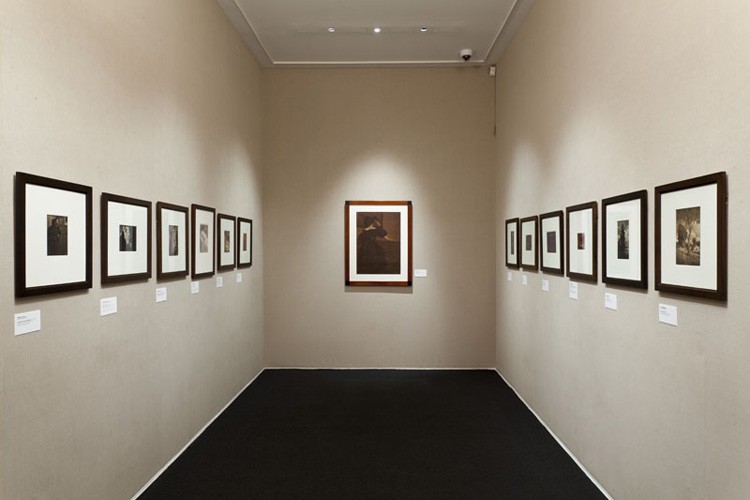 The 3rd gallery exhibition space was the smallest, and was an homage to the importance of the American Photo-Secession journal Camera Work, edited and published by Alfred Stieglitz. Seen here on both sides are all twelve vintage select plates from the journal as well as a framed gum bichromate photograph: "Anna with Mirror" done by Kühn in 1902 and later published in Camera Work XIII in 1906. Photograph courtesy of the Neue Galerie.
The 3rd gallery exhibition space was the smallest, and was an homage to the importance of the American Photo-Secession journal Camera Work, edited and published by Alfred Stieglitz. Seen here on both sides are all twelve vintage select plates from the journal as well as a framed gum bichromate photograph: "Anna with Mirror" done by Kühn in 1902 and later published in Camera Work XIII in 1906. Photograph courtesy of the Neue Galerie.
Speaking of control, another photographic caption in this gallery stated Kühn went so far as to have special clothing tailored in hues of black, white and gray for his children to wear while they posed for these portraits. Later, this also applied after 1907, but with colored clothing worn by them as well as Mary Warner while he made some of his most famous images in outdoor settings using the brand-new Autochrome Lumière plates.
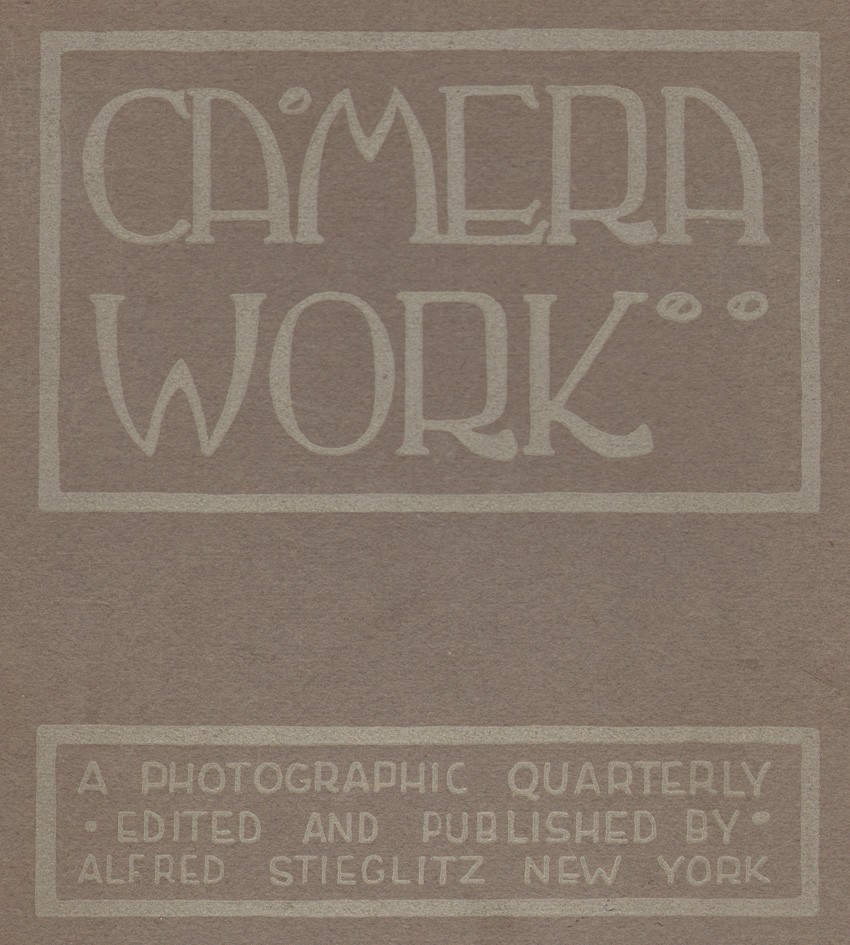 The distinctive cover of "Camera Work" featured Art-Nouveau typography done by American Photo-Secession founder member Edward Steichen, who was also an accomplished painter at the time he hand-designed the lettering sometime in 1902 before traveling to Paris to live and study. Detail of entire cover shown. top: logo: (8.6 x 14.0 cm) PhotoSeed Archive
The distinctive cover of "Camera Work" featured Art-Nouveau typography done by American Photo-Secession founder member Edward Steichen, who was also an accomplished painter at the time he hand-designed the lettering sometime in 1902 before traveling to Paris to live and study. Detail of entire cover shown. top: logo: (8.6 x 14.0 cm) PhotoSeed Archive
Walking over to the adjoining 2nd gallery, Early Success, the idea of gallery repetition is repeated along the long dimension of the space. Here, the idea of the famous Stieglitz “291” gallery is hinted at, with pleated, olive-drab fabric lining the lower portion of the wall while early 20th century reproduction period spotlights are aimed toward massive examples of colored and monochrome gum-bichromate prints.
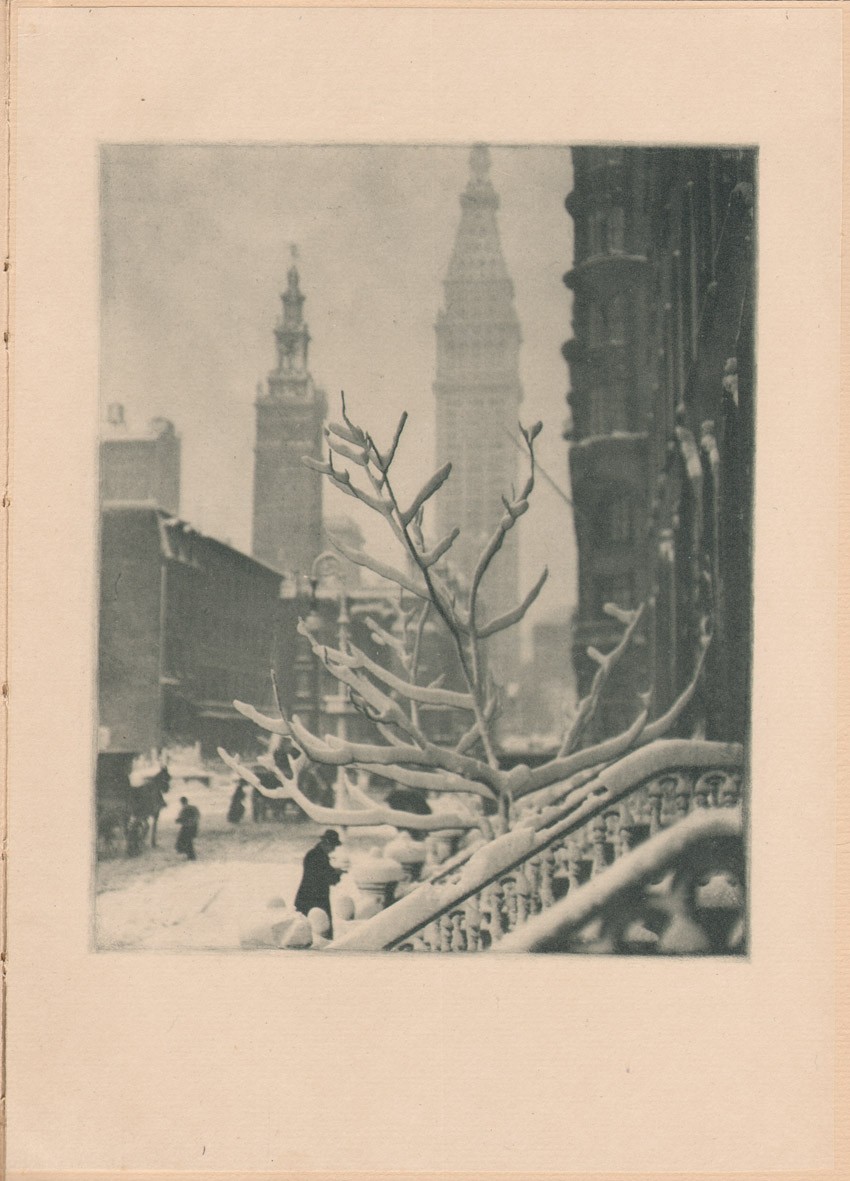 One of Alfred Stieglitz's signature New York photographs is "Two Towers — New York", a cityscape taken in 1911 showing his masterful balancing of shades of gray in a complex urban environment. The following description appears in "The Key Set", volume 1: "The view looks south from a stoop on the west side of Madison Avenue, toward the towers of Madison Sqaure Garden (left) and the Metropolitan Life Building (right)." This plate, with full support shown, from Camera Work XLIV, 1913 (image: 20.5 x 16.0 cm | support: 28.1 x 20.0 cm ) From: PhotoSeed Archive
One of Alfred Stieglitz's signature New York photographs is "Two Towers — New York", a cityscape taken in 1911 showing his masterful balancing of shades of gray in a complex urban environment. The following description appears in "The Key Set", volume 1: "The view looks south from a stoop on the west side of Madison Avenue, toward the towers of Madison Sqaure Garden (left) and the Metropolitan Life Building (right)." This plate, with full support shown, from Camera Work XLIV, 1913 (image: 20.5 x 16.0 cm | support: 28.1 x 20.0 cm ) From: PhotoSeed Archive
As I counted 29 framed prints in this room alone, the 291 wall is intended to showcase an approximation of the actual work (loaned from the Stieglitz bequeath at the Metropolitan as well as other institutional and private collections) from Viennese Trifolium members Kühn, Henneberg and Watzek. It was truly an extraordinary moment to be able to see these large-scale photographs up close, further elucidated on for their time as follows in a gallery caption:
The scale of the prints themselves may have convinced a broader public that photographs might be an artistic medium in its own right.
Kühn of course was the star in this room, with some of his earlier successes shown dating to the mid 1890’s. The cloverleaf Trifolium ceased to exist after 1903, once Watzek died and Henneberg soon turned his attention to etching.
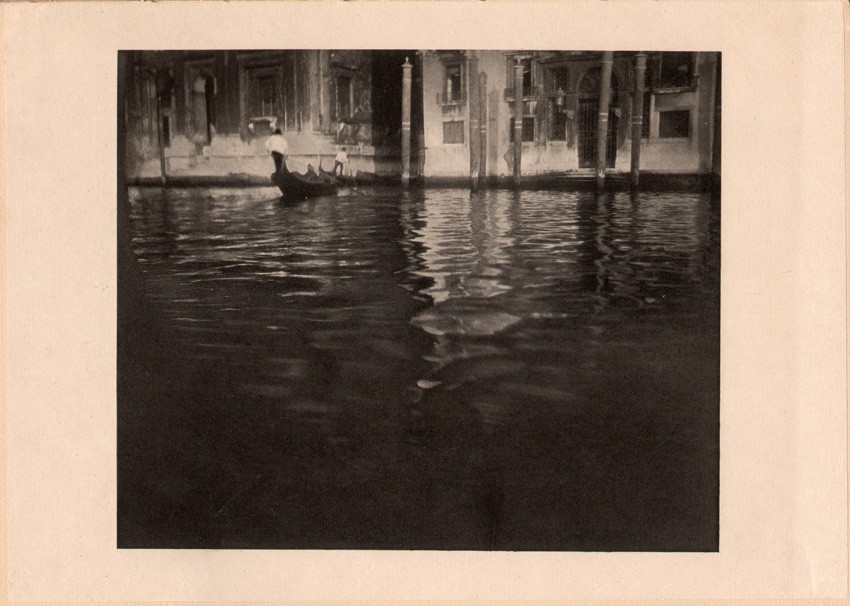 In the same year (1907) Heinrich Kühn had sat down with Stieglitz, Edward Steichen and Frank Eugene to discuss their work, Steichen's own exploration of shades of gray by means of the the camera took shape in this waterway study of a gondolier navigating a Venetian waterway. Initially titled "Late Afternoon - Venice", the work was first published in the Steichen number of Camera Work 42/43 (1913) as a duogravure before Stieglitz had it reprinted as a hand-pulled photogravure on Japan tissue for Camera Work 44, (1913) where it was simply titled "Venice". This plate, with full support shown, from Camera Work XLIV, 1913 (image: 16.7 x 20.1 cm | support: 19.9 x 28.0 cm ) From: PhotoSeed Archive
In the same year (1907) Heinrich Kühn had sat down with Stieglitz, Edward Steichen and Frank Eugene to discuss their work, Steichen's own exploration of shades of gray by means of the the camera took shape in this waterway study of a gondolier navigating a Venetian waterway. Initially titled "Late Afternoon - Venice", the work was first published in the Steichen number of Camera Work 42/43 (1913) as a duogravure before Stieglitz had it reprinted as a hand-pulled photogravure on Japan tissue for Camera Work 44, (1913) where it was simply titled "Venice". This plate, with full support shown, from Camera Work XLIV, 1913 (image: 16.7 x 20.1 cm | support: 19.9 x 28.0 cm ) From: PhotoSeed Archive
Finally, in the third gallery, a bridge for how Kühn and his contemporaries were embraced and given credibility in the form of 12 select images from the Alfred Stieglitz journal Camera Work are shown. The small room is further anchored on one side by a large gum-bichromate print titled Anna with Mirror, a 1902 genre study by Kühn showing a young woman from behind fixing her hair while reflected in a mirror.
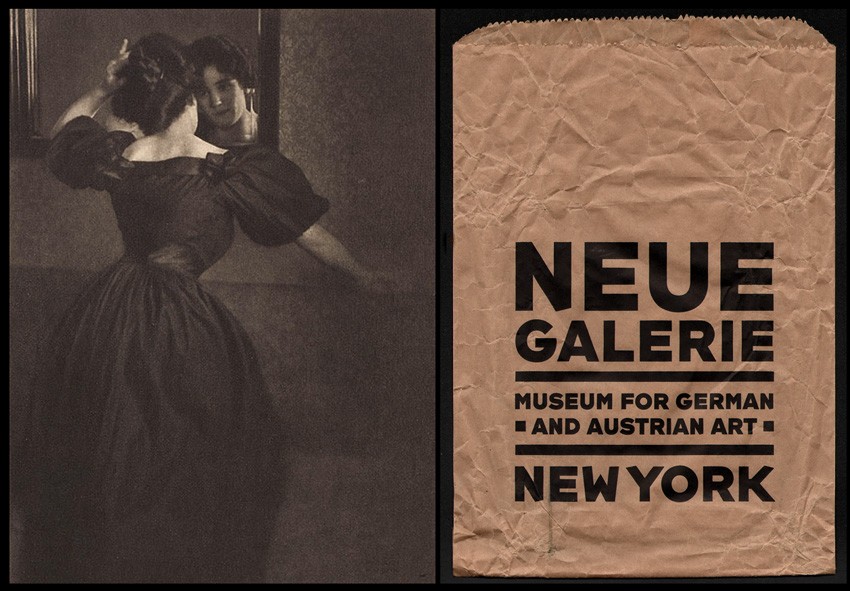 Left: "Anna with Mirror", taken by Kühn in 1902, was titled "Girl with Mirror" when Alfred Stieglitz included it as a photogravure plate in Camera Work XIII in 1906. A reproduction greeting card of the image was included in a boxed set purchased by this author from the Neue Galerie book store and carried home in the brown-paper bag at right, a fine example of modern typographic art for sure. Left: 19.5 x 14.4 cm: image courtesy: Photogravure.com Right: paper bag: 28.2 x 19.2 cm
Left: "Anna with Mirror", taken by Kühn in 1902, was titled "Girl with Mirror" when Alfred Stieglitz included it as a photogravure plate in Camera Work XIII in 1906. A reproduction greeting card of the image was included in a boxed set purchased by this author from the Neue Galerie book store and carried home in the brown-paper bag at right, a fine example of modern typographic art for sure. Left: 19.5 x 14.4 cm: image courtesy: Photogravure.com Right: paper bag: 28.2 x 19.2 cm
Reproduced by Stieglitz as a photogravure in Camera Work in 1906, the Neue Galerie chose to include a reproduction of it, along with five of Kühn’s other photographs, in an affordable set of greeting cards sold in their first floor gift shop: a nice memento and excuse for future correspondence procured by this visitor on my way out to Fifth Ave.